Altova first added support for charts and reporting the Altova MissionKit with the launch of Version 2011 last September. The v2011 reporting functionality includes options for line charts, 2D and 3D bar charts, 2D and 3D pie charts, round gauge and bar gauge charts. Here are a few examples: 
Advanced chart features in v2011r2
Version 2011 Release 2 of the Altova MissionKit, introduced on February 16, adds an exciting group of enhancements to the chart and reporting features in XMLSpy, StyleVision, and DatabaseSpy. The chart design options and user interface work the same way in all three applications, so MissionKit users can work intuitively and productively as they move from processing XML data in XMLSpy, to preparing charts for a business intelligence report with StyleVision, and even when they create graphical displays directly from SQL query results in DatabaseSpy. The wide range of new customizable charting features introduced in version 2011 release 2 includes:
- Stacked Bar charts
- Area charts
- Stacked Area charts
- Candlestick charts
- Chart overlays
- Background images and color gradients
- Ability to change position of axis labels
- And more!
Now you can create attractive and informative charts to represent a wide variety of data sets without exporting data to a dedicated charting application. Charts created using the Altova MissionKit are not limited to any specific presentation technology – for instance you can use StyleVision to include charts in HTML, Microsoft Word, RTF, or PDF documents, or you can save charts created in DatabaseSpy in a variety of image formats at the custom resolution you specify. In this post we will show some examples of the new charts and features available in all three MissionKit reporting and charting applications – XMLSpy, StyleVision, and DatabaseSpy.
Stacked bar charts
Stacked bar charts are a variation on bar chart presentation and are especially useful when multiple ranges of data need to be illustrated. Stacked bar charts are also useful to more clearly illustrate data in a smaller area. The image below shows a stacked bar chart to illustrate the performance of a sales team by region over two years  Note that the combined height of each stack in the Stacked Bar Chart represents the total sales over the two-year period for each Territory, since the sales for Last Year are added above the Year To Date numbers. Stacked bar charts complement regular bar charts and 3-D bar charts to offer users the greatest flexibility in illustrating SQL query results. If the user prefers horizontal bars, a checkbox labeled Draw X and Y exchanged in the Change Appearance tab selects that orientation.
Note that the combined height of each stack in the Stacked Bar Chart represents the total sales over the two-year period for each Territory, since the sales for Last Year are added above the Year To Date numbers. Stacked bar charts complement regular bar charts and 3-D bar charts to offer users the greatest flexibility in illustrating SQL query results. If the user prefers horizontal bars, a checkbox labeled Draw X and Y exchanged in the Change Appearance tab selects that orientation. 
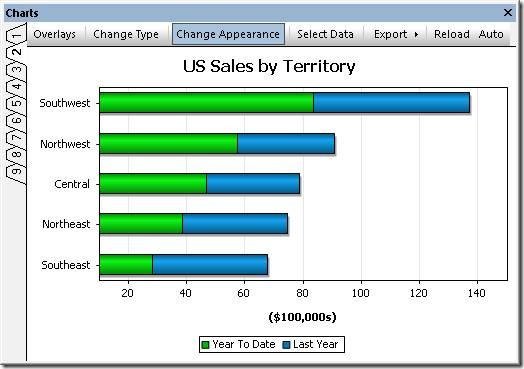 This orientation option is also available for other 2-D bar charts, line charts, area charts, and candlestick charts.
This orientation option is also available for other 2-D bar charts, line charts, area charts, and candlestick charts.
Area charts
Area charts are similar to line charts, with shading applied to make a more graphically appealing display. The area chart below shows a record of temperature and humidity changes by hour over the course of one day. Creative application of color can emphasize the point!  To successfully build an area chart, the analyst must consider the values in each data category. As the area chart is constructed, each category forms an opaque layer on top of the layers for data retrieved previously. In the case illustrated above, Temperature was always a larger number than Humidity, so a SQL query was constructed in DatabaseSpy to retrieve the Temperature value before Humidity to prevent Temperature from acting like a curtain to hide the Humidity data. However, if the data columns appear in a sequence with values in increasing order, the last layer would overlap and hide all the preceding layers. In that case, the chart tab heading titled Select Data lets the user add and delete columns from the results to re-sequence the data correctly. The Select Data column also lets the user edit the names assigned to each column on the X-axis label.
To successfully build an area chart, the analyst must consider the values in each data category. As the area chart is constructed, each category forms an opaque layer on top of the layers for data retrieved previously. In the case illustrated above, Temperature was always a larger number than Humidity, so a SQL query was constructed in DatabaseSpy to retrieve the Temperature value before Humidity to prevent Temperature from acting like a curtain to hide the Humidity data. However, if the data columns appear in a sequence with values in increasing order, the last layer would overlap and hide all the preceding layers. In that case, the chart tab heading titled Select Data lets the user add and delete columns from the results to re-sequence the data correctly. The Select Data column also lets the user edit the names assigned to each column on the X-axis label.  As alternative solution, the Transparency option in the Change Appearance tab lets the user adjust color levels to allow hidden layers to show through.
As alternative solution, the Transparency option in the Change Appearance tab lets the user adjust color levels to allow hidden layers to show through.
 |
Stacked area charts
As implied by their name, Stacked Area charts layer the columns of a data set to illustrate the overall sum of a data series. Stacked Area charts also eliminate the potential overlapping data problem that can occur with regular area charts. The chart below shows a table of air passenger revenue miles traveled by month, with individual regions for domestic and international travel. 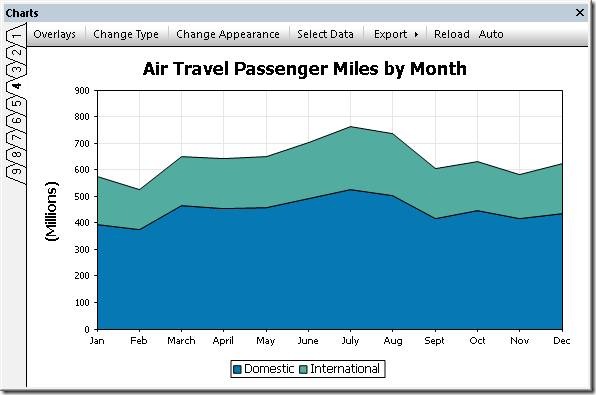 The Stacked Area chart creates a graphical representation of the total of Domestic and International miles, even though the total miles value was not part of the provided data. This is apparent at the top of the January entry, where the International region intersects the Y axis just below 600 (the original data showed 392 million Domestic miles and 181 million International miles, for a total of 573). A strategic data analyst will always consider the nature of the data to be reported when choosing any particular chart type. For instance in the weather example we used above, adding temperature and humidity values in a stacked bar chart would not be logical!
The Stacked Area chart creates a graphical representation of the total of Domestic and International miles, even though the total miles value was not part of the provided data. This is apparent at the top of the January entry, where the International region intersects the Y axis just below 600 (the original data showed 392 million Domestic miles and 181 million International miles, for a total of 573). A strategic data analyst will always consider the nature of the data to be reported when choosing any particular chart type. For instance in the weather example we used above, adding temperature and humidity values in a stacked bar chart would not be logical!
Candlestick charts
Candlestick charts were originally developed by a wealthy Japanese businessman who began trading at the local rice exchange around the year 1750. He kept records of the local market psychology, learning to boost his profits by carefully monitoring prices and not rushing into trades. Today, charts are used to represent financial data such as stock prices over a period of time. Every day the market is open, each stock has four relevant data points that can be rendered in a candlestick chart: the price at market opening, the price when the market closed, the high price during the day, and the low price during the day. Investors and financial analysts like to view these indicators to gauge the stock’s performance over a period of time. In the candlestick chart below, each solid bar represents the range between the opening and closing price and the thin vertical line through each bar shows the extent of the high and low prices for the day. 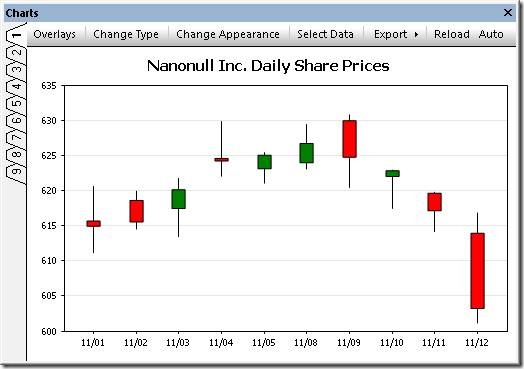 In this version of the chart, following common convention, the color of each bar signals whether the stock was up or down for the day. If the bar is green, the stock was up for the day– it opened at the price indicated by the bottom of the bar and closed at the price indicated by the top. If the stock was down for the day, the bar is red and the symbolism is reversed – the stock opened at the price indicated at the top of the bar and closed at the price shown by the bottom. Numerous options are available to set line and fill colors, the Y-axis range and values, and more. Because they were intended to be printed in black and white, the original candlestick charts used empty bars to indicate the price increased and solid bars to indicate price decreases. The Altova MissionKit offers this option:
In this version of the chart, following common convention, the color of each bar signals whether the stock was up or down for the day. If the bar is green, the stock was up for the day– it opened at the price indicated by the bottom of the bar and closed at the price indicated by the top. If the stock was down for the day, the bar is red and the symbolism is reversed – the stock opened at the price indicated at the top of the bar and closed at the price shown by the bottom. Numerous options are available to set line and fill colors, the Y-axis range and values, and more. Because they were intended to be printed in black and white, the original candlestick charts used empty bars to indicate the price increased and solid bars to indicate price decreases. The Altova MissionKit offers this option:  Another candlestick chart variation omits the opening price and simply illustrates the range by a vertical line and the closing price by a horizontal line. This option is automatically supported when a data set only includes the high, low, and closing prices.
Another candlestick chart variation omits the opening price and simply illustrates the range by a vertical line and the closing price by a horizontal line. This option is automatically supported when a data set only includes the high, low, and closing prices. 
Chart overlays
The Overlays feature lets you combine multiple charts in a single image. Each overlay chart has unique settings and can even be generated from a separate data file. The image below shows a candlestick chart of a stock’s daily prices with the daily sales volume in a bar chart overlay. 
Support for background images & color gradients
The ability to specify background color gradients and background images gives you even more flexibility for creating customized, eye-catching charts. Overlaying one chart on another lets you visualize multiple data sets with different Y-axes and types. 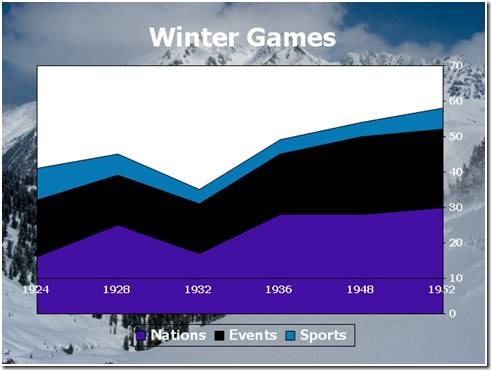 The Change Appearance dialog lets users select a background image, as in the Winter Games chart above, or apply a background color gradient, as in the Summer 2010 chart below.
The Change Appearance dialog lets users select a background image, as in the Winter Games chart above, or apply a background color gradient, as in the Summer 2010 chart below. 
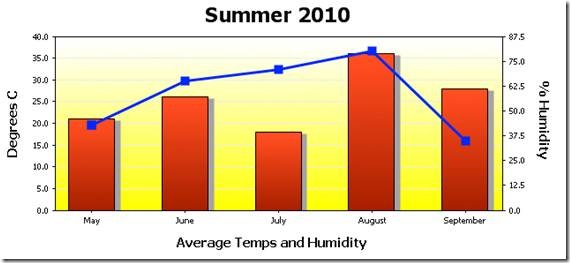 If you’d like to see for yourself how easy it is to use Altova tools to create attractive charts from XML and database data, download a free trial of the Altova MissionKit.
If you’d like to see for yourself how easy it is to use Altova tools to create attractive charts from XML and database data, download a free trial of the Altova MissionKit.
Get More Mileage from Your StyleVision Designs with Dynamic Selection of CSS Files
Although you can still manage virtually all formatting tasks from the StyleVision design itself, dynamic selection of CSS files means that you can create a single template for use in multiple situations. To demonstrate, we’ve created an invoice for the fictional Nanonull Corporation for which the design changes based on the number of days that have elapsed between the invoice issue date and the due date. Although we could have used XPath to change the formatting of each element based on the number of days that have elapsed, in this case it is more efficient to create individual CSS files that apply to different scenarios.
Below is the invoice that we designed in StyleVision. Notice that beyond the bold headings it is almost devoid of formatting – we’ll be applying formatting based on the number of days that have elapsed between the invoice issue date and the due date via CSS files.
Now we can create our CSS files in XMLSpy, Altova’s XML editor with integrated support for editing CSS2 and CSS3.
First we’ll create a CSS file for invoices with due dates after the invoice issue date (i.e., invoices that are not overdue). Here we’ve simply created the body selector with a yellowish background and the Nanonull logo and a header class.
Now let’s look at the same invoice with a due date in the future – note the yellow background, Nanonull logo, and that “Invoice” and the due date appear in black.
XML Editor Supports HTML5 and CSS3
The Altova MissionKit Web tools received an important update with our recent Version 2012 release: support for HTML5 and CSS3. You’ll find support updated to include the most recent versions of these Web standards in both XMLSpy 2012 (and higher) for code editing and StyleVision 2012 for graphical stylesheet and report design.

Let’s focus on the HTML5 and CSS3 editors in XMLSpy here – StyleVision functionality will be covered in a future article.
HTML5 Editor
XMLSpy has long supported editing of HTML4 and, of course, XHTML – and now those intelligent coding features extend to HTML5.
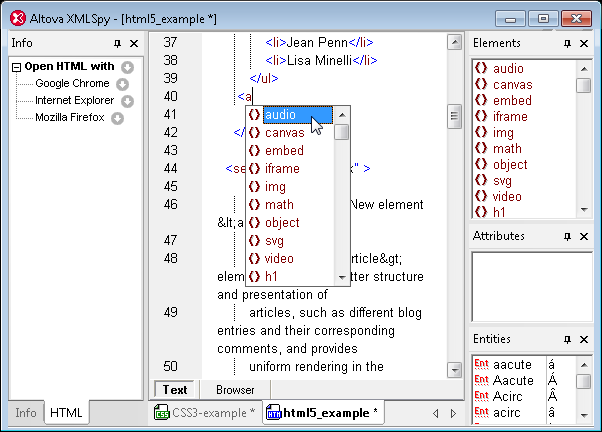
If you’re already an XMLSpy user, you’ll immediately recognize the helpful syntax coloring, source folding, and line numbering in advanced Text View when you open your HTML5 file for editing. As you type, you’re presented with valid HTML5 element and attribute choices in a drop down menu as well as in static entry helper windows, so you can complete code in your preferred working style. At the same time, code completion helps you work faster while ensuring elements are closed properly.
These intelligent editing features are applicable to the version of HTML you’re working with – when you open an existing HTML5 document or start a new file from scratch, all the HTML5 elements and attributes are immediately available in the entry helper windows and drop down menu. Some of the most notable new elements in HTML5 include:
XMLSpy includes an integrated Browser View that lets you see the results of your HTML5 coding immediately. The Browser View renders your page using your installation of Internet Explorer directly in XMLSpy…


…but also allows you to immediately view your HTML5 Web page in an instance of any browser you have installed on your machine.
This allows for quick testing and debugging to ensure cross-browser compatibility.
To get an idea of how some of the new HTML5 features look in action, check out the simple HTML5 example document that is supplied in the XMLSpy 2012 Examples folder and linked from the Example project. To learn more about HTML, there are many excellent resources on the Web, including http://www.w3.org/TR/html5/.
CSS3 Editor
Working hand-in-hand with the HTML5 editor is the XMLSpy CSS3 editor, which also provides syntax coloring and entry helpers, as well as bookmarking and source folding in Text View.
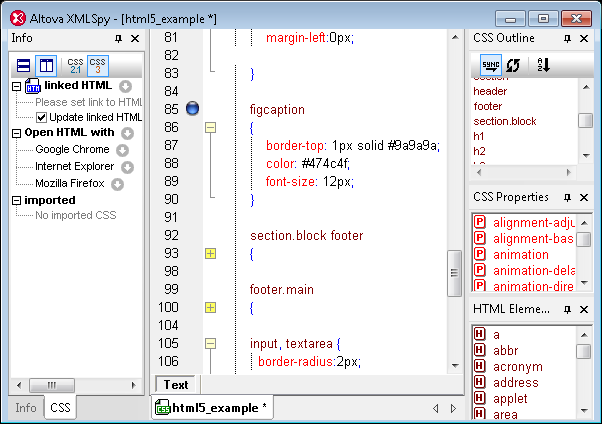
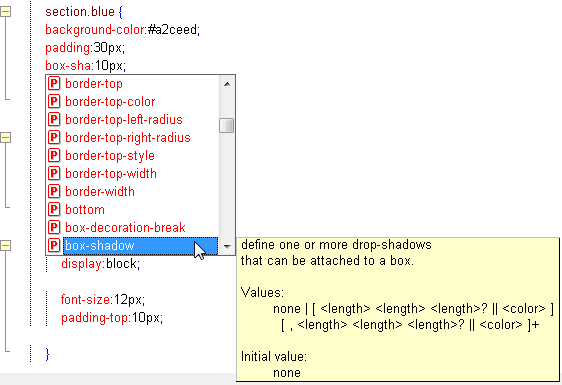
A CSS Outline window displays an outline of the document organized by its selectors listed in groups. Each group can be collapsed and expanded, and clicking a selector in the CSS Outline highlights it in the document. CSS Properties and HTML elements entry helpers are shown in windows as well as context sensitive drop-down menus, and XMLSpy even includes screen tips that provide a definition of each property and its possible values as you type.
You can take advantage of XMLSpy’s integrated Browser View here, too, to see the results of your CSS edits immediately in a linked HTML page.
Why XMLSpy for HTML?
Sure, XMLSpy is known for all things XML, but it’s also a clear choice for HTML development. HTML5 and CSS3 editing in XMLSpy is facilitated by support for related technologies including XML, XSLT, WSDL, and others, as well as integrated project management functionality, support for popular version/source control systems, and Microsoft® SharePoint® Server integration – giving you all the tools you need to develop the next generation of Web sites and apps.
We’d love to hear how you’re using HTML5 now – please drop us a line by leaving a comment below.
New in StyleVision 2012 – Composite Styles for Enhanced Formatting
One of the more versatile features introduced in StyleVision 2012 is support for composite styles for output to RTF, Word, and PDF as well as HTML and Authentic electronic forms. This feature allows you to combine styles defined in an XML instance document with those you set in the report itself. You can also build a composite with XPath to control multiple style features of the same design element (e.g., font, background color, alignment).
Support for composite styles means that you can quickly and easily change the look of a design component by selecting an attribute from the XML instance file or by changing the XPath expression. This feature is used most often in cases where the XML document includes HTML fragments that contain style information – now you can use an XPath selector to extract style information from the HTML fragment and apply it directly to an output document.
Here for example we’ve used XMLSpy, Altova’s XML editor and development environment, to create an XML instance file containing the contents of a music library. (We also created the Schema in XMLSpy.)
The StyleIt attribute of the Recording element pictured below includes formatting instructions for this individual recording – according to our file the Fun Factory recording should be red and bolded.
Now we can move to StyleVision and start creating a design based on our XML instance document.
All we need to do to apply the formatting instructions in the XML instance document is to call the StyleIt attribute from the composite style drop down in the Properties pane in our StyleVision design.
The Fun Factory recording appears in red bold in the resulting output.
We can also choose to ignore the formatting instructions from the instance file and provide our own.
Here we’ve replaced the StyleIt attribute in the drop down list with an XPath if-then-else statement that assigns formatting based on an attribute of the Recording element called PlaylistCode – party tunes are in blue Papyrus 12 point font, easy listening favorites are in maroon Pristina 14 point font, and background music by default is in green Onyx 14 point font.
Here’s what the output file looks like now.
Support for composite styles is only one of the new styling features in the StyleVision 2012 stylesheet and report designer. Click here to read more about the new features across the entire Altova product line.
Have you used created a great project using the StyleVision stylesheet and report designer or any of Altova’s other tools? Want to show it off? Please share your story with other Altova users by commenting on this blog post. If you think it would make a great case study please visit the Altova case studies page – if we use your story you’ll receive a $200 Amazon gift card. We’d love to hear from you!
Announcing Altova FlowForce® Server Beta 1
Altova FlowForce® Server Beta 1 is an exciting new tool for execution of automated data mappings designed to provide comprehensive management and control over data transformations performed by dedicated high-speed servers, virtual machines, or even regular workstations, depending on the size of the task. To gather user input and accelerate product development, Altova is offering Altova FlowForce Server Beta 1 as a free public beta test to all licensed users of Altova MapForce® 2012 Enterprise Edition and MapForce® 2012 Professional Edition. Users employ Altova MapForce data mappings for two different types of data transformations:
While command-line execution, royalty-free code generation, and the MapForce API can assist with automation of repeated transformations, FlowForce Server Beta 1 provides much greater power and flexibility. FlowForce Server Beta 1 is a server-based tool with a Web interface that makes it much easier to implement, manage, or modify data transformation jobs in a busy data processing environment. FlowForce Server Beta 1 can administer multiple transformation jobs simultaneously, lets users define and adjust a variety of job triggers and actions on the fly, can perform housekeeping tasks like moving output files or cleaning up intermediate work, records detailed logs of all activity, and much more. FlowForce Server Beta 1 consists of four components that work together as illustrated in the diagram below.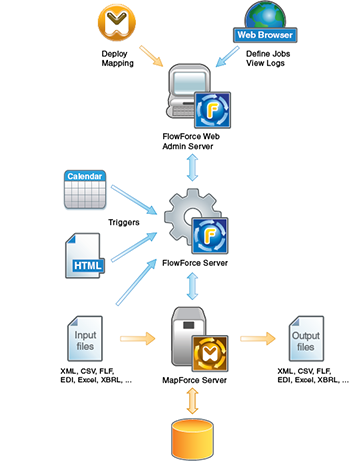 The FlowForce Server continuously checks for trigger conditions, starts and monitors job execution, and writes detailed logs. MapForce Server is an implementation of the MapForce Built-in execution engine that executes mapping packages previously deployed via the MapForce graphical environment. The FlowForce Web Administration Interface is a standalone web application that runs in an internet browser and provides the front-end of FlowForce Server. MapForce Beta is an enhanced version of the Altova MapForce application with an integrated deployment feature to deploy MapForce data mappings to a FlowForce server package. Altova FlowForce Server Beta 1 is available immediately as a free public beta test to all licensed users of Altova MapForce® 2012 Enterprise Edition and MapForce® 2012 Professional Edition. Visit the FlowForce Server Beta 1 page at the Altova Web site for more information!
The FlowForce Server continuously checks for trigger conditions, starts and monitors job execution, and writes detailed logs. MapForce Server is an implementation of the MapForce Built-in execution engine that executes mapping packages previously deployed via the MapForce graphical environment. The FlowForce Web Administration Interface is a standalone web application that runs in an internet browser and provides the front-end of FlowForce Server. MapForce Beta is an enhanced version of the Altova MapForce application with an integrated deployment feature to deploy MapForce data mappings to a FlowForce server package. Altova FlowForce Server Beta 1 is available immediately as a free public beta test to all licensed users of Altova MapForce® 2012 Enterprise Edition and MapForce® 2012 Professional Edition. Visit the FlowForce Server Beta 1 page at the Altova Web site for more information!
Processing the Groupon API – Epilogue
Rare edge cases can derail loosely coupled data mapping applications. This is especially true when you are consuming large datasets available over the Internet and have little or no influence over the source data. In this article we describe a debugging technique that lets developers working on data mapping and transformation projects quickly identify and accommodate unexpected data in a stream from a remote source. The Problem Last summer we wrote a series of blog posts describing how to work with the Groupon API to retrieve a subset of offers in all Groupon cities and format the list for a web browser or mobile device. We concluded with a command line to run a MapForce data mapping that calls the Groupon API over 150 times — once for each Groupon city, then filters the data to extract deals sold on the Internet instead of a physical location, and formats the results in HTML using StyleVision. Every morning we run the command line in a batch file that saves the HTML output on a local server so our colleagues can check it out with any Web browser to find interesting offers from all over the country. The mapping ran fine for more than two months until one day it failed with this error message: “Source-value “” of type dateTime could not be converted into target-type dateTime.” The specific explanation is that somewhere in the mapping where we expected a dateTime, we received an empty value. On a more abstract level, the error suggests a potential defect in the logic of our mapping strategy. Every time we call the Groupon API we receive a well-formed XML data stream enclosed in a <response> element, but the API specs do not include an XML Schema defining the data that may be returned. When we developed our mapping we needed to analyze the raw data and select the output we wanted, so our first step was to call the API to capture all the Groupon deals for one large metro area. We assumed we would get a large enough data sample to include every possible option in the API response. After our mapping ran successfully for two months, the API finally delivered a rare edge case that did not fit the pattern we expected. Debugging Tools MapForce provides debugging help. We can run our data mapping using the MapForce built in execution engine to see more details in the Messages window.
We concluded with a command line to run a MapForce data mapping that calls the Groupon API over 150 times — once for each Groupon city, then filters the data to extract deals sold on the Internet instead of a physical location, and formats the results in HTML using StyleVision. Every morning we run the command line in a batch file that saves the HTML output on a local server so our colleagues can check it out with any Web browser to find interesting offers from all over the country. The mapping ran fine for more than two months until one day it failed with this error message: “Source-value “” of type dateTime could not be converted into target-type dateTime.” The specific explanation is that somewhere in the mapping where we expected a dateTime, we received an empty value. On a more abstract level, the error suggests a potential defect in the logic of our mapping strategy. Every time we call the Groupon API we receive a well-formed XML data stream enclosed in a <response> element, but the API specs do not include an XML Schema defining the data that may be returned. When we developed our mapping we needed to analyze the raw data and select the output we wanted, so our first step was to call the API to capture all the Groupon deals for one large metro area. We assumed we would get a large enough data sample to include every possible option in the API response. After our mapping ran successfully for two months, the API finally delivered a rare edge case that did not fit the pattern we expected. Debugging Tools MapForce provides debugging help. We can run our data mapping using the MapForce built in execution engine to see more details in the Messages window.  The lines labeled Related location are hyperlinked back to components in the mapping where the error occurred. Clicking on the result error takes us to a format-dateTime function.
The lines labeled Related location are hyperlinked back to components in the mapping where the error occurred. Clicking on the result error takes us to a format-dateTime function. 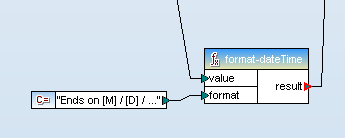 We can either click the “” error or trace the value connector to identify the input element to the format-dateTime function. Either way, we locate the element that triggered the error.
We can either click the “” error or trace the value connector to identify the input element to the format-dateTime function. Either way, we locate the element that triggered the error. 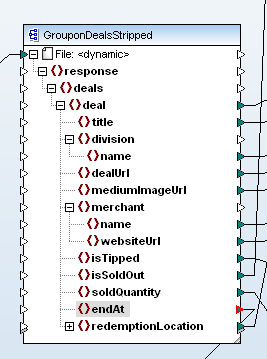 The suspect element resides in the input component that captures all the data returned by our calls to the Groupon API before any filtering or conversion takes place. When we designed the mapping, the endAt element in our sample data always reported the ending date and time for each Groupon offer, but for some reason we must have received an empty value in this field. If the error had occurred by running a local input file we could simply examine the file contents, but in this case the data came from multiple URLs, and is only held temporarily until it is mapped to the output component. Fortunately, we can apply a trick to easily modify the mapping and preserve all data received from the Groupon API. We simply copy the input component and paste a duplicate into the mapping. We can connect the response element from the original to the duplicate, which simultaneously maps all the child elements between the components.
The suspect element resides in the input component that captures all the data returned by our calls to the Groupon API before any filtering or conversion takes place. When we designed the mapping, the endAt element in our sample data always reported the ending date and time for each Groupon offer, but for some reason we must have received an empty value in this field. If the error had occurred by running a local input file we could simply examine the file contents, but in this case the data came from multiple URLs, and is only held temporarily until it is mapped to the output component. Fortunately, we can apply a trick to easily modify the mapping and preserve all data received from the Groupon API. We simply copy the input component and paste a duplicate into the mapping. We can connect the response element from the original to the duplicate, which simultaneously maps all the child elements between the components. 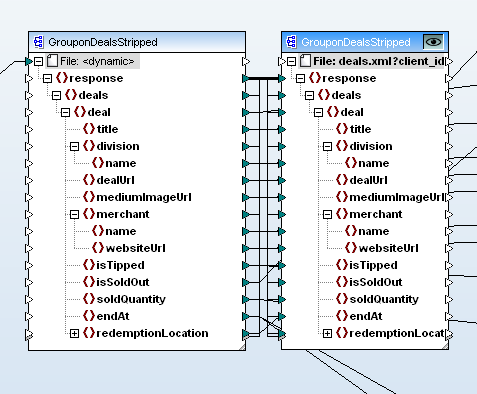 Our original input component is now connected to two output components. We can select which output component will be generated by the MapForce built-in execution engine by clicking the eye icon at the top right corner of any output component. The new output component simply saves a copy of everything in the input component. When we examine the raw data using XMLSpy, sure enough we find an empty element where we expected a date and time:
Our original input component is now connected to two output components. We can select which output component will be generated by the MapForce built-in execution engine by clicking the eye icon at the top right corner of any output component. The new output component simply saves a copy of everything in the input component. When we examine the raw data using XMLSpy, sure enough we find an empty element where we expected a date and time:  The Solution Now that we know an offer might have no specific end time, we can plan for that possibility in the mapping. In the revised treatment of the endAt element, we do an if-test before the original format-dateTime function and provide an alternate output when the endAt element is empty.
The Solution Now that we know an offer might have no specific end time, we can plan for that possibility in the mapping. In the revised treatment of the endAt element, we do an if-test before the original format-dateTime function and provide an alternate output when the endAt element is empty.  We had to work fast because all Groupon data is time sensitive. The edge case would eventually expire and disappear from the data stream. This experience showed us how important it is to have powerful debugging tools and to use them creatively, even after you think a data mapping project is running successfully! Altova MapForce is available in a free trial – the next edge case you solve could be your own. Editor’s Note: Our original series on mapping data from the Groupon API ran in three parts you can see by clicking the links here: Part 1 of Processing the Groupon API with Altova MapForce describes how to create dynamic input by collecting data from multiple URLs. Processing the Groupon API with MapForce – Part 2 describes how we filtered data from the API and defined the output to extract only the most interesting details. Processing the Groupon API – Part 3 describes formatting the output as a single HTML document optimized for desktop and mobile devices, and reviews ways to automate repeat execution.
We had to work fast because all Groupon data is time sensitive. The edge case would eventually expire and disappear from the data stream. This experience showed us how important it is to have powerful debugging tools and to use them creatively, even after you think a data mapping project is running successfully! Altova MapForce is available in a free trial – the next edge case you solve could be your own. Editor’s Note: Our original series on mapping data from the Groupon API ran in three parts you can see by clicking the links here: Part 1 of Processing the Groupon API with Altova MapForce describes how to create dynamic input by collecting data from multiple URLs. Processing the Groupon API with MapForce – Part 2 describes how we filtered data from the API and defined the output to extract only the most interesting details. Processing the Groupon API – Part 3 describes formatting the output as a single HTML document optimized for desktop and mobile devices, and reviews ways to automate repeat execution.
Analyze Football Statistics using the Altova MissionKit
In this article we use stats from NFL.com and ESPN.com to show how easy it can be to process and analyze online data in new ways – even when it uses different metrics and is only available in textual format. We have seen in previous blog posts how easy it is to gather data from the Internet that is widely available in XML formats. But what about interesting data that is available online but not in an XML format, or data that is buried in legacy data processing systems and only available in textual report format? One such example involves quarterback ratings. The NFL has used a Passer Rating that rates quarterbacks solely based on a passer’s completions, attempts, touchdowns, and interceptions. ESPN introduced a new rating system this year called the Total QBR (Quarterback Rating). The Total QBR incorporates more data, including an expected points average and a clutch play index, that ESPN claims gives a more accurate measure of a quarterback’s performance. Let’s compare the rankings that these system produce to see if we can garner some useful information. For this example we’ll be using the data importing and analysis tools of the Altova MissionKit to compare the ratings. If you want to try this out yourself, the MissionKit is available to download for a 30 day free trial from the Altova web site. You can access the files used in this example here. The first thing we need is the raw data to analyze. Let’s use the entire 2010 season as a data source. We can get the table with Passer Ratings from NFL.com and then copy and paste it as a new text file.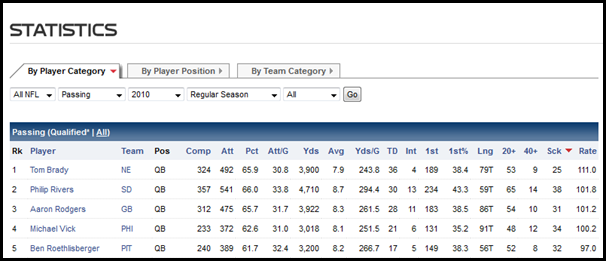 We can access a similar table of Total Quarterback Ratings from the ESPN web site and create a second text file.
We can access a similar table of Total Quarterback Ratings from the ESPN web site and create a second text file.  We now have two text files with tables of data in different orders. The next step is to combine the tables into one file and generate charts. First, we need a schema file for the destination of the data. In XMLSpy, we can create an XSD file quickly, and graphically, to contain a series of QB nodes with child nodes of first and last name, team, passer rating and rank, and total QBR and rank.
We now have two text files with tables of data in different orders. The next step is to combine the tables into one file and generate charts. First, we need a schema file for the destination of the data. In XMLSpy, we can create an XSD file quickly, and graphically, to contain a series of QB nodes with child nodes of first and last name, team, passer rating and rank, and total QBR and rank. 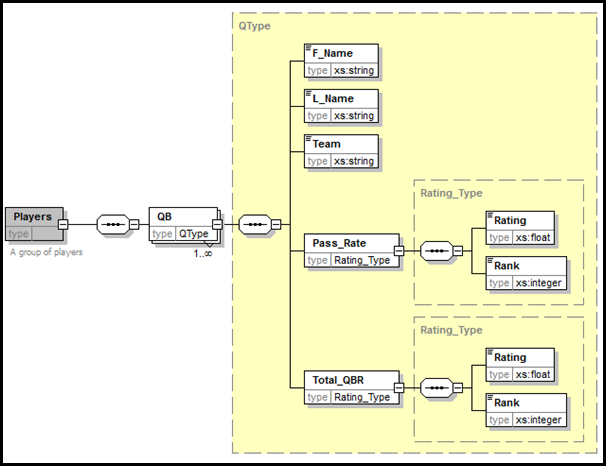 Now, in MapForce, we open the text documents and use FlexText to parse the text and change it into a list of categories.
Now, in MapForce, we open the text documents and use FlexText to parse the text and change it into a list of categories. 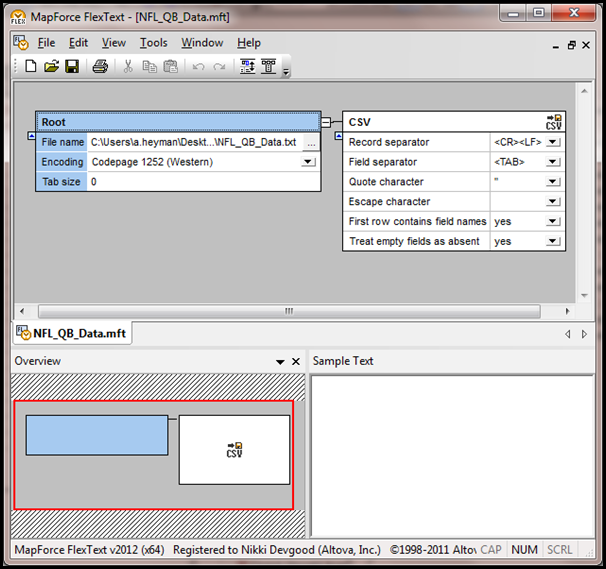
 We then build a mapping file in MapForce to map the data from the text files to the destination XML file. Built-in functions make it easy to extract the first and last names from the Player string, and a value-map will change the team abbreviation to a string (ARI is changed to Arizona Cardinals, ATL to Atlanta Falcons, etc.). We set the Priority Context in the test of our filters to make sure we get the correct set of data for each unique quarterback.
We then build a mapping file in MapForce to map the data from the text files to the destination XML file. Built-in functions make it easy to extract the first and last names from the Player string, and a value-map will change the team abbreviation to a string (ARI is changed to Arizona Cardinals, ATL to Atlanta Falcons, etc.). We set the Priority Context in the test of our filters to make sure we get the correct set of data for each unique quarterback. 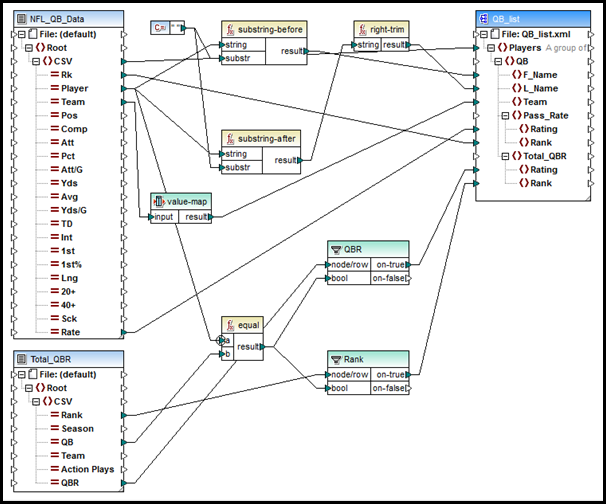 Once we execute the mapping, we can save the resulting XML data file and use it as the source file in StyleVision to design a stylesheet. In this stylesheet, we create a table of the top ten ranked passers and charts showing the Passer Rating and the Total QBR graphically.
Once we execute the mapping, we can save the resulting XML data file and use it as the source file in StyleVision to design a stylesheet. In this stylesheet, we create a table of the top ten ranked passers and charts showing the Passer Rating and the Total QBR graphically. 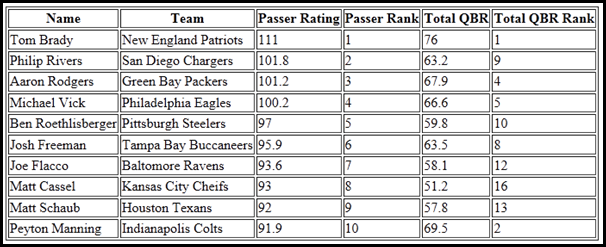
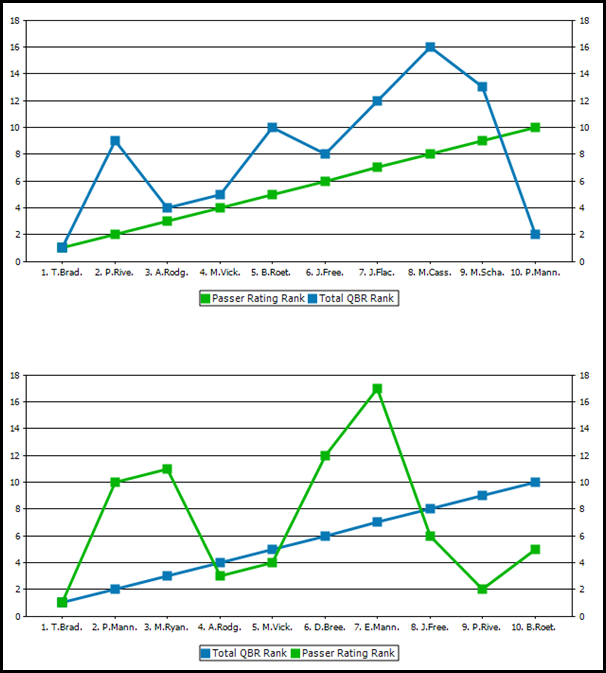 Now that we have a visual representation of the rankings of the two rating systems, we can examine their differences and try to see which works better. For example, Peyton Manning was tenth in passer rating, but was second in Total QBR. This can be explained by the Total QBR taking clutch points into account and knowing that Peyton Manning had a few late game comebacks in the 2010 season. Since we now have a collection of files (the XSD file built in XMLSpy, the FlexText and mapping files from MapForce, and the stylesheet design created in StyleVision), we can update the text data files easily to analyze new sets of quarterback data. Later in the season, we can update the text tables with 2011 data, and allow the data to flow through the mappings and into the stylesheet to update the charts and see the rankings for the current season. This example focuses on numbers from the NFL, but this method can easily be adapted to other data sets and data sources that are accessed as text files as well as in other formats. You can learn more about how to use the products in the Altova MissionKit by taking our free online training courses.
Now that we have a visual representation of the rankings of the two rating systems, we can examine their differences and try to see which works better. For example, Peyton Manning was tenth in passer rating, but was second in Total QBR. This can be explained by the Total QBR taking clutch points into account and knowing that Peyton Manning had a few late game comebacks in the 2010 season. Since we now have a collection of files (the XSD file built in XMLSpy, the FlexText and mapping files from MapForce, and the stylesheet design created in StyleVision), we can update the text data files easily to analyze new sets of quarterback data. Later in the season, we can update the text tables with 2011 data, and allow the data to flow through the mappings and into the stylesheet to update the charts and see the rankings for the current season. This example focuses on numbers from the NFL, but this method can easily be adapted to other data sets and data sources that are accessed as text files as well as in other formats. You can learn more about how to use the products in the Altova MissionKit by taking our free online training courses.
Mastering Paid Keywords
Anyone who manages paid keyword search knows it is hard work! You can look at vast reports of raw statistics and quickly get lost in trivia. At Altova we designed a better way to analyze and manage the performance data for our Google Adwords campaigns. We can creatively query the numbers to: · Quickly aggregate results for subcategories of campaigns, for instance by product, geographical region, or any other grouping · Easily identify trends over time The chart below illustrates these advantages by collecting data for a single Altova product – SemanticWorks – from multiple campaigns over six individual months. Starting Out Like many keyword advertisers, we were viewing statistics in Adwords, downloading CSV files, then spending hours massaging and manipulating the data in spreadsheets to identify and format the information we required. We wanted more immediate and in-depth reporting of keyword performance while retaining full control of the process and managing everything internally. SQL queries of a database of keyword statistics offer a powerful and flexible alternative. In the remainder of this post we explain how the database design, data mapping, and reporting features of the Altova MissionKit can be applied to create an architecture to efficiently track paid keyword performance. Database Design Our choices were to implement a keywords database on an existing database platform already running in the company, an express edition of a commercial database, or an open-source database, since the Altova MissionKit works with SQL Server®, MySQL®, Oracle®, IBM DB2®, PostgreSQL®, Sybase®, and Microsoft® Access®. We chose SQL Server for our database platform. We connected with DatabaseSpy and used the graphical database Design Editor to create the table shown below.
Starting Out Like many keyword advertisers, we were viewing statistics in Adwords, downloading CSV files, then spending hours massaging and manipulating the data in spreadsheets to identify and format the information we required. We wanted more immediate and in-depth reporting of keyword performance while retaining full control of the process and managing everything internally. SQL queries of a database of keyword statistics offer a powerful and flexible alternative. In the remainder of this post we explain how the database design, data mapping, and reporting features of the Altova MissionKit can be applied to create an architecture to efficiently track paid keyword performance. Database Design Our choices were to implement a keywords database on an existing database platform already running in the company, an express edition of a commercial database, or an open-source database, since the Altova MissionKit works with SQL Server®, MySQL®, Oracle®, IBM DB2®, PostgreSQL®, Sybase®, and Microsoft® Access®. We chose SQL Server for our database platform. We connected with DatabaseSpy and used the graphical database Design Editor to create the table shown below.  Most columns correspond to fields in a keywords report. In order to store multiple rows for each individual keyword – one row for every month of statistics – the table also includes columns for the month and year. Populating the Table The Google Adwords online interface lets users create reports of keyword statistics of specific date ranges and download them as CSV files. We downloaded individual CSV files containing our performance data for each unique month. We used MapForce to map values from the CSV files to columns in the database table and insert the month and year data for each row.
Most columns correspond to fields in a keywords report. In order to store multiple rows for each individual keyword – one row for every month of statistics – the table also includes columns for the month and year. Populating the Table The Google Adwords online interface lets users create reports of keyword statistics of specific date ranges and download them as CSV files. We downloaded individual CSV files containing our performance data for each unique month. We used MapForce to map values from the CSV files to columns in the database table and insert the month and year data for each row.  The string functions at the bottom center of the mapping diagram remove percent signs and commas from fields we want to treat as numerical data. By doing this in the mapping, we don’t have to massage the columns of data in the CSV files before importing them. Since the CSV files for each month all have the same structure, the mapping needs only minor revisions to import each new month’s data: update the constants at the top that define the starting row id, month, and year. MapForce processes the mapping with its built-in execution engine, reading the CSV input and generating SQL INSERT statements for each row of data. MapForce then allows users to execute the entire generated SQL script by clicking a toolbar icon or from a selection in the Output menu:
The string functions at the bottom center of the mapping diagram remove percent signs and commas from fields we want to treat as numerical data. By doing this in the mapping, we don’t have to massage the columns of data in the CSV files before importing them. Since the CSV files for each month all have the same structure, the mapping needs only minor revisions to import each new month’s data: update the constants at the top that define the starting row id, month, and year. MapForce processes the mapping with its built-in execution engine, reading the CSV input and generating SQL INSERT statements for each row of data. MapForce then allows users to execute the entire generated SQL script by clicking a toolbar icon or from a selection in the Output menu: 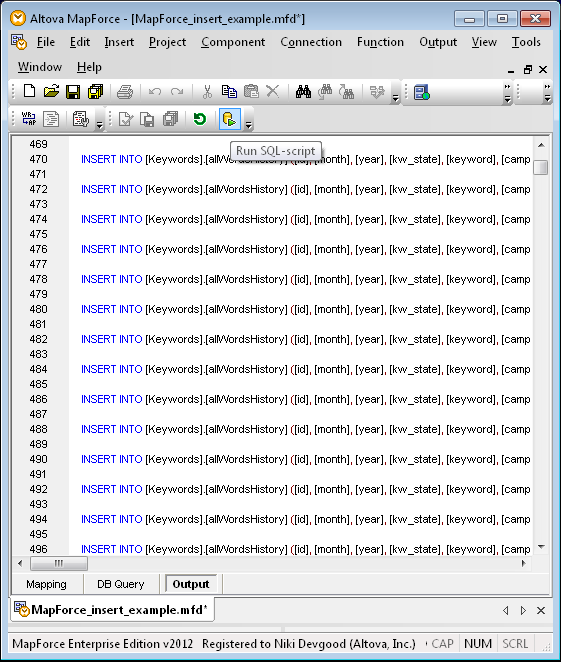 Querying the Database Back in DatabaseSpy, we can query the database from the SQL Editor window. This query reports the top ten performing keywords for SemanticWorks in October 2011. For data privacy, some fields in the Results chart are hidden.
Querying the Database Back in DatabaseSpy, we can query the database from the SQL Editor window. This query reports the top ten performing keywords for SemanticWorks in October 2011. For data privacy, some fields in the Results chart are hidden. 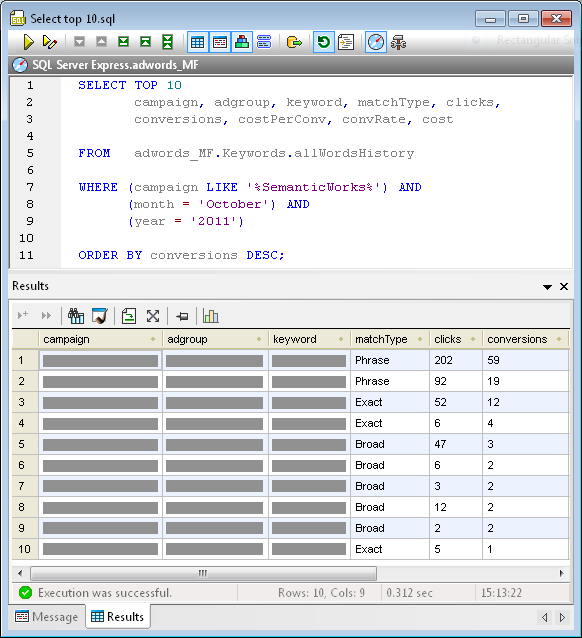 To get additional interesting results, the SQL statement can be easily modified. For instance, the ORDER BY line can sort for highest cost, most clicks, or any other characteristic. The WHERE statement combines data from multiple campaigns. The LIKE keyword treats the percent signs around SemanticWorks as wildcard characters to match any campaign with SemanticWorks anywhere in its name. Other queries could add a geographic identifier such as US or EU, or match on an entirely different column such as adgroup. Of course, all these options depend on a consistent and predictable campaign and adgroup naming system. We created a DatabaseSpy Project to collect all our favorite SQL queries for sharing and convenient reuse. Here is the query we used to generate the chart right in DatabaseSpy that appears at the top of this post:
To get additional interesting results, the SQL statement can be easily modified. For instance, the ORDER BY line can sort for highest cost, most clicks, or any other characteristic. The WHERE statement combines data from multiple campaigns. The LIKE keyword treats the percent signs around SemanticWorks as wildcard characters to match any campaign with SemanticWorks anywhere in its name. Other queries could add a geographic identifier such as US or EU, or match on an entirely different column such as adgroup. Of course, all these options depend on a consistent and predictable campaign and adgroup naming system. We created a DatabaseSpy Project to collect all our favorite SQL queries for sharing and convenient reuse. Here is the query we used to generate the chart right in DatabaseSpy that appears at the top of this post: 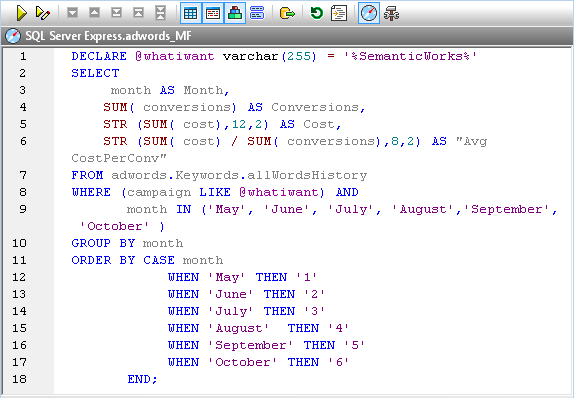 This query goes beyond simple SQL reporting to perform calculations on a subset of the data and format the results. Database Reports We designed reports for the executive team using Altova StyleVision, based on the queries and charts we had already designed in DatabaseSpy. We simply copied our queries from the DatabaseSpy SQL Editor window and added them as sources in the StyleVision Design Overview window. Saving our report design in a StyleVision SPS stylesheet makes it is easy to regenerate an updated version every month. Here is the HTML output for a SemanticWorks Keyword Trends report based on the query above, displayed in the StyleVision Preview window:
This query goes beyond simple SQL reporting to perform calculations on a subset of the data and format the results. Database Reports We designed reports for the executive team using Altova StyleVision, based on the queries and charts we had already designed in DatabaseSpy. We simply copied our queries from the DatabaseSpy SQL Editor window and added them as sources in the StyleVision Design Overview window. Saving our report design in a StyleVision SPS stylesheet makes it is easy to regenerate an updated version every month. Here is the HTML output for a SemanticWorks Keyword Trends report based on the query above, displayed in the StyleVision Preview window: 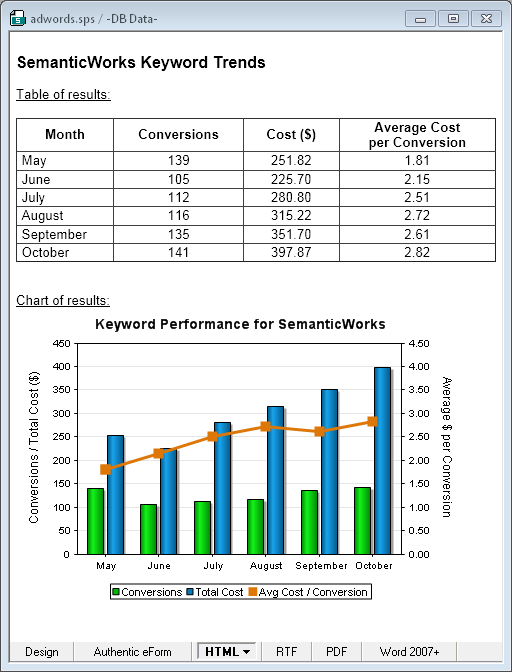 If you follow the conventional wisdom for building your own paid keyword campaigns, you will develop segmented campaigns with many small, highly specialized ad groups, and you may also find yourself overwhelmed by the data in Adwords reports. If you’d like to try managing your own keywords the way we describe here, a fully functional trial of the Altova MissionKit is available.
If you follow the conventional wisdom for building your own paid keyword campaigns, you will develop segmented campaigns with many small, highly specialized ad groups, and you may also find yourself overwhelmed by the data in Adwords reports. If you’d like to try managing your own keywords the way we describe here, a fully functional trial of the Altova MissionKit is available.
DiffDog Takes to the Cloud
Techy folks generally have a good diff tool they rely on to compare and sync files and directories. But what happens when, as more and more info is bound for the cloud, your data lives on servers accessed via URL? There are myriad applications today that live on servers accessed via HTPP – but let’s take a look at a common example: SVN. Subversion (SVN) repositories include WebDAV as a commonly used server option. WebDAV is a natural protocol for SVN because its concern is hierarchy, structured metadata, and versions. Since WebDAV is an extension of HTTP it gives easy access to basic information about files and folders to any HTTP-aware client, including DiffDog – Altova’s diff/merge tool for files, directories, and databases. However, DiffDog knows a few tricks that set it apart from the other breeds.
There are myriad applications today that live on servers accessed via HTPP – but let’s take a look at a common example: SVN. Subversion (SVN) repositories include WebDAV as a commonly used server option. WebDAV is a natural protocol for SVN because its concern is hierarchy, structured metadata, and versions. Since WebDAV is an extension of HTTP it gives easy access to basic information about files and folders to any HTTP-aware client, including DiffDog – Altova’s diff/merge tool for files, directories, and databases. However, DiffDog knows a few tricks that set it apart from the other breeds.
Diff/Merge via WebDAV
SVN clients typically support command line differencing; however, a text-only representation of the changes in even one file can be hard to read and use. When you want to compare the trunk against a tagged version, the problem is magnified. There are several visual differencing tools available that can help with analyzing version changes in SVN. They have varying degrees of compatibility with how SVN works. Some tools are well integrated with the SVN command line. DiffDog includes all the common comparison options for a tool that is tightly integrated with SVN clients. Where it excels is its ability to talk to SVN servers. Accessing an SVN repository with DiffDog using WebDAV is simple. The easiest starting point is to open Directory Comparison View and paste in the URLs of the folders you want to compare. In this case we’re comparing SVN branches on Projectlocker.com. The two sets of files open, and DiffDog provides a color-coded, browsable view of the differences between the two directories. Clicking on either one of a pair of files opens a detailed file comparison.
Clicking on either one of a pair of files opens a detailed file comparison.  DiffDog’s ability to distinguish between changes to XML and meaningful changes is key in this situation – most development trees have some amount of XML in them. DiffDog also supports comparing Word docs and databases – so all bases are covered.
DiffDog’s ability to distinguish between changes to XML and meaningful changes is key in this situation – most development trees have some amount of XML in them. DiffDog also supports comparing Word docs and databases – so all bases are covered. 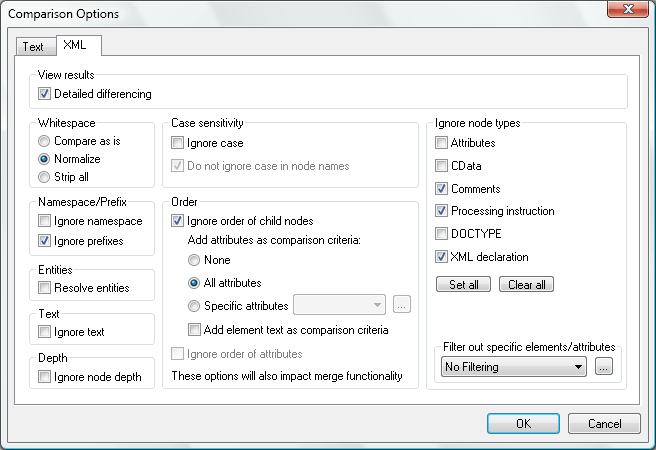 Of course, folders you compare do not have to both be WebDAV SVN folders. It is equally straightforward to compare the SVN server with a local directory. DiffDog’s ability to access servers via HTTP (or FTP) opens a world of possibilities: comparing a local directory with a Google Docs directory, or diffing a local Web server against files hosted on the Amazon CloudFront , or even just synching photos between your local drive and your chosen back- up service. If you’d like to try DiffDog, it’s available for a 30-day trial over on the Altova Web site.
Of course, folders you compare do not have to both be WebDAV SVN folders. It is equally straightforward to compare the SVN server with a local directory. DiffDog’s ability to access servers via HTTP (or FTP) opens a world of possibilities: comparing a local directory with a Google Docs directory, or diffing a local Web server against files hosted on the Amazon CloudFront , or even just synching photos between your local drive and your chosen back- up service. If you’d like to try DiffDog, it’s available for a 30-day trial over on the Altova Web site.
Digging deeper with the Twitter API: iPhone 4S vs. Galaxy Nexus
We found some interesting data when we dug below the surface of the iPhone 4S vs. Galaxy Nexus debate using the Twitter Search API.In today’s world there is a vast quantity of data available online that can be used for research, market analysis, and competitive intelligence. While “Big Data” can be a problem for those who produce it, store it, and compile it, it is highly beneficial for those of us who are looking for answers.Some of that data is fortunately available to be queried online, and, in particular, there is a vast quantity of data on social media interactions out there.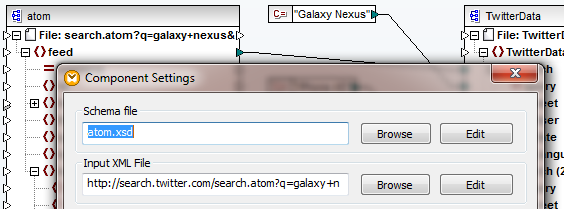 In this article we will explore how to use the Twitter Search API from MapForce, Altova’s data mapping/conversion/integration tool, to aggregate data on recent user submissions (“tweets”) on two highly popular topics – the Apple “iPhone 4S” vs. the “Galaxy Nexus” as the latest hot Android phone – and extract some statistical data about the users engaged in those discussions. One of the benefits of this abundance of data available to us today is that we can query it in interesting ways and extract new meaning from it. While there are undoubtedly many existing services that already provide trends over Twitter topics (e.g., Trendistic), those services only offer very simple trends and do not allow us to query any deeper.But all of the underlying data is available for grabs if you are just willing to learn a tiny bit about web service APIs and how to use them to extract XML data for further processing. As a starting point, let’s use the Twitter Search API to query the stream of recent tweets for the last 100 postings that are about the “Galaxy Nexus”. The Usage Guidelines for Twitter Search tell us that using both words in a query will result in the use of the default operator, which is AND, so we are going to search for posts that contain “Galaxy AND Nexus”. So let’s try that and request the most recent 100 items:
In this article we will explore how to use the Twitter Search API from MapForce, Altova’s data mapping/conversion/integration tool, to aggregate data on recent user submissions (“tweets”) on two highly popular topics – the Apple “iPhone 4S” vs. the “Galaxy Nexus” as the latest hot Android phone – and extract some statistical data about the users engaged in those discussions. One of the benefits of this abundance of data available to us today is that we can query it in interesting ways and extract new meaning from it. While there are undoubtedly many existing services that already provide trends over Twitter topics (e.g., Trendistic), those services only offer very simple trends and do not allow us to query any deeper.But all of the underlying data is available for grabs if you are just willing to learn a tiny bit about web service APIs and how to use them to extract XML data for further processing. As a starting point, let’s use the Twitter Search API to query the stream of recent tweets for the last 100 postings that are about the “Galaxy Nexus”. The Usage Guidelines for Twitter Search tell us that using both words in a query will result in the use of the default operator, which is AND, so we are going to search for posts that contain “Galaxy AND Nexus”. So let’s try that and request the most recent 100 items:
If you follow this link, you will get a second window with a lot of raw XML data that is formatted according to the Atom Syndication Format specifications. Alternatively, you could request the data in JSON format, if you wanted to directly process it via JavaScript code by hand, but we will use the XML-based Atom format so that we can easily analyze the data and extract the information we want.Viewing the above search result in a browser is not very user-friendly, so we can take a quick peek at the XML data in our favorite XML Editor using the Open from URL function: As you can see, the data for each entry includes a language code, so for this example we will extract data from this Twitter feed as well as from a second search result on the “iPhone 4S” and combine them into one intermediate XML file for further analysis.Extracting XML data is really easy in MapForce: using the “Insert XML File” option to drop in an XML source, we can again specify the same URL as before. If needed, MapForce will automatically create an XML Schema for the supplied data so we can visualize it and extract information from it:
As you can see, the data for each entry includes a language code, so for this example we will extract data from this Twitter feed as well as from a second search result on the “iPhone 4S” and combine them into one intermediate XML file for further analysis.Extracting XML data is really easy in MapForce: using the “Insert XML File” option to drop in an XML source, we can again specify the same URL as before. If needed, MapForce will automatically create an XML Schema for the supplied data so we can visualize it and extract information from it: In our mapping we have dropped in two sources on the left side – one using a query string to search for “Galaxy Nexus” and the other to search for “iPhone 4S” – and on the right side we have dropped in a simple XML Schema that will allow us to aggregate our data and analyze it more conveniently going forward. In this case the mapping between the two sides is straight-forward as we are only extracting basic information about the user, the date, and the language of the tweet, but in other applications the mapping could be more complicated and include functions as well as queries to other data sources, databases, or web services…Previewing the resulting XML data can be done directly inside MapForce using the output tab, and this is what we see as a result of our data transformation:
In our mapping we have dropped in two sources on the left side – one using a query string to search for “Galaxy Nexus” and the other to search for “iPhone 4S” – and on the right side we have dropped in a simple XML Schema that will allow us to aggregate our data and analyze it more conveniently going forward. In this case the mapping between the two sides is straight-forward as we are only extracting basic information about the user, the date, and the language of the tweet, but in other applications the mapping could be more complicated and include functions as well as queries to other data sources, databases, or web services…Previewing the resulting XML data can be done directly inside MapForce using the output tab, and this is what we see as a result of our data transformation: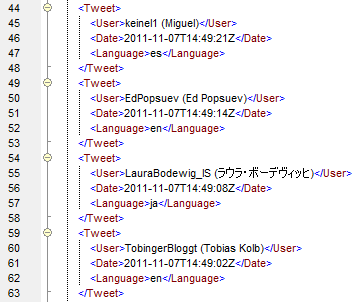 Now we can easily use the reporting capabilities of StyleVision to group this data by language within each topic and count the number of posts in each language. We can then report this data in the form of pie charts, which produces the following interesting results:
Now we can easily use the reporting capabilities of StyleVision to group this data by language within each topic and count the number of posts in each language. We can then report this data in the form of pie charts, which produces the following interesting results: Obviously, this data is highly dependent on the date of execution and time of day, as well as the particular announcements happening about these products, so the numbers will fluctuate quite a bit, but it can be used as a nice monitoring for seeing different language-specific trends. And once this has been set up, the report can be refreshed easily with the click of a button to get a snapshot at that point in time. For more long-term analysis it would of course be necessary to modify the mapping a bit to query more than 100 recent tweets.In this article we have used Twitter’s Search API as one example data source and only looked at language as one unique data point, but there are many more interesting sources of data available online today, and this approach can be used on all of them in a similar fashion.If you want to experiment with other data sources and other kinds of information that you want to extract, we invite you to try for yourself. A free 30-day evaluation version of MapForce is available, and there are no limits on how you can use the other features of Altova’s data mapping and conversion tool for data processing tasks that go beyond analyzing social media trends…
Obviously, this data is highly dependent on the date of execution and time of day, as well as the particular announcements happening about these products, so the numbers will fluctuate quite a bit, but it can be used as a nice monitoring for seeing different language-specific trends. And once this has been set up, the report can be refreshed easily with the click of a button to get a snapshot at that point in time. For more long-term analysis it would of course be necessary to modify the mapping a bit to query more than 100 recent tweets.In this article we have used Twitter’s Search API as one example data source and only looked at language as one unique data point, but there are many more interesting sources of data available online today, and this approach can be used on all of them in a similar fashion.If you want to experiment with other data sources and other kinds of information that you want to extract, we invite you to try for yourself. A free 30-day evaluation version of MapForce is available, and there are no limits on how you can use the other features of Altova’s data mapping and conversion tool for data processing tasks that go beyond analyzing social media trends…
Case Study: Altova Customer Succeeds with XBRL
XBRL is mandated for most public companies. So why are private organizations and non-profits jumping on the bandwagon? This case study examines a real-world success story.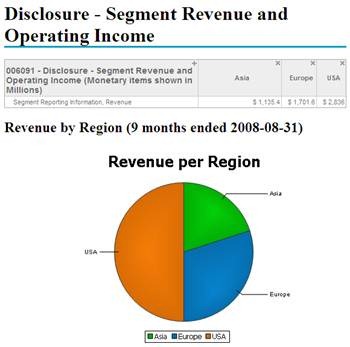 We were really excited when the folks at MACPA told us about their success working with XBRL. They set out to discover if XBRL could be used successfully (without a huge upfront investment) by small businesses and NPOs and ended up confirming not only that, but realizing benefits to their internal financial processes, as well.
We were really excited when the folks at MACPA told us about their success working with XBRL. They set out to discover if XBRL could be used successfully (without a huge upfront investment) by small businesses and NPOs and ended up confirming not only that, but realizing benefits to their internal financial processes, as well.
Toward Ubiquitous XBRL
With close to 10,000 members, the Maryland Association of Certified Public Accountants (MACPA) is often looked to for their expertise on issues relevant to the field of accounting. The US Securities and Exchange Commission’s (SEC) mandate that public companies submit financial data in XBRL is one of those issues. Despite the potential of XBRL for reducing costs and increasing efficiency, many organizations are concerned about the time and expense that will be required to convert all of their financial data into XBRL, a process that can be further complicated when financial data is housed in multiple systems. MACPA set out to prove that these obstacles are easily surmountable: with the right tools, it’s possible to bring XBRL transformation in-house to not only comply with mandates, but realize greater efficiencies and transparency in various scenarios. In the process they discovered that tagging data in XBRL is valuable to private entities and non-profits as well as public companies facing a mandate. They took advantage of widely available XBRL software tools including the Altova MissionKit, which interfaces with multiple relational databases for XBRL mapping, tagging, and reporting.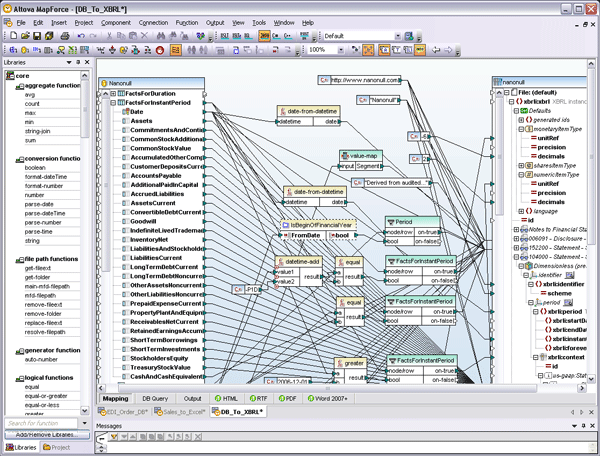 In the end, the project turned MACPA’s financial data into a force for driving efficiencies and accountability. Once their internal accounting data was mapped to XBRL, they were able to automate burdensome data collection, transformation, and analysis tasks to gain more insight into their financial data. For instance, MACPA used their XBRL data to populate their financial Key Performance Indicator (KPI) system, significantly reducing the amount of time and effort required to prepare the KPI documentation. This in turn enables them to run the system at more frequent intervals. They are also now able to automate previously onerous tax filing tasks by mapping the association’s financial data in XBRL to the 990 tax return. (With almost 1.5 million exempt organizations in the US filing hundreds of thousands of Form 990s each year, the efficiency gained by using XBRL could be significant.)
In the end, the project turned MACPA’s financial data into a force for driving efficiencies and accountability. Once their internal accounting data was mapped to XBRL, they were able to automate burdensome data collection, transformation, and analysis tasks to gain more insight into their financial data. For instance, MACPA used their XBRL data to populate their financial Key Performance Indicator (KPI) system, significantly reducing the amount of time and effort required to prepare the KPI documentation. This in turn enables them to run the system at more frequent intervals. They are also now able to automate previously onerous tax filing tasks by mapping the association’s financial data in XBRL to the 990 tax return. (With almost 1.5 million exempt organizations in the US filing hundreds of thousands of Form 990s each year, the efficiency gained by using XBRL could be significant.)
This project not only enabled MACPA to learn about XBRL and advise their members, but also to automate and enhance the way they dealt with their own financial data. And utilizing affordable tools like the Altova MissionKit confirmed that handling XBRL in-house is the way to go.
Check out the complete case study to learn how MACPA brought XBRL transformation in-house to effect changes in efficiency and transparency. If you’re an accounting or technical professional who needs to learn more about XBRL, Altova offers free, self-paced online training and an educational XBRL whitepaper.
January 1 HIPAA Deadline Has Wide Impact
Every day tens of thousands of encrypted data transactions occur between health care providers, pharmacies, insurers, medical billing services, and employers who provide worker health coverage. Everyone in the United States covered by health or dental insurance depends on the automation, accuracy, and security of these largely unnoticed data streams to verify eligibility and process payments for nearly all medical services. Definition of messaging standards for these transactions are mandated by HIPAA (Health Insurance Portability and Accountability Act), passed in 1992 and administered by the Department of Health and Human Services. By January 1, 2012, all health care enterprises covered under HIPAA are required to transfer data in version 5010, the latest HIPAA standard, based on ANSI X12.
Migrating Existing Data Formats To and From the Latest Standards
Altova MapForce is a powerful and flexible tool used by developers and IT professionals in many industries to automate today’s complex data conversions. The screenshot below shows a portion of a real-world example of a complex HIPAA data mapping in Altova MapForce from one state’s ANSI X12 eligibility file to integrate membership file data for public sector healthcare.
Altova MapForce 2012 enables visual mapping to and from all transaction sets that are required to comply with HIPAA regulations. If you are a developer working for an organization in the healthcare industry, you can map HIPAA messages to or from XML, databases, flat files, Excel 2007+, and Web services, then generate royalty-free code in Java, C#, or C++ for your data transformation to integrate internal healthcare data formats and the HIPAA standards. MapForce includes an example mapping from a HIPAA message to XML format, along with a sample data file and XML schema, so you can generate XML output using the MapForce built-in execution engine. The screen shot below shows the MapForce example mapping, including the pop-up help available by rolling the cursor over any HIPAA message element. MapForce allows users to apply mathematical, string, or logical functions, and other conversions, as data is transformed between the source and destination, illustrated by the parse-date function at the bottom center of the mapping image. Of course, privacy issues forbid distribution of an actual patient health care record, so the MapForce example HIPPA message content shown below is describing a fictitious person, but the message format is valid and the example is an effective demonstration of mapping functionality. When you click the Output button at the bottom of the mapping window, MapForce extracts the selected fields from the sample HIPAA message and transforms them to the XML version.
MapForce allows users to apply mathematical, string, or logical functions, and other conversions, as data is transformed between the source and destination, illustrated by the parse-date function at the bottom center of the mapping image. Of course, privacy issues forbid distribution of an actual patient health care record, so the MapForce example HIPPA message content shown below is describing a fictitious person, but the message format is valid and the example is an effective demonstration of mapping functionality. When you click the Output button at the bottom of the mapping window, MapForce extracts the selected fields from the sample HIPAA message and transforms them to the XML version.  For one-time data conversion needs, MapForce lets you save the results displayed in the Output window. MapForce also integrates with Altova StyleVision to apply style sheets that format data mapping output to HTML, RTF, PDF, or Microsoft Word formats.
For one-time data conversion needs, MapForce lets you save the results displayed in the Output window. MapForce also integrates with Altova StyleVision to apply style sheets that format data mapping output to HTML, RTF, PDF, or Microsoft Word formats.
HIPAA Message Formats Supported by MapForce
MapForce supports version 5010 for all the following key X12 transaction types included in the HIPAA January 1, 2012 mandate:
You can also use the example mapping to generate code and compile it to experiment with interfacing a data mapping application to your existing health care records infrastructure. HIPAA data mapping is only one application for the any-to-any graphical data mapping, conversion, and integration functionality of Altova MapForce. If you are interested in trying MapForce for your next data conversion project, you can click here to download a fully functional 30-day trial.
HIPAA data mapping is only one application for the any-to-any graphical data mapping, conversion, and integration functionality of Altova MapForce. If you are interested in trying MapForce for your next data conversion project, you can click here to download a fully functional 30-day trial.
Altova MissionKit 2012 Released Today
Fall is bringing cooler temps, shorter days, and beautiful foliage to us here in the Eastern US and parts near and far. As we celebrate the changing season with fresh apple cider and warm sweaters, we’ve also been working hard to deliver Altova Software Version 2012. This year, Altova’s fall release brings support for HTML5 and CSS3, enhanced functionality for ETL applications, new Java-friendly options, Model Driven Architecture, and more, to the MissionKit software tool suite. Let’s take a look at the new features in detail here, starting with tools that help developers and designers take advantage of HTML5 to create more sophisticated Web pages and apps.
Let’s take a look at the new features in detail here, starting with tools that help developers and designers take advantage of HTML5 to create more sophisticated Web pages and apps.
HTML5 and CSS3
The latest version of the lingua franca for publishing content on the Web includes numerous improvements, from enhanced handling of multimedia content to increased interoperability. As Web developers transition to HTML5, they’ll need an intelligent HTML editor that can provide context-sensitive editing guidance and other time-saving features. XMLSpy 2012 adds support for HTML5 in its HTML editor with entry helpers and drop down menus that offer valid choices based on your cursor location, and an integrated Browser View. It’s also lightning fast to test your edits in multiple browsers directly from the HTML editor. Other features such as integrated project management and support for popular version/source control systems – as well as SharePoint® Server support – make XMLSpy a powerful tool for HTML development.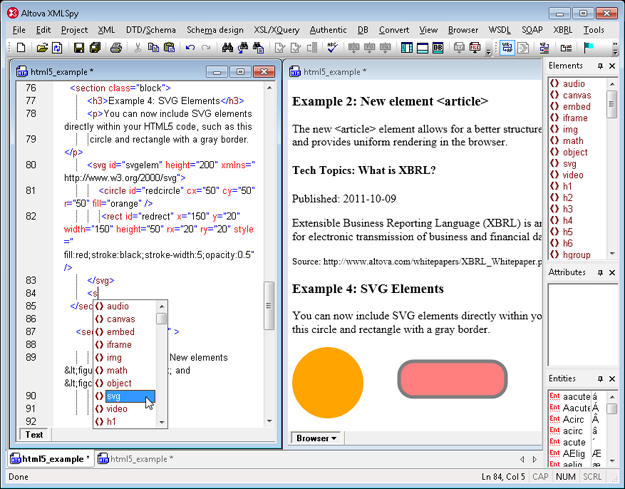 For web designers and developers looking to create HTML5 pages from XML, database, or even XBRL content using a graphical, drag and drop design tool, StyleVision 2012 also supports HTML5 for creating stylesheets and reports. Both XMLSpy 2012 and StyleVision 2012 also support CSS3 styles to complement the new HTML5 functionality.
For web designers and developers looking to create HTML5 pages from XML, database, or even XBRL content using a graphical, drag and drop design tool, StyleVision 2012 also supports HTML5 for creating stylesheets and reports. Both XMLSpy 2012 and StyleVision 2012 also support CSS3 styles to complement the new HTML5 functionality.
Enhanced functionality for ETL
The MapForce 2012 data mapping tool now supports streaming reading of files, a crucial feature for ETL (Extract/Transform/Load) applications. When executing data mapping projects, the built-in MapForce engine can now read extremely large XML, CSV, and FLF files and create correspondingly large output streams. MapForce can even theoretically read an entire relational database in a single pass and generate an XML or other output file at once. This new support makes MapForce a highly effective, lightweight, and scalable tool for ETL. It’s also uniquely affordable, whether purchased as part of the MissionKit tool suite or individually.
New options for Java developers
The Altova MissionKit is designed to support users in their preferred development environment, whatever that may be. To that end we’ve added some new Java-friendly options, including support for JDBC database drivers in all database-enabled products.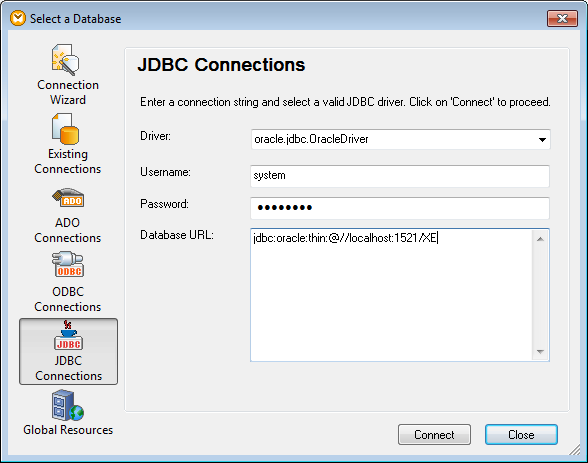 We’ve also introduced a completely redesigned, native Java API for automating the functionality of Altova MissionKit tools in custom applications. This revamped Java API joins the existing COM API, and the products also ship with code samples in various programming language to get you started using the APIs right away.
We’ve also introduced a completely redesigned, native Java API for automating the functionality of Altova MissionKit tools in custom applications. This revamped Java API joins the existing COM API, and the products also ship with code samples in various programming language to get you started using the APIs right away.
Model Driven Architecture (MDA)
In response to requests from our UModel customers, we’ve added support for MDA in Version 2012 of our UML modeling tool. Utilizing a Model Driven Architecture approach to software engineering in UModel provides two primary advantages:
Upgrade info
Check out the rest of the features added in the MissionKit 2012. This new version is free to download and install for customers with Support and Maintenance. If you’re not already a customer, you can download a free, fully functional 30-day trial.
XML Development with Database Integration
Did you know that XMLSpy connects to relational databases? One of the most compelling features of the Altova MissionKit is that numerous tools in the suite include offer deep integration with relational databases, providing seamless access to back end data for bi-directional conversion, integration, analysis, and reporting. Let’s take a look at what you can do when you connect XMLSpy to your databases. Other database-enabled MissionKit tools will be covered in subsequent posts.All popular relational databases are supported in XMLSpy:
Let’s take a look at what you can do when you connect XMLSpy to your databases. Other database-enabled MissionKit tools will be covered in subsequent posts.All popular relational databases are supported in XMLSpy:
First step: Connect to and query the database
When you select Query Database from the DB menu, XMLSpy helps you connect to your database with the step-by-step Database Connection Wizard. Then, the DB Query window makes it easy to explore and/or edit data in the database you’re working with, either by opening existing SQL files or creating SQL scripts from scratch using drag-and-drop and auto-complete functionality. Once you execute your query, you can edit the database data in the results window, review changed fields (highlighted in pink), and commit the changes back to the database.
Next: Convert between XML and databases
Another common requirement is converting between XML and database models, and XMLSpy supports this in both directions. You can easily export database data to XML. If no schema is required, you can simply export the data to XML in its basic tabular format. Or, you can use the Create XML Schema from DB Structure option first, then import database data maintaining all the relationships and dependencies defined in the content model. Numerous options are available to specify the format of the schema, whether columns should be imported as elements or attributes, and the database constraints that should be generated in the XML Schema. Or, to go in the other direction, it’s just as easy to go from XML to a relational model in XMLSpy. The Export to Database dialog (accessed via the Convert menu) allows you to specify where to start the export, how to handle export fields, and which elements to include. Then, the data is instantly converted and stored in your database.
Or, to go in the other direction, it’s just as easy to go from XML to a relational model in XMLSpy. The Export to Database dialog (accessed via the Convert menu) allows you to specify where to start the export, how to handle export fields, and which elements to include. Then, the data is instantly converted and stored in your database.  For times when you want to define a database with the same rules as an existing XML Schema, the Create DB Structure from XML Schema dialog lets you do so with numerous options. Any identity constraints included in the schema will automatically transfer to the database structure. Alternatively, it’s easy to define relationships between elements manually. Learn more about all these features for working with XML and databases in XMLSpy, or check out all the database tools available in the MissionKit.
For times when you want to define a database with the same rules as an existing XML Schema, the Create DB Structure from XML Schema dialog lets you do so with numerous options. Any identity constraints included in the schema will automatically transfer to the database structure. Alternatively, it’s easy to define relationships between elements manually. Learn more about all these features for working with XML and databases in XMLSpy, or check out all the database tools available in the MissionKit.
Meet the Altova Team at Oracle OpenWorld
Leverage Your Financial Data with the XBRL Chart Wizard–Part 2
Extensible Business Reporting Language (XBRL) is an XML-based language for reporting and exchanging financial data that’s making inroads across the globe. In fact the US Securities and Exchange Commission now requires public companies to submit financial data in XBRL format.Altova’s MissionKit, a suite of our most popular software, supports XBRL tagging via XMLSpy and MapForce as well as XBRL rendering via StyleVision. With StyleVision you can create sophisticated financial reports including charts and tables based on XBRL instance files. This is the second post in our two part series on StyleVision’s XBRL chart capabilities. In our last post we showed you how to call the XBRL Chart Wizard and create pie charts. This time we’ll show you how to create bar charts and line charts. Bar Charts Bar charts are the ideal vehicle for comparing groups of objects or visualizing change from one period to another. Here we’ve used the XBRL Chart Wizard to create a bar chart comparing Current Assets to Current Liabilities from the third quarters of two consecutive years. After invoking the XBRL Chart Wizard as we did in the very first step, we select Current Assets and Current Liabilities in the Concepts tab and place it in the Series pane so that these amounts will be reflected on the Y or vertical axis.
This is the second post in our two part series on StyleVision’s XBRL chart capabilities. In our last post we showed you how to call the XBRL Chart Wizard and create pie charts. This time we’ll show you how to create bar charts and line charts. Bar Charts Bar charts are the ideal vehicle for comparing groups of objects or visualizing change from one period to another. Here we’ve used the XBRL Chart Wizard to create a bar chart comparing Current Assets to Current Liabilities from the third quarters of two consecutive years. After invoking the XBRL Chart Wizard as we did in the very first step, we select Current Assets and Current Liabilities in the Concepts tab and place it in the Series pane so that these amounts will be reflected on the Y or vertical axis. 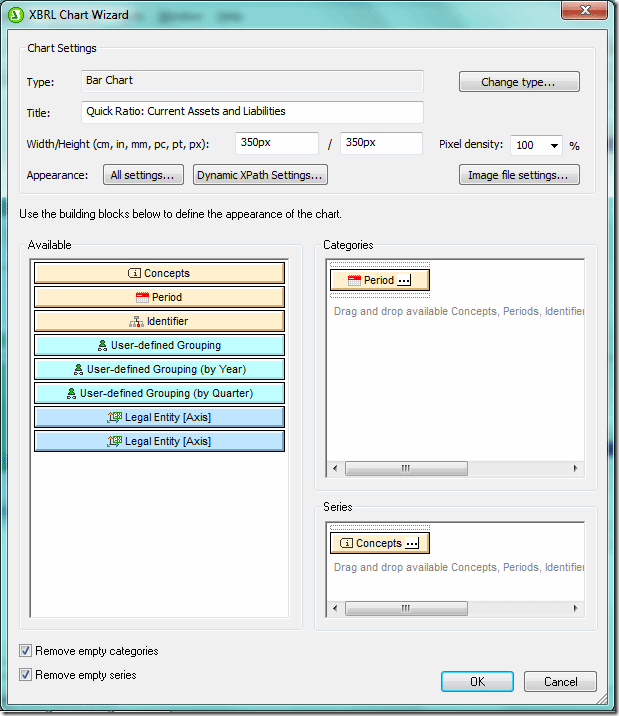 Now we click the ellipses in the Period tab in the Categories pane to bring up the Period Properties dialog box. Assets and Liabilities are measured at specific points in time and so we have checked the Show instant periods box. We’ve also filtered the data using XPath so that only assets and liabilities at the end of the third quarter (which ends in August) appear. Finally we add a dynamic label that combines “Q3” with the year using XPath.
Now we click the ellipses in the Period tab in the Categories pane to bring up the Period Properties dialog box. Assets and Liabilities are measured at specific points in time and so we have checked the Show instant periods box. We’ve also filtered the data using XPath so that only assets and liabilities at the end of the third quarter (which ends in August) appear. Finally we add a dynamic label that combines “Q3” with the year using XPath.  In addition to the bar chart, we’d like to include the Quick Ratio, a measure that indicates whether an organization has enough readily liquidated resources to cover outstanding financial obligations. The Quick Ratio is simply Current Assets divided by Current Liabilities. We’ve added an auto calculation and used XPath to divide Current Assets by Current Liabilities for all time periods in the XBRL instance document. Below is the design view of our bar chart and auto calculation, including the XPath.
In addition to the bar chart, we’d like to include the Quick Ratio, a measure that indicates whether an organization has enough readily liquidated resources to cover outstanding financial obligations. The Quick Ratio is simply Current Assets divided by Current Liabilities. We’ve added an auto calculation and used XPath to divide Current Assets by Current Liabilities for all time periods in the XBRL instance document. Below is the design view of our bar chart and auto calculation, including the XPath.  The HTML output appears below. However we can also render the design in RTF, PDF, and Word 2007+.
The HTML output appears below. However we can also render the design in RTF, PDF, and Word 2007+. 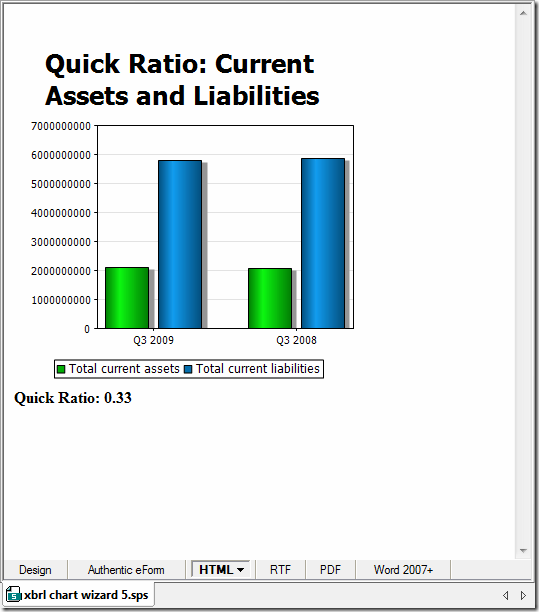 Line Charts A line chart has a line connecting discrete points plotted on a graph and is typically used to track how financial and other data varies over time. In this example we’ve created a line chart to track two concepts – costs / expenses and revenue – over a four year period. Just as we did for the pie chart and bar chart, we’ve dragged a concept (here, Revenues) from the Schema Tree into the design window and invoked the XBRL Chart Wizard. Likewise, once the Chart Wizard opens, we clicked on the ellipses on the Concepts tab in the Series pane to bring up the Concept Properties dialog box, where we selected the Costs and Expenses concept. Costs and Expenses will now appear on the chart along with Revenues. Our XBRL file includes both instance and duration time periods so in the Period Properties dialog box below (invoked by clicking on the ellipses in the Period tab in the Categories pane) we’ve selected only duration periods, or those with a start and end date. We will now use XPath to filter the data. We’ll create a variable $altova:duration that translates the difference in number of days between the start and end dates of the period into the number of months and then selected data where that variable is equal to three (equivalent to a fiscal quarter). We’ve also used XPath to create a dynamic label combining Q3 with the year.
Line Charts A line chart has a line connecting discrete points plotted on a graph and is typically used to track how financial and other data varies over time. In this example we’ve created a line chart to track two concepts – costs / expenses and revenue – over a four year period. Just as we did for the pie chart and bar chart, we’ve dragged a concept (here, Revenues) from the Schema Tree into the design window and invoked the XBRL Chart Wizard. Likewise, once the Chart Wizard opens, we clicked on the ellipses on the Concepts tab in the Series pane to bring up the Concept Properties dialog box, where we selected the Costs and Expenses concept. Costs and Expenses will now appear on the chart along with Revenues. Our XBRL file includes both instance and duration time periods so in the Period Properties dialog box below (invoked by clicking on the ellipses in the Period tab in the Categories pane) we’ve selected only duration periods, or those with a start and end date. We will now use XPath to filter the data. We’ll create a variable $altova:duration that translates the difference in number of days between the start and end dates of the period into the number of months and then selected data where that variable is equal to three (equivalent to a fiscal quarter). We’ve also used XPath to create a dynamic label combining Q3 with the year. 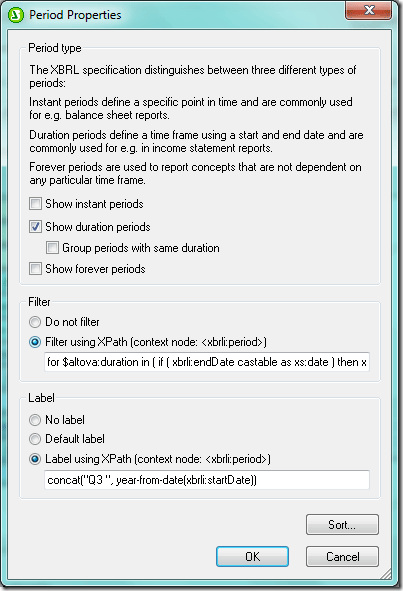 Because our line chart is visualizing changes in revenue and costs and expenses over time, we have used the Sort function in the Period Properties dialog box above so that the data appear chronologically.
Because our line chart is visualizing changes in revenue and costs and expenses over time, we have used the Sort function in the Period Properties dialog box above so that the data appear chronologically. 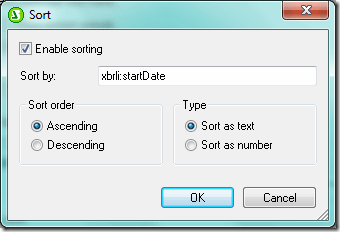 Although the appearance of the chart (e.g., colors, labels, and visibility of tick marks and axis values) can be controlled with the All Settings button in the Chart Settings section of the XBRL Chart Wizard dialog box, it can also be controlled with XPath via the Dynamic XPath Settings button under Chart Settings (below).
Although the appearance of the chart (e.g., colors, labels, and visibility of tick marks and axis values) can be controlled with the All Settings button in the Chart Settings section of the XBRL Chart Wizard dialog box, it can also be controlled with XPath via the Dynamic XPath Settings button under Chart Settings (below).  This feature provides tremendous flexibility not only in managing appearance but in managing the contents of the chart. Among the many things you can do with XPath are controlling output based on conditions and adding a dynamic title that includes the time period reflected as we’ve done here. Once you click the Dynamic XPath Settings button in the XBRL Chart Wizard dialog box (above), the Dynamic XPath Settings dialog box is invoked (below).
This feature provides tremendous flexibility not only in managing appearance but in managing the contents of the chart. Among the many things you can do with XPath are controlling output based on conditions and adding a dynamic title that includes the time period reflected as we’ve done here. Once you click the Dynamic XPath Settings button in the XBRL Chart Wizard dialog box (above), the Dynamic XPath Settings dialog box is invoked (below).  Clicking the ellipses next to the property that you want to edit in the Dynamic XPath Settings dialog box (above) brings up the Edit XPath Expression dialog box (below). Here we’ve used XPath to concatenate a string (“Revenues / Costs and Expenses”) with the first and last years in the period we identified in the Period Properties dialog box earlier.
Clicking the ellipses next to the property that you want to edit in the Dynamic XPath Settings dialog box (above) brings up the Edit XPath Expression dialog box (below). Here we’ve used XPath to concatenate a string (“Revenues / Costs and Expenses”) with the first and last years in the period we identified in the Period Properties dialog box earlier. 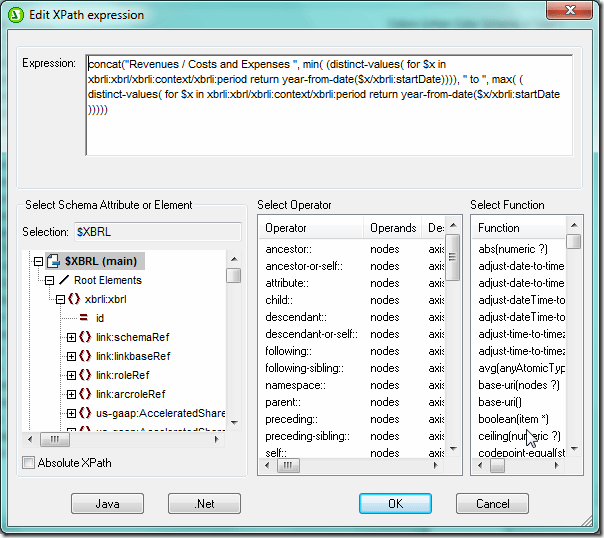 The XPath expression entered here will overrule the settings in the Change Appearance and XBRL Chart Wizard dialog boxes – notice in the chart (here rendered in HTML) includes the dynamic title that we built with XPath rather than the title in the XBRL Chart Wizard Dialog Box.
The XPath expression entered here will overrule the settings in the Change Appearance and XBRL Chart Wizard dialog boxes – notice in the chart (here rendered in HTML) includes the dynamic title that we built with XPath rather than the title in the XBRL Chart Wizard Dialog Box. 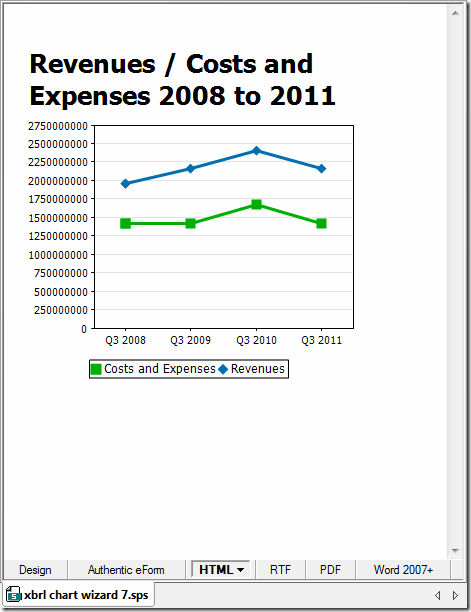 As we’ve shown here, the XBRL Chart Wizard provides developers and designers with a highly flexible tool for visualizing XBRL data. With XBRL’s place in the international technology sector firmly established, the ability to leverage XBRL data to support strategic decision making is key. There are a number of different types of companies that are discovering the strategic value of XBRL. Our XBRL case study describes how the Maryland Association of CPAs streamlined their tax reporting and benchmarking processes with XBRL. This case study is a great resource for anyone interested in learning how to leverage this data with Altova software tools.
As we’ve shown here, the XBRL Chart Wizard provides developers and designers with a highly flexible tool for visualizing XBRL data. With XBRL’s place in the international technology sector firmly established, the ability to leverage XBRL data to support strategic decision making is key. There are a number of different types of companies that are discovering the strategic value of XBRL. Our XBRL case study describes how the Maryland Association of CPAs streamlined their tax reporting and benchmarking processes with XBRL. This case study is a great resource for anyone interested in learning how to leverage this data with Altova software tools.
Have you created something really great with the XBRL Chart Wizard? Or developed an interesting project using StyleVision or another of our tools? Please share your story with other Altova users by commenting on this blog post. Think it would make a great case study? Email us at marketing@altova.com – if we choose to use your story you’ll receive a $200 Amazon gift card as well as some free press for you and your organization. We’d love to hear from you!
Leverage Your Financial Data with the XBRL Chart Wizard–Part 1
Extensible Business Reporting Language (XBRL), an XML-based language for financial data, is increasingly being used by both public and private organizations across the globe – in fact it is mandated for some companies in countries including the United Kingdom and the United States. Altova provides comprehensive support for XBRL tagging and XBRL reporting with the MissionKit, a suite of our most popular software. Among the MissionKit tools is StyleVision, a graphical stylesheet designer and report builder, which can be used to support a host of internal reporting and analysis activities for companies that use XBRL.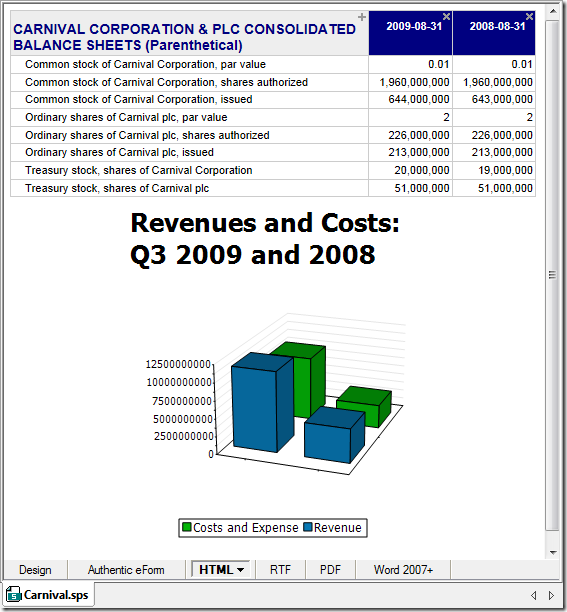 In the next post we’ll focus on StyleVision’s XBRL Chart Wizard, a powerful XBRL visualization tool that can turn your XBRL-tagged financial data into powerful charts and graphs – if a picture is worth 1,000 words then StyleVision is worth its weight in gold. Calling the XBRL Chart Wizard You invoke the XBRL Chart Wizard as you do the XBRL Table Wizard and other StyleVision capabilities. Once you’ve started a design by selecting New – New from XBRL Taxonomy from the File menu and selected a taxonomy and working XBRL file, all concepts are populated to the Schema Tree. From here you simply select a concept from the XBRL taxonomy in the Schema Tree and drag it into the design window. For this example we’ll be using the Carnival Corporation quarterly report for 2009 that they have published with the SEC, but you can apply the same techniques to any XBRL instance document – be it a publicly available filing with the SEC or an internally generated XBRL file. As a first step, we will look at how the revenues are composed by creating a pie chart that shows the revenue breakdown. Here we’ve dragged the Revenues concept (highlighted in the Schema Tree in the left sidebar) into the design window and selected Create XBRL Chart.
In the next post we’ll focus on StyleVision’s XBRL Chart Wizard, a powerful XBRL visualization tool that can turn your XBRL-tagged financial data into powerful charts and graphs – if a picture is worth 1,000 words then StyleVision is worth its weight in gold. Calling the XBRL Chart Wizard You invoke the XBRL Chart Wizard as you do the XBRL Table Wizard and other StyleVision capabilities. Once you’ve started a design by selecting New – New from XBRL Taxonomy from the File menu and selected a taxonomy and working XBRL file, all concepts are populated to the Schema Tree. From here you simply select a concept from the XBRL taxonomy in the Schema Tree and drag it into the design window. For this example we’ll be using the Carnival Corporation quarterly report for 2009 that they have published with the SEC, but you can apply the same techniques to any XBRL instance document – be it a publicly available filing with the SEC or an internally generated XBRL file. As a first step, we will look at how the revenues are composed by creating a pie chart that shows the revenue breakdown. Here we’ve dragged the Revenues concept (highlighted in the Schema Tree in the left sidebar) into the design window and selected Create XBRL Chart. 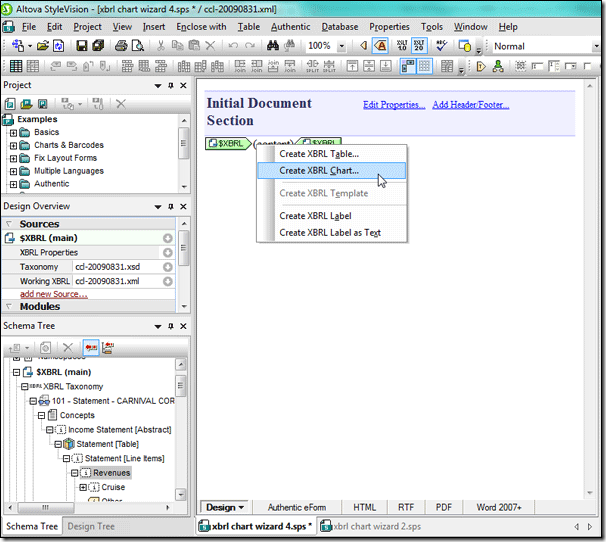 Once you select Create XBRL Chart the XBRL Chart Wizard dialog box will open automatically.
Once you select Create XBRL Chart the XBRL Chart Wizard dialog box will open automatically.  Once you click the ellipses in the corner of the Concepts tab in the Series pane, the Concept Properties dialog box (below) will open and you can select concepts to appear in the chart. Carnival Corp breaks out revenues for their cruises between Passenger tickets and the Onboard and other. We will select those two concepts, and also the Other category to capture all elements that make up the total revenues.
Once you click the ellipses in the corner of the Concepts tab in the Series pane, the Concept Properties dialog box (below) will open and you can select concepts to appear in the chart. Carnival Corp breaks out revenues for their cruises between Passenger tickets and the Onboard and other. We will select those two concepts, and also the Other category to capture all elements that make up the total revenues.  Pie Charts Pie charts are useful when you wish to see the relative contribution of individual elements to the whole. Placing Onboard and other, Other Sales Revenue Net, and Passenger Tickets in a pie chart provides us with a visual representation of the relative contributions of each source of income to total revenue. We are now ready to make changes in the XBRL Chart Wizard dialog box so that our pie chart reflects the information we need in a format conducive to strategic decision making. First we must change the chart type under Chart Settings from Bar Chart to Pie Chart 3D via the Change type… button, which brings up the Change Type dialog box (below).
Pie Charts Pie charts are useful when you wish to see the relative contribution of individual elements to the whole. Placing Onboard and other, Other Sales Revenue Net, and Passenger Tickets in a pie chart provides us with a visual representation of the relative contributions of each source of income to total revenue. We are now ready to make changes in the XBRL Chart Wizard dialog box so that our pie chart reflects the information we need in a format conducive to strategic decision making. First we must change the chart type under Chart Settings from Bar Chart to Pie Chart 3D via the Change type… button, which brings up the Change Type dialog box (below). 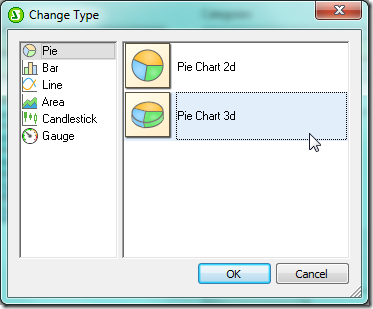 In pie charts, the concepts that will form the segments of the pie (in this instance the Onboard and other, Other Sales Revenue Net, and Passenger Tickets concepts that we selected above) are placed in the Categories pane and the values in the Series pane. Therefore we will need to move the Concepts tab to the Categories pane and the Period tab to the Series pane. We’d like to segment the revenue data from the XBRL file based on quarter. We do this by dragging the User-Defined Grouping (by Quarter) tab from the Available pane to the Categories pane. We’ll make the necessary changes in this tab in the next step. We will also check the Remove empty categories and Remove empty series boxes so that a value or label will not be generated if no data exists and change the size of the chart to 350 pixels x 350 pixels in the Chart Settings section of the XBRL Chart Wizard dialog box. After we make these changes, the dialog box looks like this:
In pie charts, the concepts that will form the segments of the pie (in this instance the Onboard and other, Other Sales Revenue Net, and Passenger Tickets concepts that we selected above) are placed in the Categories pane and the values in the Series pane. Therefore we will need to move the Concepts tab to the Categories pane and the Period tab to the Series pane. We’d like to segment the revenue data from the XBRL file based on quarter. We do this by dragging the User-Defined Grouping (by Quarter) tab from the Available pane to the Categories pane. We’ll make the necessary changes in this tab in the next step. We will also check the Remove empty categories and Remove empty series boxes so that a value or label will not be generated if no data exists and change the size of the chart to 350 pixels x 350 pixels in the Chart Settings section of the XBRL Chart Wizard dialog box. After we make these changes, the dialog box looks like this: 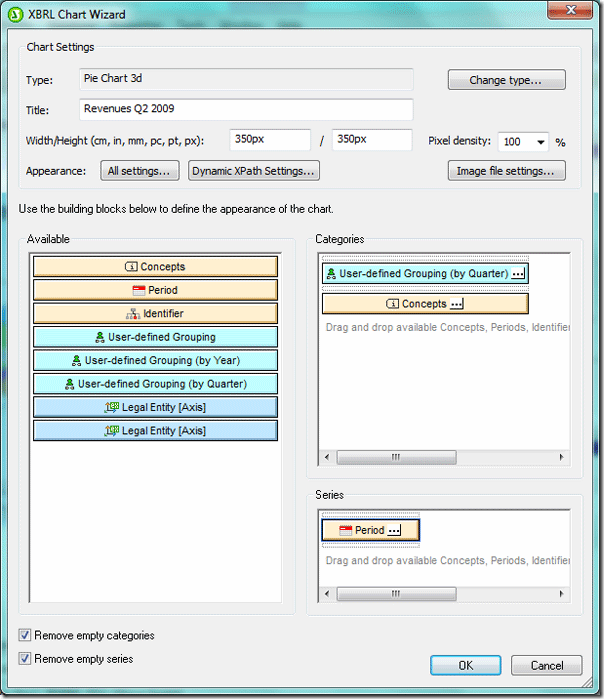 Now we are ready to select the data that appears in the chart. First we’ll segment the data by quarter. We invoke the User-defined Grouping Properties dialog box pictured below by clicking the ellipses in the corner of the User-defined Grouping (by quarter) tab in the Categories pane. The grouping feature provides you with maximum flexibility by allowing you to segment data based on variables identified in the taxonomy (e.g., reporting period, geographical area, division). Now we can use XPath in the Group By field to group the data by quarter, filter it based on the group we created (in this example only the second quarters will appear in the chart), and add a dynamic label. We want the chart to reflect all second quarter data for each of the revenue concepts we selected so we toggle Do not filter under Group key filter.
Now we are ready to select the data that appears in the chart. First we’ll segment the data by quarter. We invoke the User-defined Grouping Properties dialog box pictured below by clicking the ellipses in the corner of the User-defined Grouping (by quarter) tab in the Categories pane. The grouping feature provides you with maximum flexibility by allowing you to segment data based on variables identified in the taxonomy (e.g., reporting period, geographical area, division). Now we can use XPath in the Group By field to group the data by quarter, filter it based on the group we created (in this example only the second quarters will appear in the chart), and add a dynamic label. We want the chart to reflect all second quarter data for each of the revenue concepts we selected so we toggle Do not filter under Group key filter. 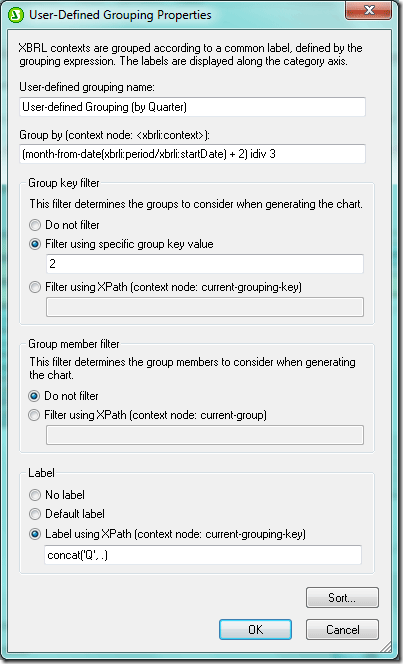 We can further filter the data by clicking on the ellipses on the Period tab in the Series pane to bring up the Period Properties dialog box. Here we’ve selected only duration periods (i.e., those with a start date and end date – instant periods have a single date reflecting the date that the “snapshot” was taken) and filtered based on year. In this example only data from the second quarter of 2009 will appear in the chart.
We can further filter the data by clicking on the ellipses on the Period tab in the Series pane to bring up the Period Properties dialog box. Here we’ve selected only duration periods (i.e., those with a start date and end date – instant periods have a single date reflecting the date that the “snapshot” was taken) and filtered based on year. In this example only data from the second quarter of 2009 will appear in the chart.  Finally we can fine tune the chart’s appearance by clicking on the All Settings tab under Chart Settings, which brings up the Change Appearance dialog box. Here we’ve opted to show the concept labels, values, and percent of total. We can also select color schema, chart size, font types and sizes for each section of the chart (e.g., chart title, labels, legend), and background colors.
Finally we can fine tune the chart’s appearance by clicking on the All Settings tab under Chart Settings, which brings up the Change Appearance dialog box. Here we’ve opted to show the concept labels, values, and percent of total. We can also select color schema, chart size, font types and sizes for each section of the chart (e.g., chart title, labels, legend), and background colors.  After making all of these changes we hit OK in the XBRL Chart Wizard dialog box and the pie chart reflecting these changes is created. Please note that after the chart is created you can go back and edit the chart settings.
After making all of these changes we hit OK in the XBRL Chart Wizard dialog box and the pie chart reflecting these changes is created. Please note that after the chart is created you can go back and edit the chart settings. 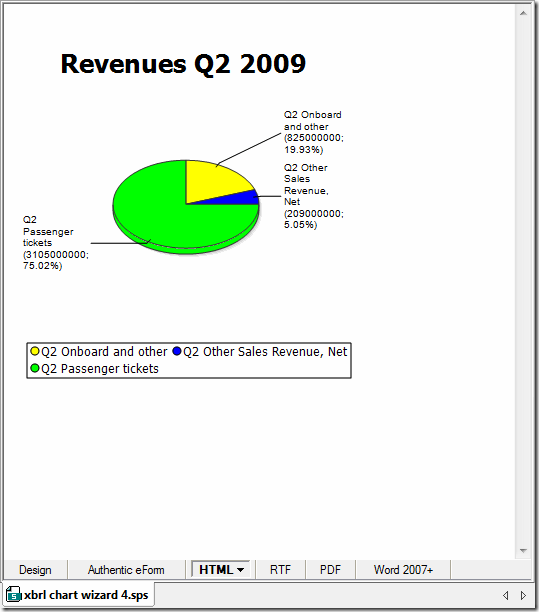 As you can see, the biggest source of revenues is Passenger tickets, which produced 75.02% of total revenues for Carnival Corp in the second quarter of 2009. As is the case with all StyleVision designs, output can be rendered in HTML, RTF, PDF, and Word 2007+ formats and an XSLT stylesheet for each format is automatically generated. And this was just one example of what kind of data you can extract from an XBRL filing and visualize in a chart. Next week we’ll look at creating bar charts and line charts from XBRL financial data.
As you can see, the biggest source of revenues is Passenger tickets, which produced 75.02% of total revenues for Carnival Corp in the second quarter of 2009. As is the case with all StyleVision designs, output can be rendered in HTML, RTF, PDF, and Word 2007+ formats and an XSLT stylesheet for each format is automatically generated. And this was just one example of what kind of data you can extract from an XBRL filing and visualize in a chart. Next week we’ll look at creating bar charts and line charts from XBRL financial data.  Have you created something really great with the XBRL Chart Wizard? Or developed an interesting project using StyleVision or another of our tools? Please share your story with other Altova users by commenting on this blog post. Think it would make a great case study? Email us at marketing@altova.com – if we choose to use your story you’ll receive a $200 Amazon gift card as well as some free press for you and your organization. We’d love to hear from you!
Have you created something really great with the XBRL Chart Wizard? Or developed an interesting project using StyleVision or another of our tools? Please share your story with other Altova users by commenting on this blog post. Think it would make a great case study? Email us at marketing@altova.com – if we choose to use your story you’ll receive a $200 Amazon gift card as well as some free press for you and your organization. We’d love to hear from you!
Processing the Groupon API – Part 3
Concluding the series in this post, we will apply a stylesheet to transform the XML data created from our mapping of the Groupon API into HTML. Here is an example of the XML output from the data mapping we created last time:
Assign a Stylesheet to Transform XML The Component Settings dialog for the output component of the MapForce mapping allows us to assign a stylesheet created with Altova StyleVision.

 When you click any of these output format buttons, MapForce executes the data mapping exactly as we saw in the previous post. MapForce seamlessly passes the XML output to StyleVision, where it is transformed to the selected format. MapForce then displays the formatted document in the Output window. Here is the MapForce Output window for HTML, based on the StyleVision Power Stylesheet assigned above:
When you click any of these output format buttons, MapForce executes the data mapping exactly as we saw in the previous post. MapForce seamlessly passes the XML output to StyleVision, where it is transformed to the selected format. MapForce then displays the formatted document in the Output window. Here is the MapForce Output window for HTML, based on the StyleVision Power Stylesheet assigned above:  The MapForce Output menu lets you save the XML data mapping output or the HTML document formatted according to the stylesheet. How to Make a Stylesheet We designed a stylesheet for the Groupon API data mapping using Altova StyleVision, based on the XML Schema for the MapForce output component. The intuitive StyleVision interface and powerful data access and manipulation features make it easy to create attractive documents in HTML, RTF, PDF, and Microsoft Word formats from XML files. The screenshot below shows the StyleVision Design View of the Extreme Groupon stylesheet. The blue numbered circles identify the location of each design feature listed following the image.
The MapForce Output menu lets you save the XML data mapping output or the HTML document formatted according to the stylesheet. How to Make a Stylesheet We designed a stylesheet for the Groupon API data mapping using Altova StyleVision, based on the XML Schema for the MapForce output component. The intuitive StyleVision interface and powerful data access and manipulation features make it easy to create attractive documents in HTML, RTF, PDF, and Microsoft Word formats from XML files. The screenshot below shows the StyleVision Design View of the Extreme Groupon stylesheet. The blue numbered circles identify the location of each design feature listed following the image.  Features of the SPS file
Features of the SPS file
Assigning a stylesheet to the data mapping output component integrates the operations of MapForce and StyleVision, and a new series of buttons appears at the bottom of the MapForce mapping window for HTML, RTF, PDF, and Microsoft Word formats. (You must have both MapForce and StyleVision installed on your computer.)
StyleVision Power Stylesheets can combine multiple .xsd files, existing .css stylesheets, database schemas, XBRL taxonomies, and more to produce richly formatted reports that can even include automatically generated charts in various styles. You can also use StyleVision to define e-forms with data entry fields, drop down menus, radio buttons and other advanced features. Previewing Stylesheet Transformations StyleVision lets you assign a working XML file to preview your output as you design the stylesheet, and the buttons along the bottom of the Design window make it convenient to display the formatted working file as you refine your design. We saved the XML output of the MapForce mapping and assigned it as our working document. When the stylesheet was complete, the HTML Preview in StyleVision was identical to the MapForce HTML Output window shown above. To view the document on a mobile device you can either deploy the HTML as a page on a Web site or email it as an attachment. In addition to the stylesheet itself and formatted versions of the working document, StyleVision lets you save generated XSLT files to transform other XML files using your stylesheet design outside the StyleVision application. Automation Next Time In the future when you want to re-run a data mapping and refresh the HTML document with up to date data, there are two ways to automate the process:
In addition to the stylesheet itself and formatted versions of the working document, StyleVision lets you save generated XSLT files to transform other XML files using your stylesheet design outside the StyleVision application. Automation Next Time In the future when you want to re-run a data mapping and refresh the HTML document with up to date data, there are two ways to automate the process:
XMLSpy, MapForce, and StyleVision are all available together in the specially priced Altova MissionKit. See for yourself how easy it is to use the MissionKit to convert data from a Web API — download a free 30-day trial!
Editor’s Note: Our original series on mapping data from the Groupon API ran in three parts you can see by clicking the links here: Part 1 of Processing the Groupon API with Altova MapForce describes how to create dynamic input by collecting data from multiple URLs. Processing the Groupon API with MapForce – Part 2 describes how we filtered data from the API and defined the output to extract only the most interesting details. Processing the Groupon API – Part 3 describes formatting the output as a single HTML document optimized for desktop and mobile devices, and reviews ways to automate repeat execution.
Processing the Groupon API with MapForce – Part 2
In Part 1 of this series we described how to connect Altova MapForce to the Groupon API. We queried the API for a list of Groupon divisions, then used the list to create API queries for all the current deals from every division. In this part, we will execute the /deals queries and filter the response for the most interesting data. The list of /deals queries we built previously looks like this: To process all the queries, we can connect the list as a dynamic file input to a new mapping component. When we needed a new component last time, we dropped an API /divisions query into the mapping, and let MapForce create an XML Schema automatically. We could do the same thing here by dropping in an API /deals query as an XML input file. There’s just one small issue — although the Groupon API online documentation clearly describes the queries we can make, it is vague about the information that will be returned. Before we send dozens of queries to the API for all the current deals, we probably want to know a little more about the data that will come back.
To process all the queries, we can connect the list as a dynamic file input to a new mapping component. When we needed a new component last time, we dropped an API /divisions query into the mapping, and let MapForce create an XML Schema automatically. We could do the same thing here by dropping in an API /deals query as an XML input file. There’s just one small issue — although the Groupon API online documentation clearly describes the queries we can make, it is vague about the information that will be returned. Before we send dozens of queries to the API for all the current deals, we probably want to know a little more about the data that will come back.
 As expected, we got quite a bit of data when we requested all the deals for a single division! A fast way to analyze the structure of this data is to use the XMLSpy DTD / Schema menu option to generate an .xsd file from the xml. Shown below is a reduced view of the entire generated .xsd file based on the response to the /deals query for Dallas:
As expected, we got quite a bit of data when we requested all the deals for a single division! A fast way to analyze the structure of this data is to use the XMLSpy DTD / Schema menu option to generate an .xsd file from the xml. Shown below is a reduced view of the entire generated .xsd file based on the response to the /deals query for Dallas: 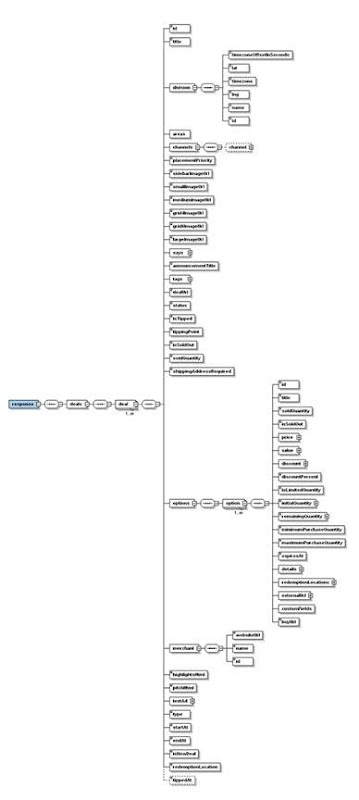 We can dig even deeper, following Yogi’s advice like déjà vu all over again. Expanding all the elements to review the XML Schema reveals some curious anomalies. For instance, there are two elements named redemptionLocation with different definitions. The first contains a sequence of child elements:
We can dig even deeper, following Yogi’s advice like déjà vu all over again. Expanding all the elements to review the XML Schema reveals some curious anomalies. For instance, there are two elements named redemptionLocation with different definitions. The first contains a sequence of child elements:  And the second is defined as a simple string:
And the second is defined as a simple string:  Going back into the xml data for Dallas and searching for redemptionLocation displays these examples:
Going back into the xml data for Dallas and searching for redemptionLocation displays these examples:  And:
And:  And:
And:  Now this is really interesting, because redemptionLocation = ”online” identifies deals that can be redeemed from anywhere, instead of by a visit to a bricks and mortar location in the division where they are advertised. What if we ran the /deals API queries for all divisions and extracted a list of all the online deals? That would be one extreme Groupon! Only Ask for What You Need The Groupon /deals API query supports an optional parameter called &show= that allows users to limit the data returned. Applying this parameter can save bandwidth and reduce processing time for the data transformation by removing unwanted data from the API response. We can also simplify our final result by including only the most interesting information, including the link to the Groupon web page for each deal. After we remove unwanted elements from the generated Dallas schema, our final version for the summary of online deals looks like this:
Now this is really interesting, because redemptionLocation = ”online” identifies deals that can be redeemed from anywhere, instead of by a visit to a bricks and mortar location in the division where they are advertised. What if we ran the /deals API queries for all divisions and extracted a list of all the online deals? That would be one extreme Groupon! Only Ask for What You Need The Groupon /deals API query supports an optional parameter called &show= that allows users to limit the data returned. Applying this parameter can save bandwidth and reduce processing time for the data transformation by removing unwanted data from the API response. We can also simplify our final result by including only the most interesting information, including the link to the Groupon web page for each deal. After we remove unwanted elements from the generated Dallas schema, our final version for the summary of online deals looks like this:  When we add the &show= parameter to our MapForce mapping to request only the elements included in the simplified XML Schema, the queries look like this:
When we add the &show= parameter to our MapForce mapping to request only the elements included in the simplified XML Schema, the queries look like this: 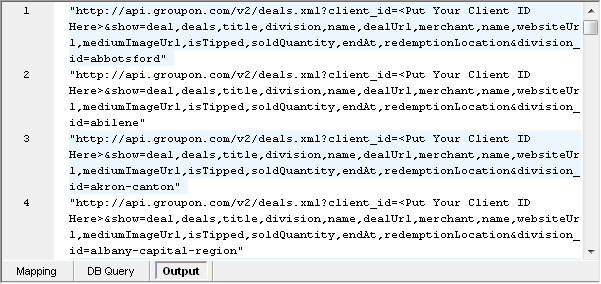 Now we can drop the revised .xsd file into the mapping and connect the list of API /deals queries as dynamic input. We don’t need to delete the text file we used to collect the list of queries — that might continue to be helpful for future debugging.
Now we can drop the revised .xsd file into the mapping and connect the list of API /deals queries as dynamic input. We don’t need to delete the text file we used to collect the list of queries — that might continue to be helpful for future debugging.  These changes complete the input side of the data mapping. Defining the Data Transformation Output Back in XMLSpy we can make a couple more revisions to the input XML Schema to design a new version for output:
These changes complete the input side of the data mapping. Defining the Data Transformation Output Back in XMLSpy we can make a couple more revisions to the input XML Schema to design a new version for output: 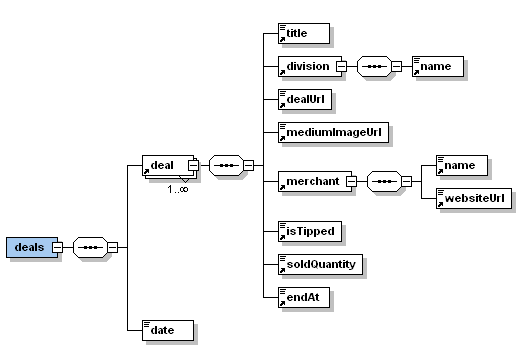 We discarded the response element since it doesn’t add any value, and eliminated the redemptionLocation element that we don’t intend to include in the output. We also added a date element for a timestamp, because our output file will be a snapshot of data that is constantly changing. After saving this version of the .xsd file in XMLSpy, we can drop it into the MapForce mapping. Shown below is the output side of the mapping with the output component partially connected. The filter at the top reads the redemptionLocation element to select only online deals and the now function inserts the date:
We discarded the response element since it doesn’t add any value, and eliminated the redemptionLocation element that we don’t intend to include in the output. We also added a date element for a timestamp, because our output file will be a snapshot of data that is constantly changing. After saving this version of the .xsd file in XMLSpy, we can drop it into the MapForce mapping. Shown below is the output side of the mapping with the output component partially connected. The filter at the top reads the redemptionLocation element to select only online deals and the now function inserts the date:  The last revision we made in the output XML Schema was to change several element types from dateTime, Boolean, and integer to the string data type to allow more descriptive text Here is the complete definition of the mapping with the final connections to the output component:
The last revision we made in the output XML Schema was to change several element types from dateTime, Boolean, and integer to the string data type to allow more descriptive text Here is the complete definition of the mapping with the final connections to the output component:  Now for the Payoff When we click the Output button MapForce processes the entire mapping from beginning to end using the MapForce Built-in execution engine. Here’s a breakdown of the steps:
Now for the Payoff When we click the Output button MapForce processes the entire mapping from beginning to end using the MapForce Built-in execution engine. Here’s a breakdown of the steps:
Let’s Make a Deal Like Yogi Berra said, you can observe a lot just by looking. Let’s start by running a /deals query in XMLSpy. That will let us examine the response to a query for one division before we pull in a potentially unwieldy volume of data. The XMLSpy File / Open menu includes the same Switch to URL option we used in MapForce in the earlier post. If we enter the /deals API query for a division that covers a large metro area – say Dallas – we are likely to get enough deals instances to extrapolate the characteristics of the entire data set. XMLSpy opens the response to the /deals API query in Text view just as if we opened a local file:
MapForce takes only a few seconds to complete all those steps and generate an output file with a series of deals that look like this: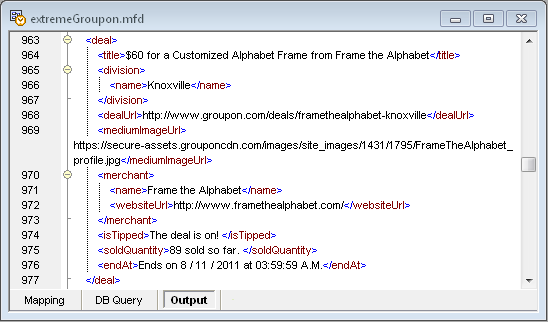 In part 3 of this series we’ll design a stylesheet to automatically transform the XML output of our mapping into html for attractive presentation in a web browser and on mobile devices. See ya at the ballpark, Yogi! XMLSpy and MapForce are available together in the specially priced Altova MissionKit. See for yourself how easy it is to use the MissionKit to convert data from a Web API — download a free 30-day trial!
In part 3 of this series we’ll design a stylesheet to automatically transform the XML output of our mapping into html for attractive presentation in a web browser and on mobile devices. See ya at the ballpark, Yogi! XMLSpy and MapForce are available together in the specially priced Altova MissionKit. See for yourself how easy it is to use the MissionKit to convert data from a Web API — download a free 30-day trial!
Editor’s Note: Our original series on mapping data from the Groupon API ran in three parts you can see by clicking the links here: Part 1 of Processing the Groupon API with Altova MapForce describes how to create dynamic input by collecting data from multiple URLs. Processing the Groupon API with MapForce – Part 2 describes how we filtered data from the API and defined the output to extract only the most interesting details. Processing the Groupon API – Part 3 describes formatting the output as a single HTML document optimized for desktop and mobile devices, and reviews ways to automate repeat execution.
The PXF File as the Software Equivalent of Plug and Play – A Database Editing Use Case
A few weeks ago we introduced you to the Portable XML Form (PXF), a file format in which all design elements supporting a StyleVision design including XML Schema and instance documents, SPS design files, XSLT, images, and other external files are embedded. End users simply open the PXF file in Authentic and can immediately start editing XML and database data.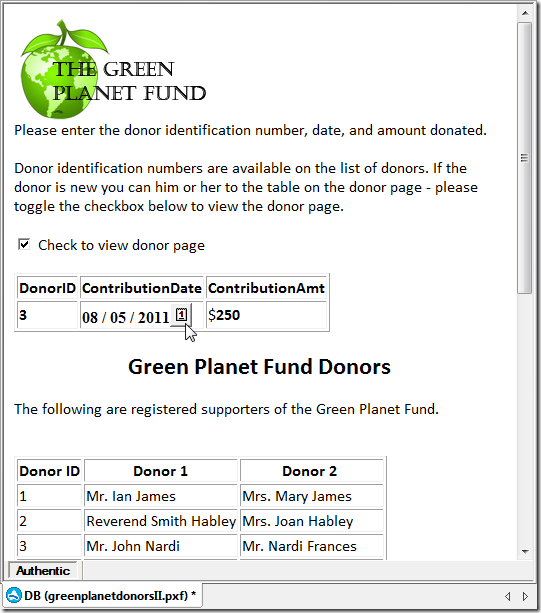 In this post we’ll create an electronic form for business users to record donations and enter new donors for a fictitious charity called the Green Planet Fund.
In this post we’ll create an electronic form for business users to record donations and enter new donors for a fictitious charity called the Green Planet Fund.
Altova’s new PXF file format is a boon to developers and end users alike –the PXF file can be transported, downloaded, copied, and saved like any other office document, increasing both efficiency and error-free deployments. Developers no longer have to send or install multiple files or create a server application to support a design and business users can distribute critical business information quickly and reliably. This is especially true in distributed organizations where business data needs to be sent around via e-mail between different locations or between field employees and their counterparts in the home office. A PXF that supports electronic forms designed in StyleVision and edited by business users in Authentic makes editing business data a snap. In most cases that business data will be contained directly within the PXF file as an embedded XML document, but it is also possible to connect a PXF file to a database server and store the data directly in the database, as the following use case shows.
For this example we’ll be using StyleVision to create an electronic form on which business users will record donations and enter new donors for the fictitious Green Planet Fund. End users interact with these forms in the Authentic WYSIWYG editor, a sophisticated word processor-style interface that allows end users to capture, view, and update XML and database content. Once you click File, New from DB in StyleVision, the Connection Wizard is invoked. Simply select the database type – you will be prompted to browse for the source. Here we’ve identified the DonorsDatabase from the MARKETING006SQLEXPRESS server. The connection string is automatically saved with the design file and re-established each time a business user accesses the form in Authentic. The database is updated with the information that the business user enters in the Authentic form.
Here we’ve identified the DonorsDatabase from the MARKETING006SQLEXPRESS server. The connection string is automatically saved with the design file and re-established each time a business user accesses the form in Authentic. The database is updated with the information that the business user enters in the Authentic form.  Once you establish a connection, you can select tables, data views and even SQL SELECT statements in the Insert Database Objects dialog box.
Once you establish a connection, you can select tables, data views and even SQL SELECT statements in the Insert Database Objects dialog box.  For this example we’ve added a SQL SELECT statement (below) that concatenates donor title, first name, and last name and calculates the total amount contributed by each donor. Once you click Add SELECT Statement the SQL SELECT statement becomes available to the StyleVision design, as seen above.
For this example we’ve added a SQL SELECT statement (below) that concatenates donor title, first name, and last name and calculates the total amount contributed by each donor. Once you click Add SELECT Statement the SQL SELECT statement becomes available to the StyleVision design, as seen above.  Please note that we used Altova DatabaseSpy, a multi-database query, design, and database comparison tool, to build our SQL statement. Although you can export data from the SQL Editor in DatabaseSpy into a range of formats, for this example we simply copied the SELECT statement from DatabaseSpy into the window in the SQL SELECT dialog box in StyleVision. StyleVision generates a temporary XML Schema based on the structure of the database and displays it in the Schema Window. Note that both the Contributions and Donors tables as well as our SQL SELECT statement appear in the Schema Tree.
Please note that we used Altova DatabaseSpy, a multi-database query, design, and database comparison tool, to build our SQL statement. Although you can export data from the SQL Editor in DatabaseSpy into a range of formats, for this example we simply copied the SELECT statement from DatabaseSpy into the window in the SQL SELECT dialog box in StyleVision. StyleVision generates a temporary XML Schema based on the structure of the database and displays it in the Schema Window. Note that both the Contributions and Donors tables as well as our SQL SELECT statement appear in the Schema Tree.  During this transformation StyleVision creates internal XML files – a non-editable one for previews and as the source of the generated XML data file as well as an editable XML file that will write modifications back to the database. Now that we’ve established and saved the database connection string we’re ready to design the electronic form that Green Planet Fund will use to add new donors and log contributions. For this example we’ve created two simple tables in StyleVision – one for recording contributions and another for looking up and adding donors. (Please note that our example is for illustrative purposes only and we’ve shown only a small sample of the fields that we would typically include in a real-world application. The functionality too is far less sophisticated than it would be in an actual project.) We’ve done the following to our design: · Created a design fragment with a table for entering new donors and a table of registered donors that is populated dynamically · Added a checkbox that when toggled will show the registered donors table and the data entry table from the design fragment · Edited the Authentic properties of the registered donors table to retrieve all records · Edited the Authentic properties of the data entry table to retrieve only one record to make it easier to enter data · Used XPath to concatenate each donor’s title, first, and last names for the table of registered donors, using the normalize-space function to remove all white spaces · Used Value Formatting (below) to format the contribution date – this also allows the end user to edit the date via a calendar interface in Authentic
During this transformation StyleVision creates internal XML files – a non-editable one for previews and as the source of the generated XML data file as well as an editable XML file that will write modifications back to the database. Now that we’ve established and saved the database connection string we’re ready to design the electronic form that Green Planet Fund will use to add new donors and log contributions. For this example we’ve created two simple tables in StyleVision – one for recording contributions and another for looking up and adding donors. (Please note that our example is for illustrative purposes only and we’ve shown only a small sample of the fields that we would typically include in a real-world application. The functionality too is far less sophisticated than it would be in an actual project.) We’ve done the following to our design: · Created a design fragment with a table for entering new donors and a table of registered donors that is populated dynamically · Added a checkbox that when toggled will show the registered donors table and the data entry table from the design fragment · Edited the Authentic properties of the registered donors table to retrieve all records · Edited the Authentic properties of the data entry table to retrieve only one record to make it easier to enter data · Used XPath to concatenate each donor’s title, first, and last names for the table of registered donors, using the normalize-space function to remove all white spaces · Used Value Formatting (below) to format the contribution date – this also allows the end user to edit the date via a calendar interface in Authentic  Note the design fragment ‘DonorList’ is enclosed within the DB tags and is represented as a single element. The design fragment itself appears at the bottom of the design.
Note the design fragment ‘DonorList’ is enclosed within the DB tags and is represented as a single element. The design fragment itself appears at the bottom of the design. 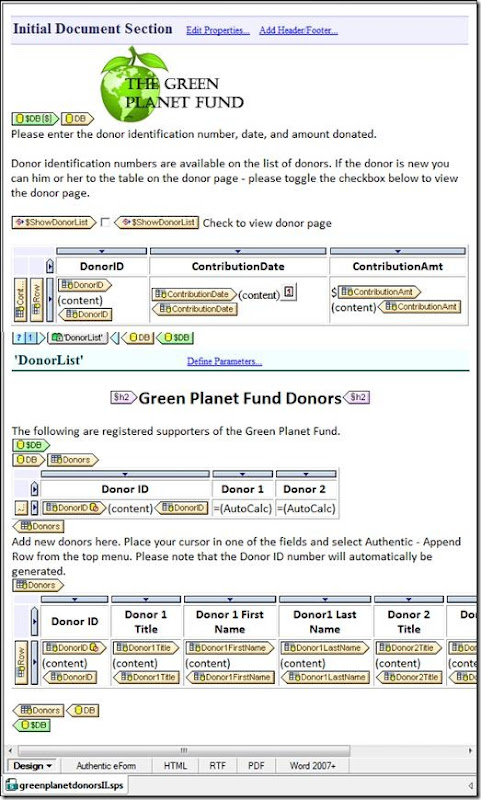 Clicking the tabs next to the Design tab will render the report in different formats. Here we’ve presented the Authentic view.
Clicking the tabs next to the Design tab will render the report in different formats. Here we’ve presented the Authentic view.  Notice that the design is still in standard SPS format (greenplanetdonorsII.sps) – we are now ready to save it as a PXF so that it can be emailed to the client and deployed immediately upon receipt. Once you select File – Save As from the top menu, you can choose whether to save the design as a SPS or PXF.
Notice that the design is still in standard SPS format (greenplanetdonorsII.sps) – we are now ready to save it as a PXF so that it can be emailed to the client and deployed immediately upon receipt. Once you select File – Save As from the top menu, you can choose whether to save the design as a SPS or PXF.  When you Save as PXF File you are prompted to select the files to embed in the PXF file. All files supporting the StyleVision design are automatically made available in the dialog box.
When you Save as PXF File you are prompted to select the files to embed in the PXF file. All files supporting the StyleVision design are automatically made available in the dialog box.  Here we’ve checked each of the design elements as well as the XSLT files. This will allow end users to generate output from the StyleVision-designed form in each of these formats directly from Authentic. Please note that you also have the option to include additional files. Although this design does not require other files, this feature makes transporting and deploying projects that require multiple files significantly easier. Now you can send the PXF file that you have just created to the client. All project files as well as the database connection string are embedded in the PXF so that once the end user opens it in Authentic he can immediately start viewing, editing, and entering data. To create a new record in Authentic, place the cursor in one of the fields in the contributions table on the form and click the Append row button on the tool bar. (Alternatively you can select Authentic – Append Row from the top menu.)
Here we’ve checked each of the design elements as well as the XSLT files. This will allow end users to generate output from the StyleVision-designed form in each of these formats directly from Authentic. Please note that you also have the option to include additional files. Although this design does not require other files, this feature makes transporting and deploying projects that require multiple files significantly easier. Now you can send the PXF file that you have just created to the client. All project files as well as the database connection string are embedded in the PXF so that once the end user opens it in Authentic he can immediately start viewing, editing, and entering data. To create a new record in Authentic, place the cursor in one of the fields in the contributions table on the form and click the Append row button on the tool bar. (Alternatively you can select Authentic – Append Row from the top menu.)  Now the business user can enter contributions (new data is in bold) …
Now the business user can enter contributions (new data is in bold) …  …and new donors.
…and new donors. 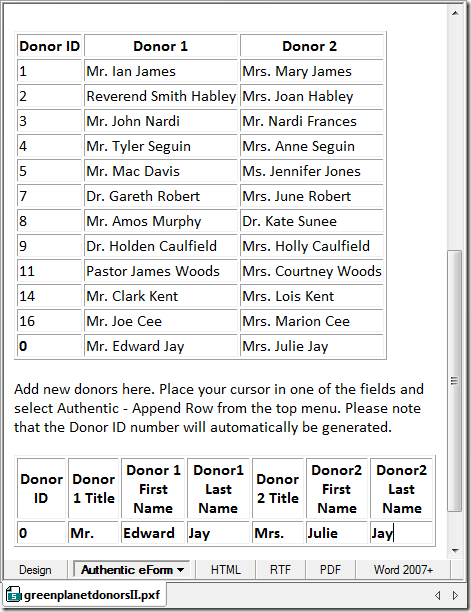 Note that in the SQL Server database the Donor ID is an auto-generated field. Once the end user clicks File – Save from the top menu, the new information is posted to the database, the database generates an ID number, and the new information populates the other tables in the form. (As reflected above, data is populated in real time.) Edits and additions are immediately written to the database. The SQL Server database view below shows that Edward and Julie Jay, whom we have just added to the Authentic form, have been assigned a donor id of 18.
Note that in the SQL Server database the Donor ID is an auto-generated field. Once the end user clicks File – Save from the top menu, the new information is posted to the database, the database generates an ID number, and the new information populates the other tables in the form. (As reflected above, data is populated in real time.) Edits and additions are immediately written to the database. The SQL Server database view below shows that Edward and Julie Jay, whom we have just added to the Authentic form, have been assigned a donor id of 18. 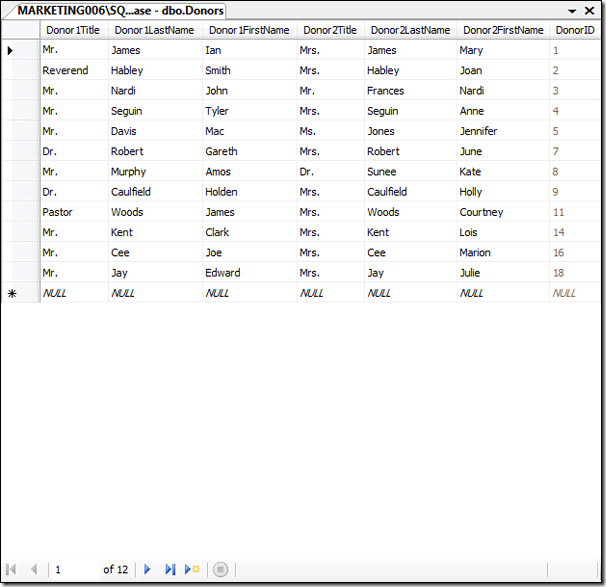 Although we did not include it here, the form can be designed to generate an error message when the user attempts to save a new donor without at least one first and last name. This can be accomplished using XPath in the additional validation property of the Authentic properties or by creating a constraint in the SQL Server database. This use case was designed to show how easy it is to create and deploy interactive forms. Electronic forms designed in StyleVision have always been a great way to update both XML and database content – the PXF file simply makes it easier to transport and deploy them.
Although we did not include it here, the form can be designed to generate an error message when the user attempts to save a new donor without at least one first and last name. This can be accomplished using XPath in the additional validation property of the Authentic properties or by creating a constraint in the SQL Server database. This use case was designed to show how easy it is to create and deploy interactive forms. Electronic forms designed in StyleVision have always been a great way to update both XML and database content – the PXF file simply makes it easier to transport and deploy them.
Have you used the PXF form yet? Or created a really cool database project using StyleVision or any of Altova’s other tools? Please share your story with other Altova users by commenting on this blog post. Think it would make a great case study? Email us at marketing@altova.com – if we use your story you’ll receive a $200 Amazon gift card. We’d love to hear from you!
Processing the Groupon API with Altova MapForce
We often think of a data integration project as a translation from one singular data input file to some other data set, but Altova MapForce lets you greatly expand the concept of an input file. For instance, the MergeMultipleFiles.mfd example installed with MapForce illustrates how you can use a filename with wildcard characters to merge multiple input files into a single output.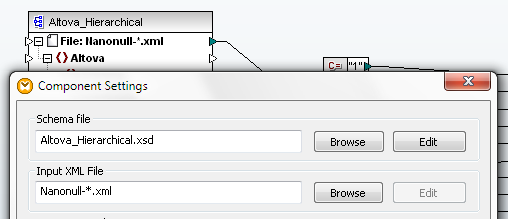 A MapForce mapping input doesn’t even need to be a physical file – it can be a URL that returns predictable structured data, like the APIs for popular Web sites like Groupon and many others.
A MapForce mapping input doesn’t even need to be a physical file – it can be a URL that returns predictable structured data, like the APIs for popular Web sites like Groupon and many others.
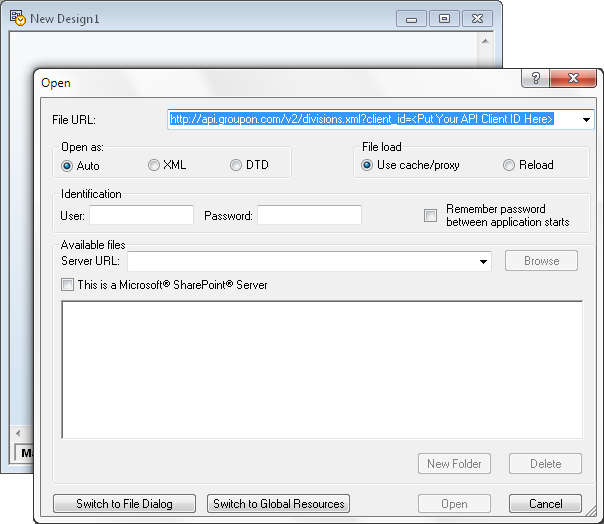 When we click the Open button MapForce offers to generate the schema:
When we click the Open button MapForce offers to generate the schema: 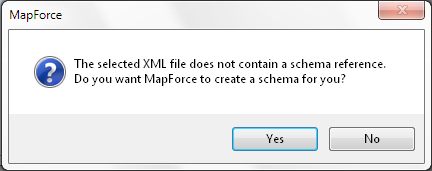 When we click Yes, the File / Save dialog opens. I saved the schema as divisions.xsd, and the mapping with the new XML Schema inserted looks like this:
When we click Yes, the File / Save dialog opens. I saved the schema as divisions.xsd, and the mapping with the new XML Schema inserted looks like this: 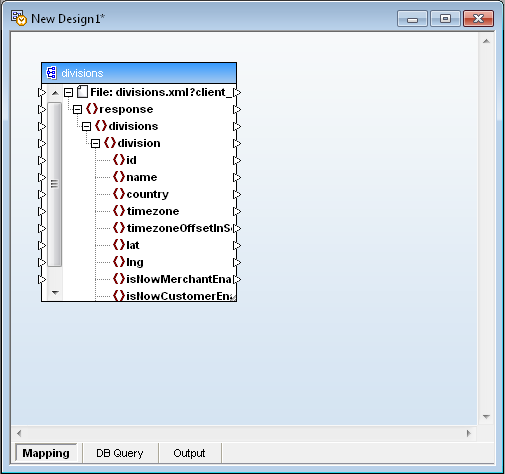 And the Properties dialog for the XML Schema component automatically contains the API /divisions URL as the Input XML File:
And the Properties dialog for the XML Schema component automatically contains the API /divisions URL as the Input XML File:  Check the Work We want to filter the Groupon divisions data to build a list of id names to use for deal queries for each locality. But before we go any further, now might be a good time to apply the text file trick from the Quick Solution for Complicated Functions blog post to look at the id values. When we insert the text file and connect the divisions and id schema elements, the mapping looks like this:
Check the Work We want to filter the Groupon divisions data to build a list of id names to use for deal queries for each locality. But before we go any further, now might be a good time to apply the text file trick from the Quick Solution for Complicated Functions blog post to look at the id values. When we insert the text file and connect the divisions and id schema elements, the mapping looks like this: 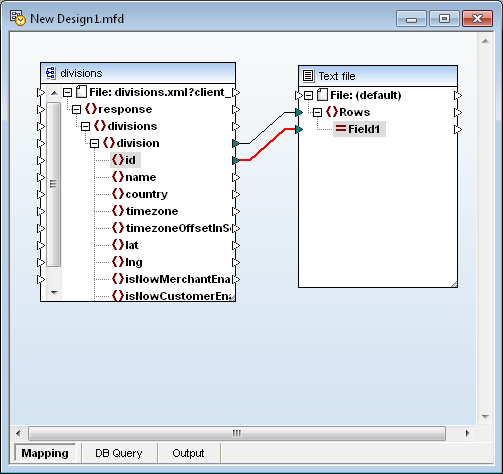 We connected the division element to Rows in the text file in order to generate a new row in the text file for each unique division, so that Field1 in each row will hold the id. Clicking the Output button now generates this result:
We connected the division element to Rows in the text file in order to generate a new row in the text file for each unique division, so that Field1 in each row will hold the id. Clicking the Output button now generates this result: 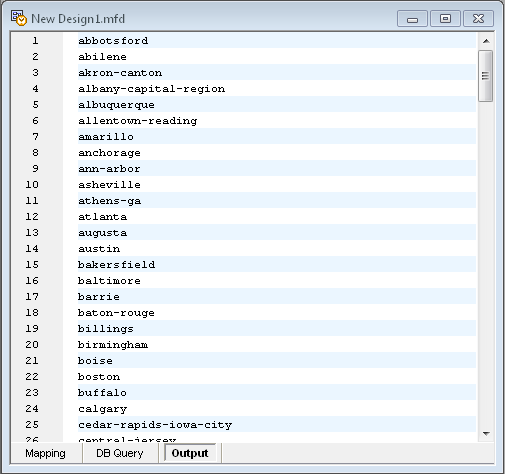 All we need to do is apply the concat string function to build the list of /deal URLs for all division IDs. The next step in the mapping looks like this:
All we need to do is apply the concat string function to build the list of /deal URLs for all division IDs. The next step in the mapping looks like this: 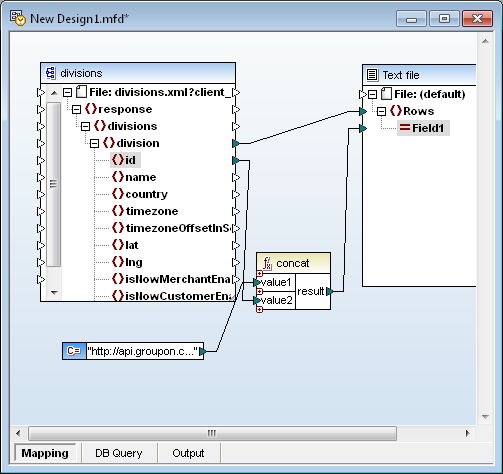 Rolling the cursor over the constant connected to value1 of the concat function displays its full definition:
Rolling the cursor over the constant connected to value1 of the concat function displays its full definition:  When we click the Output button to execute the mapping, the Output file now looks like this:
When we click the Output button to execute the mapping, the Output file now looks like this: 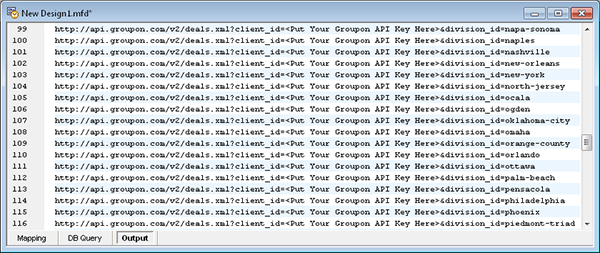 As a further review, we can open the generated XML Schema in XMLSpy and display it in graphical Schema View:
As a further review, we can open the generated XML Schema in XMLSpy and display it in graphical Schema View: 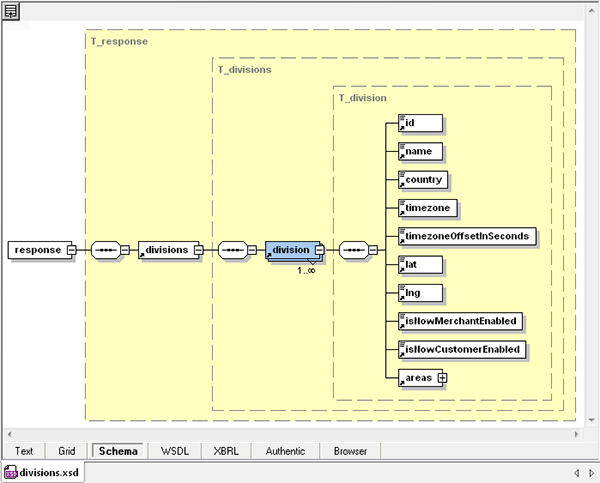 So far we have:
So far we have:
In this blog post we’ll describe how to use Altova tools to retrieve, filter, analyze, and present data available from a Web-based API, using Groupon as an example. If you want to follow along yourself, you will first need to visit http://www.groupon.com/pages/api to request your personal Groupon API client key. The Problem: All Deals Are Local The Groupon Web site and email subscriptions are great for finding deals in your local neighborhood, but what if you’re looking for a deal to use on an upcoming vacation, or for a gift for friends or family across the country? Sure, you could enter each location manually at the Groupon Web page, but that’s so last century. Let’s use the Altova MissionKit to automate things. The Groupon API offers two URL queries that return data in .json or .xml formats: the first returns a list of all Groupon localities (called divisions), and the second returns current deals information for one named division. If we want to see all the deals for more than one division, we need to resolve multiple URLs and aggregate the data into a single result. Yes, MapForce can do that! First We Need a Schema The Groupon API documentation describes the elements that will be returned by our requests, but doesn’t provide an XML Schema. That’s okay, we can use MapForce to generate one. All we have to do is open a new mapping design and choose Insert XML Schema/File, then click the Switch to URL button. Now we can enter the URL to retrieve the Groupon divisions list:
In the next post in this series we will process the list of deal queries as the input for a new mapping component and filter the output for some interesting information. Find out for yourself how easy it is to apply MapForce to convert data from a Web API! Download a free 30-day trial of MapForce.
Editor’s Note: Our original series on mapping data from the Groupon API ran in three parts you can see by clicking the links here: Part 1 of Processing the Groupon API with Altova MapForce describes how to create dynamic input by collecting data from multiple URLs. Processing the Groupon API with MapForce – Part 2 describes how we filtered data from the API and defined the output to extract only the most interesting details. Processing the Groupon API – Part 3 describes formatting the output as a single HTML document optimized for desktop and mobile devices, and reviews ways to automate repeat execution.
UML Class Diagrams in Altova UModel
Altova products have long been recognized for their rich, intuitive user interface. One example is the UModel diagram window, which includes multiple display options for class diagrams to facilitate ease of use and improve information clarity in objected-oriented models. Class diagram style for projects that generate .NET (C# and Visual Basic) application code UModel 2011 Release 3 includes a new option for displaying class diagrams for .NET programmers. If your project will generate source code in .NET programming languages (C# or Visual Basic), your classes may contain .NET properties that can be called from outside like attributes, but are implemented internally as methods. To better organize .NET classes, UModel offers an option to display .NET properties and methods in separate operations compartments inside classes.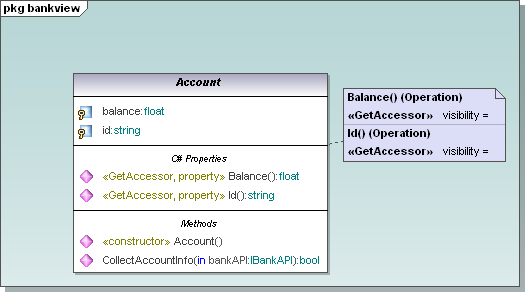 This view is an optional setting in the Styles helper window for class diagram display and editing. Choosing to display separate .NET properties compartments or a single traditional UML operations compartment has no influence on code generated from the class.
This view is an optional setting in the Styles helper window for class diagram display and editing. Choosing to display separate .NET properties compartments or a single traditional UML operations compartment has no influence on code generated from the class.
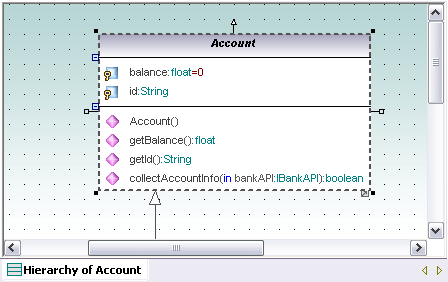
View or Hide Class Properties and Operations Developers can collapse Properties and Operations compartments using convenient grab handle tools along the right edge. They can also customize the display of classes to show or hide individual class properties and operations. The right-click context menu offers a Visible Elements dialog for any selected class.
This feature lets users simplify the diagram to focus on the properties and operations relevant to the task at hand. Hidden items are indicated by ellipses. Clicking on an ellipsis re-opens the Visible elements dialog. Options for Interface Notation UModel 2011 supports alternate diagram styles for interfaces between classes. By default, new interfaces are created in class diagram style with arrowhead styles and notations to indicate the interface creator and interface users. In the class diagram below, the developer wants to concentrate on class relationships and interfaces, so all the properties and operations compartments are collapsed.
Clicking on an ellipsis re-opens the Visible elements dialog. Options for Interface Notation UModel 2011 supports alternate diagram styles for interfaces between classes. By default, new interfaces are created in class diagram style with arrowhead styles and notations to indicate the interface creator and interface users. In the class diagram below, the developer wants to concentrate on class relationships and interfaces, so all the properties and operations compartments are collapsed.  Interfaces have a special Toggle Notation quick-editing button to switch from the class diagram style to the UML ball and socket interface notation.
Interfaces have a special Toggle Notation quick-editing button to switch from the class diagram style to the UML ball and socket interface notation. 
 Visibility Icons vs. Mathematical Operators The UModel visibility icons, along with the visibility pull-down menus in the drawing window and properties menu, have been praised because they avoid confusion with common mathematical operators that can also appear in definitions of properties and operations. But users who prefer the traditional view can choose UML Style in the Project Styles helper window.
Visibility Icons vs. Mathematical Operators The UModel visibility icons, along with the visibility pull-down menus in the drawing window and properties menu, have been praised because they avoid confusion with common mathematical operators that can also appear in definitions of properties and operations. But users who prefer the traditional view can choose UML Style in the Project Styles helper window. 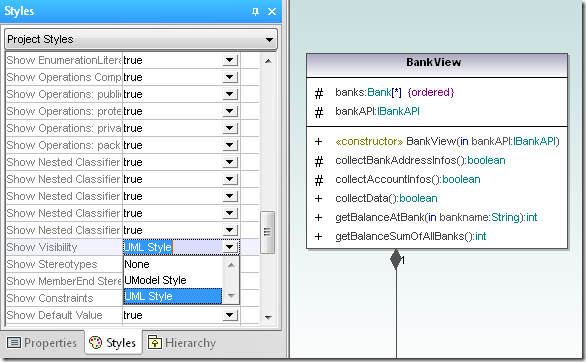 All the style settings selected to display class diagrams on screen are also applied when rendering project documentation in Word, RTF, or .html formats Find out for yourself how you can improve development of your object-oriented application by customizing the display of class diagrams with Altova UModel – download a free 30-day trial today!
All the style settings selected to display class diagrams on screen are also applied when rendering project documentation in Word, RTF, or .html formats Find out for yourself how you can improve development of your object-oriented application by customizing the display of class diagrams with Altova UModel – download a free 30-day trial today!
Service Pack 1 Available
Just a quick note to let customers of Altova Software Version 2011 Release 3 know that Service Pack 1 (v2011r3 SP1) is now available for all Altova products. In addition to bug fixes, SP1 includes important enhancements:
Please note that v2011r3 SP1 is a new product version (not a patch). All customers with a license for Altova Software v2011r3, as well as any customer with an active Support and Maintenance Package for their Altova product(s), can simply download and install this update.
Visit the Altova Team at FOSE
Use Built-In XPath Functions
In developing one of the Altova Online Training courses, I sorted a list of books by the authors. I realized that my author field was a string of the author’s full name, so the books were sorted by the first letter of the string, or the author’s first name. It did not fit into the course to fix the sorting, but you can easily extract the last name from a string and use it for the sorting key using XPath functions. If you then use the books’ titles for a secondary sort key, you run into an issue with titles that start with “A”, “An”, or “The”. I want to use the title for the secondary sort key, but ignore a leading definite or indefinite article.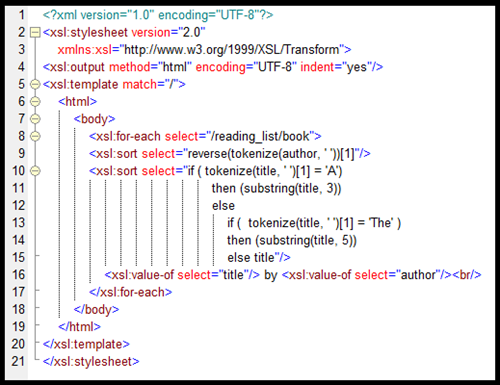 Let’s take a look at how we created this XSLT code.
Let’s take a look at how we created this XSLT code.
 An XSLT to create a list of the books would look like this:
An XSLT to create a list of the books would look like this: 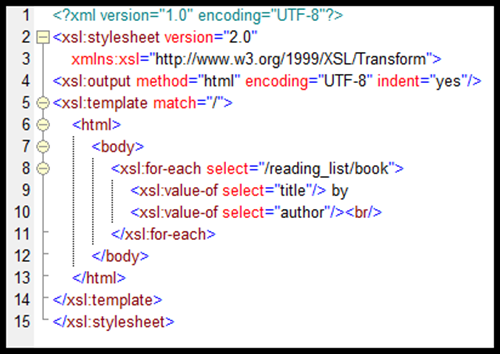 This will generate the following output:
This will generate the following output:  The books are output in the order they appear in the original data file. If we add xsl:sort to the xsl:for-each loop, we can arrange our output in other ways.
The books are output in the order they appear in the original data file. If we add xsl:sort to the xsl:for-each loop, we can arrange our output in other ways. 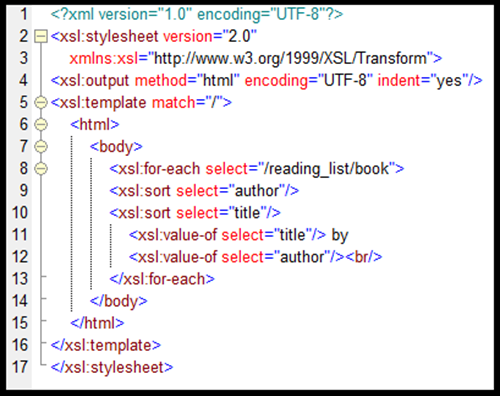 This will generate a sorted list, but not sorted properly.
This will generate a sorted list, but not sorted properly.  Sorting author as a string, results in “Jules Verne” appearing ahead of “Mark Twain”. Also, “A Connecticut Yankee in King Arthur’s Court” appears ahead of “Adventures of Huckleberry Finn”. We want to ignore the indefinite article, “A”, so that “Adventures of Huckleberry Finn” appears ahead of “A Connecticut Yankee in King Arthur’s Court”. We can use XPath expressions to extract the sorting keys we want.
Sorting author as a string, results in “Jules Verne” appearing ahead of “Mark Twain”. Also, “A Connecticut Yankee in King Arthur’s Court” appears ahead of “Adventures of Huckleberry Finn”. We want to ignore the indefinite article, “A”, so that “Adventures of Huckleberry Finn” appears ahead of “A Connecticut Yankee in King Arthur’s Court”. We can use XPath expressions to extract the sorting keys we want.  Let’s examine the code before we look at the output. We replace “author” with “reverse(tokenize(author, ‘ ‘))[1]”. Tokenize breaks the author string into tokens using a single white space as the break point. So, “Jules Verne” is tokenized into “Jules” and “Verne”. Reverse reverses the order of the tokens to “Verne” and “Jules”. The one in square brackets chooses the first item in the list, “Verne”. This is the value that is used in for the xsl:sort function to arrange the books. This is not the perfect solution, but it works in our case. The title looks convoluted, but the logic is straightforward. The “tokenize(title,’ ‘)[1]” expression extracts the first word of the title. So, the first if test is “Is the first word of the title the word “A”? “. If it is, then we return the substring of the title that starts with its third letter, thus eliminating “A” and the space. If the first word of the title is not “A”, then we need to test it again to see if the first word of the title is “The”. If it is, we use the substring of the title starting with its fifth character, thus eliminating “The” and a space. If we fail both tests, then we just pass the title along as the sorting key. We could add another test to our code to see if the first word is “An”, but it is not needed for this data set. Executing this last XSLT, we get the following output.
Let’s examine the code before we look at the output. We replace “author” with “reverse(tokenize(author, ‘ ‘))[1]”. Tokenize breaks the author string into tokens using a single white space as the break point. So, “Jules Verne” is tokenized into “Jules” and “Verne”. Reverse reverses the order of the tokens to “Verne” and “Jules”. The one in square brackets chooses the first item in the list, “Verne”. This is the value that is used in for the xsl:sort function to arrange the books. This is not the perfect solution, but it works in our case. The title looks convoluted, but the logic is straightforward. The “tokenize(title,’ ‘)[1]” expression extracts the first word of the title. So, the first if test is “Is the first word of the title the word “A”? “. If it is, then we return the substring of the title that starts with its third letter, thus eliminating “A” and the space. If the first word of the title is not “A”, then we need to test it again to see if the first word of the title is “The”. If it is, we use the substring of the title starting with its fifth character, thus eliminating “The” and a space. If we fail both tests, then we just pass the title along as the sorting key. We could add another test to our code to see if the first word is “An”, but it is not needed for this data set. Executing this last XSLT, we get the following output.  “Mark Twain” is now ahead of “Jules Verne”. “Adventures of Huckleberry Finn” appears ahead of “The Celebrated Jumping Frog of Calaveras County” and “A Connecticut Yankee in King Arthur’s Court”. The flaw in our approach to the author string is that we want “Jules Verne” to be treated as “Verne, Jules” for the sort, so that if we had a book by “Jimmy Verne”, the sort would treat them as different authors. Our code does not. Using “concat(reverse(tokenize(author, ‘ ‘))[1], reverse(tokenize(author, ‘ ‘))[2])” would sort “Jules Verne” and “Jimmy Verne” correctly, but this solution only will work with 2 word names. If an author had a suffix (“Martin Luther King, Jr.”) or multiple words (“George Herbert Walker Bush”), the code would fail. There are many exceptions to the general rules on alphabetizing names, and the code to allow for all variants goes far beyond the scope of this article. What we wanted to show was the ability to manipulate XML data on the fly using XPath expressions. We do not always have complete control on the format of our data sources, but using the power of XPath expressions, we can transform the data into the format that we need. A copy of the files used in these examples is available here.
“Mark Twain” is now ahead of “Jules Verne”. “Adventures of Huckleberry Finn” appears ahead of “The Celebrated Jumping Frog of Calaveras County” and “A Connecticut Yankee in King Arthur’s Court”. The flaw in our approach to the author string is that we want “Jules Verne” to be treated as “Verne, Jules” for the sort, so that if we had a book by “Jimmy Verne”, the sort would treat them as different authors. Our code does not. Using “concat(reverse(tokenize(author, ‘ ‘))[1], reverse(tokenize(author, ‘ ‘))[2])” would sort “Jules Verne” and “Jimmy Verne” correctly, but this solution only will work with 2 word names. If an author had a suffix (“Martin Luther King, Jr.”) or multiple words (“George Herbert Walker Bush”), the code would fail. There are many exceptions to the general rules on alphabetizing names, and the code to allow for all variants goes far beyond the scope of this article. What we wanted to show was the ability to manipulate XML data on the fly using XPath expressions. We do not always have complete control on the format of our data sources, but using the power of XPath expressions, we can transform the data into the format that we need. A copy of the files used in these examples is available here.
This article was written using XMLSpy as the platform, but the same XPath expressions can be used inside MapForce or StyleVision to achieve similar results. We can start with a simple XML book list. We have 4 books with author and title nodes.
The Maryland Association of Certified Public Accountants (MACPA) transforms data to XBRL in-house
What is XBRL and how can it help your organization? Members of the Maryland Association of CPAs (MACPA) found out how using the interactive XBRL (Extensible Business Reporting Language) format can help not only larger, public companies, but also smaller, non-profit organizations like themselves. MACPA invested in the Altova MissionKit tool suite to support their XBRL project. Using our XMLSpy XML editor; MapForce, our graphical data mapping, conversion, and integration tool; and the StyleVision visual stylesheet and report design tool, MACPA was able develop a comprehensive system that employs XBRL data for a variety of reporting functions, both internal and external.
MACPA invested in the Altova MissionKit tool suite to support their XBRL project. Using our XMLSpy XML editor; MapForce, our graphical data mapping, conversion, and integration tool; and the StyleVision visual stylesheet and report design tool, MACPA was able develop a comprehensive system that employs XBRL data for a variety of reporting functions, both internal and external. MapForce also came in handy for mapping the Global Ledger (GL) Taxonomy to the extended GAAP taxonomy.
MapForce also came in handy for mapping the Global Ledger (GL) Taxonomy to the extended GAAP taxonomy.  As a result, MACPA has increased its working knowledge of XBRL, automated previously burdensome data collection and transformation tasks, and have gained more insight into their financial data. To read more about how MACPA utilized the Altova MissionKit to convert all their financial data to XBRL and create a model for public and private business of any size to leverage the powers of XBRL, the latest case study from Altova is a must read! Do you have a story to tell about your use of Altova tools? If so, we want to hear from you. Case studies generate great publicity. Check out recent press coverage from the MACPA case study. Plus, if we choose to use your story you will receive a $200 Amazon gift card!
As a result, MACPA has increased its working knowledge of XBRL, automated previously burdensome data collection and transformation tasks, and have gained more insight into their financial data. To read more about how MACPA utilized the Altova MissionKit to convert all their financial data to XBRL and create a model for public and private business of any size to leverage the powers of XBRL, the latest case study from Altova is a must read! Do you have a story to tell about your use of Altova tools? If so, we want to hear from you. Case studies generate great publicity. Check out recent press coverage from the MACPA case study. Plus, if we choose to use your story you will receive a $200 Amazon gift card!
For example, MACPA used the generated instance document from MapForce to populate their financial Key Performance Indicator (KPI) system, significantly reducing the amount of time and effort required to prepare the KPI documentation. XMLSpy was used to extend the US-GAAP taxonomy to accommodate entries specific to MACPA.
A Quick Solution for Complicated Functions
Some data conversions require multiple steps to satisfy today’s complex data communication requirements. Altova MapForce 2011 lets you graphically combine a wide variety of mathematical, logical, string, and other specialized functions to build complicated "data equations" to get the results you need. If you’re working on a big, complicated mapping, if you’re using an unfamiliar function for the first time, or when your function creates an intermediate result that needs further processing, it is helpful to test your work each step of the way as you build. You can use a simple text file as a temporary target to see the output of your function under construction. Let’s say we want to add a date and time stamp to an existing mapping of an output file to record the time the data was generated. We can easily experiment with the MapForce now function in a new mapping that simply connects now to a text file.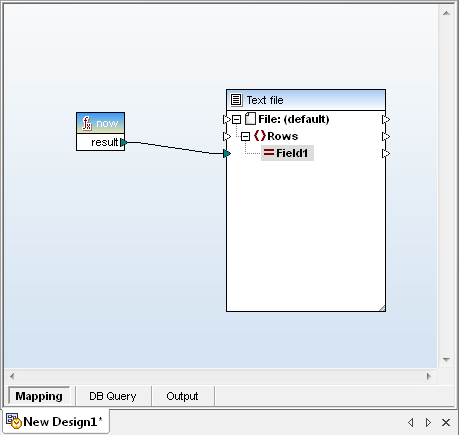 Clicking the Output button at the bottom of the mapping window shows us the immediate result:
Clicking the Output button at the bottom of the mapping window shows us the immediate result:
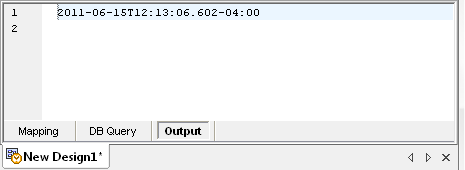 Okay, that works, but maybe the consumer of the output file would like to see a more elegantly formatted version. We can work with various datetime and string functions and build a complicated function until our mapping looks like this:
Okay, that works, but maybe the consumer of the output file would like to see a more elegantly formatted version. We can work with various datetime and string functions and build a complicated function until our mapping looks like this: 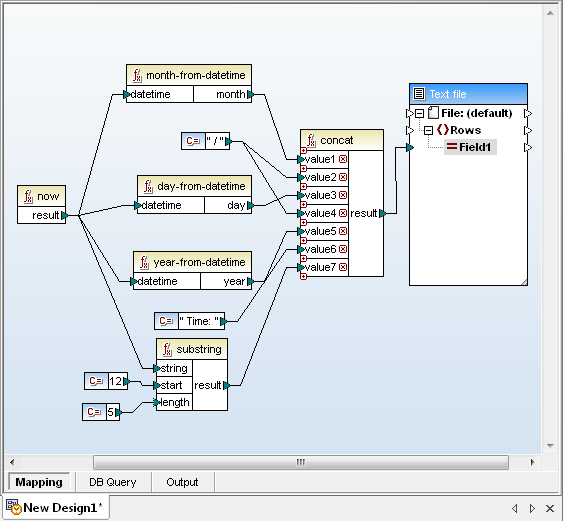 Or we could simply use the format-dateTime conversion function with a string constant to define the format:
Or we could simply use the format-dateTime conversion function with a string constant to define the format: 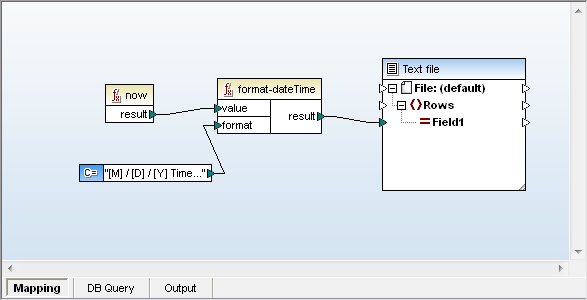 As we work, we can press the Output button at any time, until we are satisfied with a result that looks like this:
As we work, we can press the Output button at any time, until we are satisfied with a result that looks like this:  If you don’t work with dateTime data types every day, it’s hard to write a format string on your first try that generates the desired result! After several attempts, variations, and consultations with MapForce Help, here’s the format we developed and stored in the string constant connected to the format input of the format-dateTime conversion function:
If you don’t work with dateTime data types every day, it’s hard to write a format string on your first try that generates the desired result! After several attempts, variations, and consultations with MapForce Help, here’s the format we developed and stored in the string constant connected to the format input of the format-dateTime conversion function: 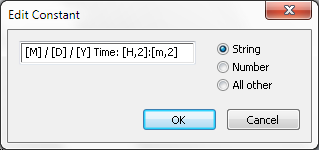 So far we used a text file that was defined as a basic CSV file with only a single field, but you can open the file Properties dialog and add fields or create a more customized output file.
So far we used a text file that was defined as a basic CSV file with only a single field, but you can open the file Properties dialog and add fields or create a more customized output file. 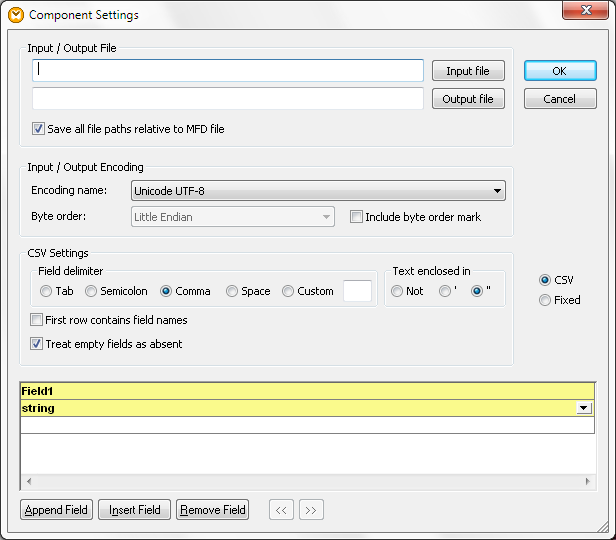 One advantage of using a text file as the output target is there is no type checking of the function result, so the text file target lets you examine and verify the output of any function. In the screenshot below we created a mathematical function and added a second field to the text file target to map the result.
One advantage of using a text file as the output target is there is no type checking of the function result, so the text file target lets you examine and verify the output of any function. In the screenshot below we created a mathematical function and added a second field to the text file target to map the result. 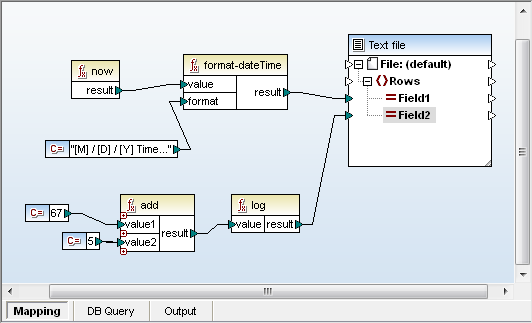 Now the output is a single-row, comma separated result like this:
Now the output is a single-row, comma separated result like this:  If our ultimate target is going to be a database field or an XML element with an integer data type, then we can immediately see this mathematical function doesn’t produce the expected datatype. When you have perfected your function in the test mapping, you can simply select, copy, and paste it directly into your larger mapping. You can then connect the output of the function to your ultimate target. In the screen shot below our format dateTime function is mapped to an element in an XML schema that is defined as a string.
If our ultimate target is going to be a database field or an XML element with an integer data type, then we can immediately see this mathematical function doesn’t produce the expected datatype. When you have perfected your function in the test mapping, you can simply select, copy, and paste it directly into your larger mapping. You can then connect the output of the function to your ultimate target. In the screen shot below our format dateTime function is mapped to an element in an XML schema that is defined as a string. 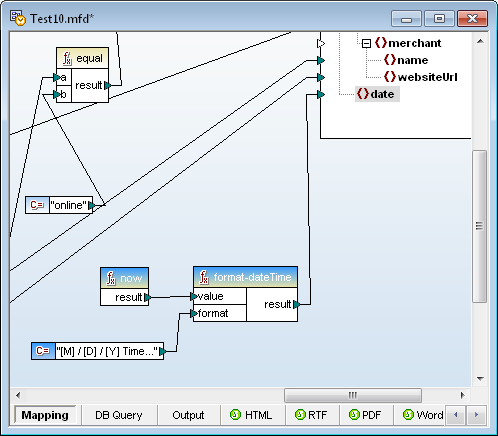 If this is a function you are likely to want again in the future, you can convert it to a User-Defined Function and save it in your library for convenient reuse.
If this is a function you are likely to want again in the future, you can convert it to a User-Defined Function and save it in your library for convenient reuse.  You can even use a text file as a temporary target to build and test a complicated function right inside your larger mapping. In that case, your mapping includes multiple possible outputs. The eyeball button at the top right of each output file selects which output file is displayed in the Output window.
You can even use a text file as a temporary target to build and test a complicated function right inside your larger mapping. In that case, your mapping includes multiple possible outputs. The eyeball button at the top right of each output file selects which output file is displayed in the Output window. 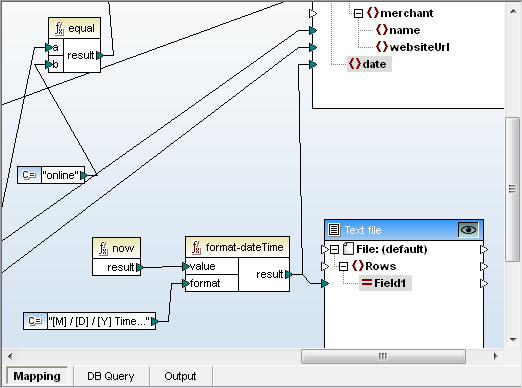 When you select the text file as the Output preview, the MapForce execution engine does not process the larger mapping, only the function connected to the text file. This can be a huge time-saver when you just want to examine the function result and your larger mapping processes a large volume of data, or if you don’t want to risk inserting invalid data into a database, and in many other situations. Find out for yourself how easy it is to apply MapForce to your own data mapping projects! Download a free 30-day trial of MapForce.
When you select the text file as the Output preview, the MapForce execution engine does not process the larger mapping, only the function connected to the text file. This can be a huge time-saver when you just want to examine the function result and your larger mapping processes a large volume of data, or if you don’t want to risk inserting invalid data into a database, and in many other situations. Find out for yourself how easy it is to apply MapForce to your own data mapping projects! Download a free 30-day trial of MapForce.
Directory Sync Tools: Move over little dog, a new DiffDog is moving in
Altova DiffDog was originally launched in 2005 as a diff/merge tool with XML-aware functionality to help users identify differences between XML files. It even identifies files that are XML-equivalent but appear different in a text comparison because of spacing, line-ending, or attribute order variations.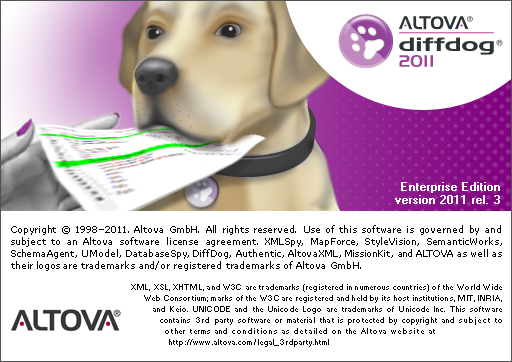 DiffDog has continually improved over time with many new features including:
DiffDog has continually improved over time with many new features including:
DiffDog 2011 Release 3 adds a new simplified directory sync feature to its robust folder diff/merge functionality. The Synchronize Directories dialog now includes a button at the top to select a complete directory sync in a single step. The Fully Synchronize feature produces an exact copy of the source directory, even if the target has newer versions of some files, and deletes files from the target that don’t exist on the source, making this choice a quick tool to backup complex directories containing many files and sub-folders. DiffDog provides a summary of all actions to be taken before any files are copied or deleted:
The Fully Synchronize feature produces an exact copy of the source directory, even if the target has newer versions of some files, and deletes files from the target that don’t exist on the source, making this choice a quick tool to backup complex directories containing many files and sub-folders. DiffDog provides a summary of all actions to be taken before any files are copied or deleted:  If you want to prevent a file being overwritten or deleted from the target directory, you can click Cancel, and then use the Manual Override feature to ignore or reverse the copy direction for any file pair.
If you want to prevent a file being overwritten or deleted from the target directory, you can click Cancel, and then use the Manual Override feature to ignore or reverse the copy direction for any file pair.  Pretty good trick for an app that’s older than 42 in dog years*, isn’t it? Find out for yourself how DiffDog can faithfully synchronize your directories – download a fully-functional, free 30-day trial! * Popular myth suggests that one calendar year for a software developer is equivalent to 7 years in the life of a dog. For a more complete discussion of canine lifespan, see the Wikipedia article titled Aging in Dogs.
Pretty good trick for an app that’s older than 42 in dog years*, isn’t it? Find out for yourself how DiffDog can faithfully synchronize your directories – download a fully-functional, free 30-day trial! * Popular myth suggests that one calendar year for a software developer is equivalent to 7 years in the life of a dog. For a more complete discussion of canine lifespan, see the Wikipedia article titled Aging in Dogs.
It’s Here – the Industry’s First Truly Portable XML Form
Hopefully by now you’ve downloaded the 2011r3 versions of the Altova product line released last week. We’ve introduced a bunch of new features and functionalities that put even more power into the hands of IT professionals. (Note: If you haven’t already done so, you can download the latest versions of all of the tools in the Altova product suite from our Web site.) One of the features we’re most excited about is the new Portable XML Form (PXF) file for StyleVision and Authentic. The PXF is a file into which all elements required to support a StyleVision design including XML Schemas, database connections, images, etc. can be embedded. Imagine the possibilities! In this post we’ll take an in-depth look at the PXF file format as well as some use cases.
One of the features we’re most excited about is the new Portable XML Form (PXF) file for StyleVision and Authentic. The PXF is a file into which all elements required to support a StyleVision design including XML Schemas, database connections, images, etc. can be embedded. Imagine the possibilities! In this post we’ll take an in-depth look at the PXF file format as well as some use cases.
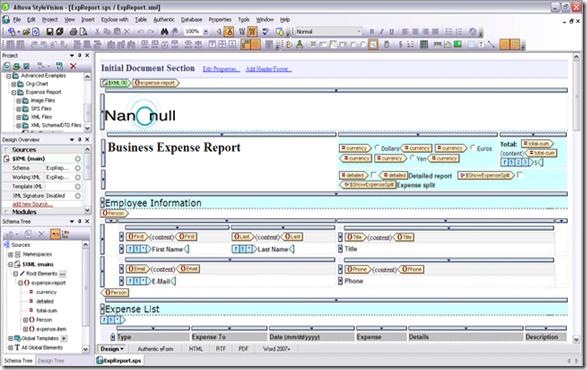 Once the design is complete, creating a PXF file is as easy as selecting Save As and toggling the Save as PXF file radio button.
Once the design is complete, creating a PXF file is as easy as selecting Save As and toggling the Save as PXF file radio button. 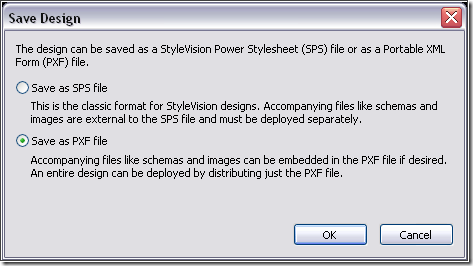 When prompted to select files to embed in the PXF, remember to check the output formats that end users will be able to publish content in.
When prompted to select files to embed in the PXF, remember to check the output formats that end users will be able to publish content in.  With all design elements now embedded in the PXF file, you can distribute the form easily and efficiently.
With all design elements now embedded in the PXF file, you can distribute the form easily and efficiently.
When you create a design in StyleVision and then save it as a PXF file, all design elements including XML Schema and instance documents, SPS design files, XSLT, images, and other external files are embedded in the PXF. The PXF file can be transported, downloaded, copied, and saved like any other data file, meaning that developers no longer have to send or install multiple files to support a design. This is especially useful for integrating Authentic electronic forms into your projects – and consequently great news for business users. Authentic electronic forms created in StyleVision allow business users to edit databases and XML files without wrangling with database and XML syntax. The PXF file makes developing – and using – these forms even easier. Take, for example, the bane of many a business traveler’s existence – the expense report. Fortunately for the IT professional using Altova tools the expense report is a snap – a developer can create an eye-catching report that meets the business needs of the client by taking advantage of StyleVision’s many design capabilities.
The PXF is a boon to business users as well as developers. Depending on how you deploy the expense report, business users can access it via Authentic Desktop or in their browser with the Authentic Browser Plug-in. As he would with any Authentic form, an end user simply opens the PXF file in Authentic Desktop and can immediately begin editing or adding data. The associated XML file or database is updated automatically to reflect the changes. End users accessing an Authentic form via the Authentic Browser Plug-in likewise update XML and database data by entering and editing information in the form.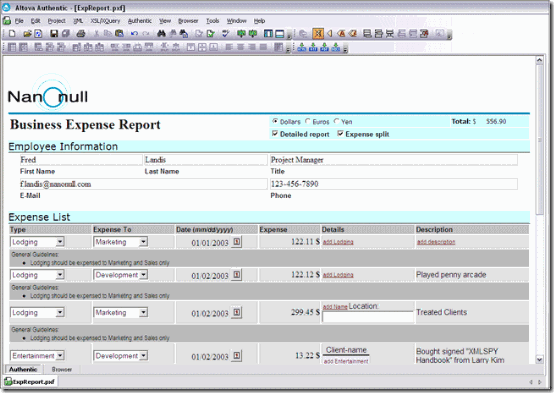 The value of the PXF for end users is the same as for the developer – portability. Because the PXF file contains all of the files necessary to support the Authentic form, including the instance document, the business user can enter his expense data, resave the file, and then send the PXF to the accounting department. He can even email the PXF directly from the application.
The value of the PXF for end users is the same as for the developer – portability. Because the PXF file contains all of the files necessary to support the Authentic form, including the instance document, the business user can enter his expense data, resave the file, and then send the PXF to the accounting department. He can even email the PXF directly from the application.  The PXF file also provides business users with the ability to publish content in multiple output formats. In our example the developer clicked HTML, RTF, PDF, and Word 2007+ in the Configure Portable XML Form (PXF) dialog box. A business user can instantly create an output document in each of these formats by clicking one of the output buttons on the menu bar.
The PXF file also provides business users with the ability to publish content in multiple output formats. In our example the developer clicked HTML, RTF, PDF, and Word 2007+ in the Configure Portable XML Form (PXF) dialog box. A business user can instantly create an output document in each of these formats by clicking one of the output buttons on the menu bar.  Here we’ve clicked the PDF button, generating a document that a business traveler can mail to the corporate office, keep for his records, etc.
Here we’ve clicked the PDF button, generating a document that a business traveler can mail to the corporate office, keep for his records, etc. 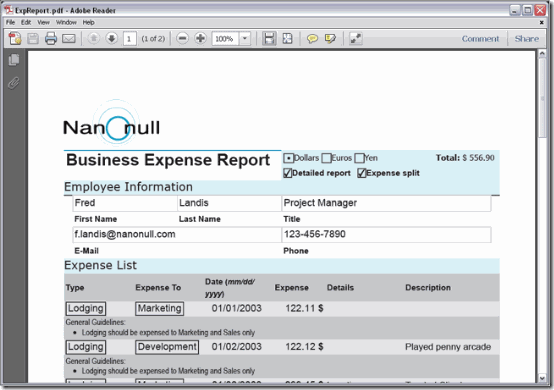 Although the portability afforded by the PXF significantly increases the value of electronic forms by simplifying the process of getting critical business data into XML, Authentic forms in general are an easy sell to business users. In addition to comprehensive editing capabilities, Authentic enhances the business value of electronic forms through features that include real-time validation of input data, industry standard XML templates, project management support, and dynamic layout based on user input. In addition to all of the functionality and editing capabilities Authentic offers, the application can compete on price – the Authentic Community Edition is free. We hope that you are as intrigued by the possibilities offered by PXF as we are. By providing developers an easy way to integrate electronic forms into their projects and a simple (and free) way for business users to distribute and publish information, PXF could radically transform the process of creating and editing XML and database content. This is a truly exciting prospect. For those of you not yet using our tools, this is a perfect time to give them a try. Click here to download free, fully functional trial versions of our software. They’re good for 30 days!
Although the portability afforded by the PXF significantly increases the value of electronic forms by simplifying the process of getting critical business data into XML, Authentic forms in general are an easy sell to business users. In addition to comprehensive editing capabilities, Authentic enhances the business value of electronic forms through features that include real-time validation of input data, industry standard XML templates, project management support, and dynamic layout based on user input. In addition to all of the functionality and editing capabilities Authentic offers, the application can compete on price – the Authentic Community Edition is free. We hope that you are as intrigued by the possibilities offered by PXF as we are. By providing developers an easy way to integrate electronic forms into their projects and a simple (and free) way for business users to distribute and publish information, PXF could radically transform the process of creating and editing XML and database content. This is a truly exciting prospect. For those of you not yet using our tools, this is a perfect time to give them a try. Click here to download free, fully functional trial versions of our software. They’re good for 30 days!
Have you used the PXF form yet? How did you use it? Please share your story with other Altova users by commenting on this blog post. Think it would make a great case study? Email us at marketing@altova.com. We’d love to hear from you!
Release 3 of Altova Software Version 2011
What is PXF?
PXF is a new file format that – finally – makes editable XML forms truly portable. PXF files are configured in StyleVision 2011r3, where a developer creates a design that generates an interactive electronic form that can then be accessed and edited by non-technical business users in Altova Authentic (or in the Authentic View in XMLSpy). When the StyleVision design is saved as a PXF, the XML Schema(s), XML instance(s), electronic form, etc., are all embedded in the PXF file. The PXF can even optionally include the XSLT files autogenerated by StyleVision that allow the business user to publish his data in HTML, Word, RTF, and/or PDF – with a single click. After a PXF file has been created, it can be transported, downloaded, copied, and saved like any other data file. Why PXF? The benefit of the PXF file format is that all the components required for editing XML content – and for the generation of output reports from Authentic – can be conveniently distributed in a single file. And, since Authentic Community Edition is a free product, PXF deployment couldn’t be more affordable.
Why PXF? The benefit of the PXF file format is that all the components required for editing XML content – and for the generation of output reports from Authentic – can be conveniently distributed in a single file. And, since Authentic Community Edition is a free product, PXF deployment couldn’t be more affordable.  There are countless usage scenarios for the PXF file, but one example is to allow a business user to easily get important data into a valid XML document and send it back to the requester or to another department, such as HR or Accounting. The user receives a PXF file by email and opens it in Authentic. The XML file will be displayed in Authentic using the embedded StyleVision eForm design, and can be edited using the word processor-like Authentic interface with access to advanced interactive options, context sensitive entry-helpers, business logic validation, and more. The File | Save command saves changes to the PXF, i.e., the embedded XML is modified and saved. The File | Send by E-mail command makes it easy to send the updated PXF on to another user with a single click. In addition, when XSLT files associated with the SPS are included in the PXF, Authentic toolbar buttons let the user render his data in multiple formats for publishing or further communication. PXF takes the headache out of getting critical business data into XML – without sacrificing any of the benefits that XML brings to data integration and extensibility.
There are countless usage scenarios for the PXF file, but one example is to allow a business user to easily get important data into a valid XML document and send it back to the requester or to another department, such as HR or Accounting. The user receives a PXF file by email and opens it in Authentic. The XML file will be displayed in Authentic using the embedded StyleVision eForm design, and can be edited using the word processor-like Authentic interface with access to advanced interactive options, context sensitive entry-helpers, business logic validation, and more. The File | Save command saves changes to the PXF, i.e., the embedded XML is modified and saved. The File | Send by E-mail command makes it easy to send the updated PXF on to another user with a single click. In addition, when XSLT files associated with the SPS are included in the PXF, Authentic toolbar buttons let the user render his data in multiple formats for publishing or further communication. PXF takes the headache out of getting critical business data into XML – without sacrificing any of the benefits that XML brings to data integration and extensibility.
XML Digital Signatures
To address the growing need for security around XML transmissions, v2011r3 includes support for assigning and verifying XML digital signatures through the implementation of W3C XML Signature technology across multiple MissionKit tools. An XML Signature enables digital authentication for XML transactions by checking the integrity (whether the data has changed since it was signed) and the authenticity of origin (the identity of the signer). In contrast to other digital signature methods, XML Signature is uniquely suited to working with XML data because it includes measures for canonicalization, which involves signing the important data while ignoring inconsequential changes such as whitespace and line endings. In XMLSpy 2011r3, it’s easy to add an enveloped, enveloping, or detached signature to your XML-based files using either certificate e or password-based authentication. You can also verify signature(s) on files received. If the file changed at all since it was signed, verification will fail.
You can also verify signature(s) on files received. If the file changed at all since it was signed, verification will fail.  Other MissionKit tools with XML digital signature support include:
Other MissionKit tools with XML digital signature support include:
HIPAA Data Mapping
In addition to new features for Excel® data mapping and other enhancements, MapForce 2011r3 now includes native support for mapping HIPAA 5010 data. Health care enterprises that send or receive HIPAA information will be able to apply MapForce 2011 Release 3 to meet a number of requirements. Users of legacy healthcare IT systems that do not store data files internally in a format compliant with the latest HIPAA standard can use MapForce 2011r3 to map incoming HIPAA 5010 transactions to the enterprise internal format or database. Or, a MapForce mapping can be designed to generate HIPAA-compliant transactions for output from existing non-compliant data. If the enterprise wants to translate legacy healthcare data for internal storage in HIPAA 5010 format, MapForce 2011 Release 3 is the tool for that one-time transformation too!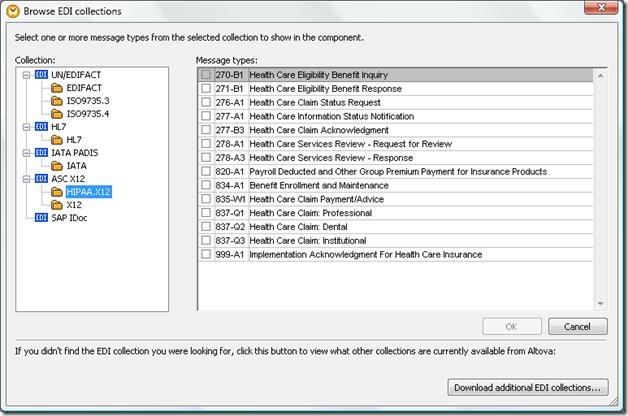 Native HIPAA support adds to current support for HL7 (Health Level 7) and other EDI standards. Check out all the features added in the latest Altova release, and stay tuned for more details here on the blog.
Native HIPAA support adds to current support for HL7 (Health Level 7) and other EDI standards. Check out all the features added in the latest Altova release, and stay tuned for more details here on the blog.
StyleVision Supports XBRL for Financial Reporting Part I – Creating GAAP-Compliant Reports and StyleSheets with a Single Click
Did you know that StyleVision is also an XBRL rendering and reporting tool that will allow you to create GAAP-compliant financial reports with the click of a button ?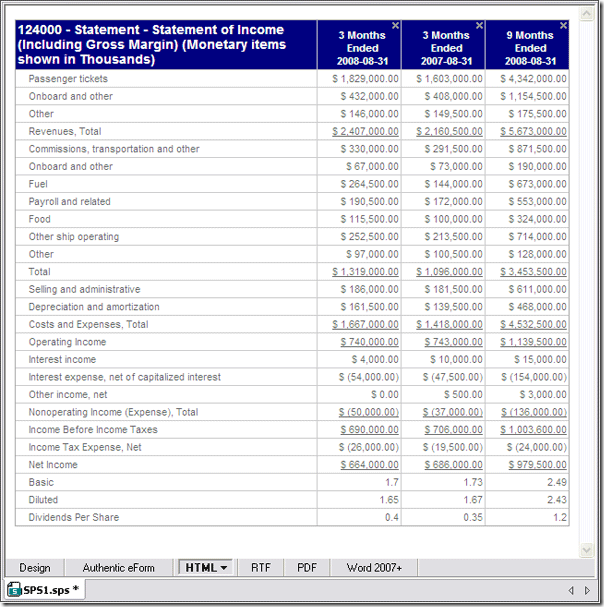
 To create a stylesheet or report, drag the appropriate presentation link into the design window (for this example we have selected 124000 – Statement – Statement of Income (Including Gross Margin)). You will be prompted to create an XBRL table, XBRL chart, or XBRL template.
To create a stylesheet or report, drag the appropriate presentation link into the design window (for this example we have selected 124000 – Statement – Statement of Income (Including Gross Margin)). You will be prompted to create an XBRL table, XBRL chart, or XBRL template. 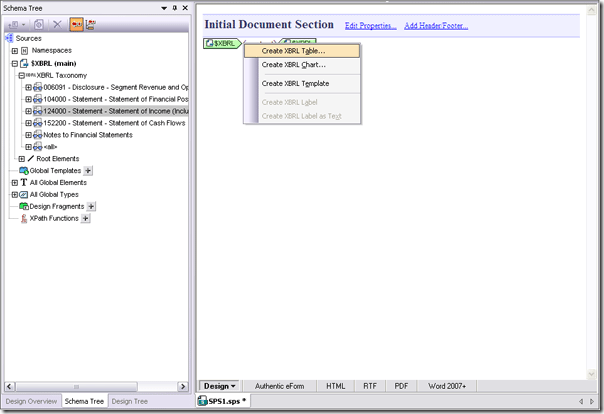 Selecting Create an XBRL Table will invoke the XBRL Table Wizard.
Selecting Create an XBRL Table will invoke the XBRL Table Wizard. 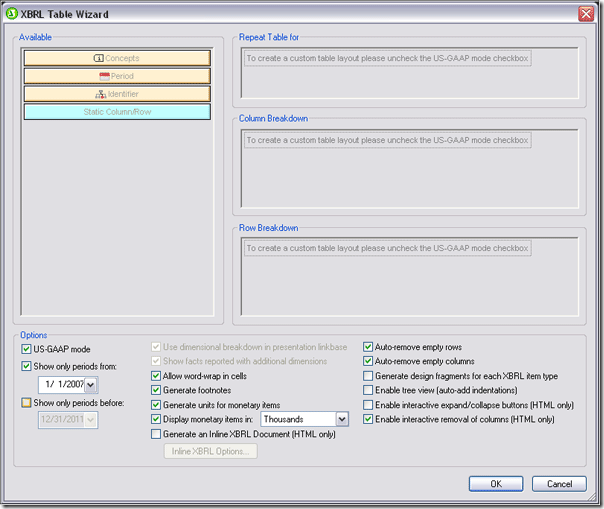 Note that under Options we have US-GAAP mode checked. If you check the US-GAAP mode box StyleVision will generate a table with all of the financial data in the presentation link selected. (You can select which period you would like represented under the Options tab as well). Output in HTML, RTF, PDF, and Word 2007+ formats, plus corresponding stylesheets, are automatically generated once you click OK. Although there are a number of formatting options in the Table Wizard, once the table is generated you can make additional changes (e.g., background color, font, text, table borders, etc.). In the example below we highlighted the <xbrli:instant> element and used Value Formatting to change how the time periods are represented. In the XBRL instance document, the time period appears in YYYYY-MM-DD – YYYY-MM-DD format. We have changed it to [Number of] Months Ending YYYY-MM-DD.
Note that under Options we have US-GAAP mode checked. If you check the US-GAAP mode box StyleVision will generate a table with all of the financial data in the presentation link selected. (You can select which period you would like represented under the Options tab as well). Output in HTML, RTF, PDF, and Word 2007+ formats, plus corresponding stylesheets, are automatically generated once you click OK. Although there are a number of formatting options in the Table Wizard, once the table is generated you can make additional changes (e.g., background color, font, text, table borders, etc.). In the example below we highlighted the <xbrli:instant> element and used Value Formatting to change how the time periods are represented. In the XBRL instance document, the time period appears in YYYYY-MM-DD – YYYY-MM-DD format. We have changed it to [Number of] Months Ending YYYY-MM-DD. 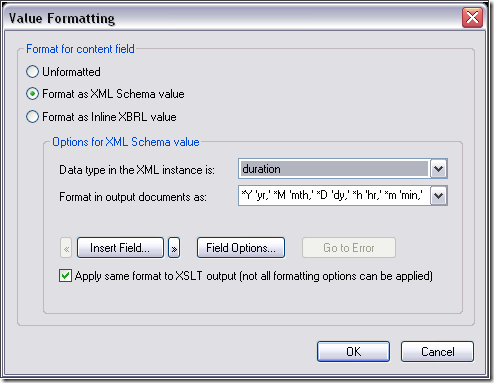 Notice the Styles window in the screenshot below – we’ve also changed the table header’s background color to navy and the text color to white.
Notice the Styles window in the screenshot below – we’ve also changed the table header’s background color to navy and the text color to white. 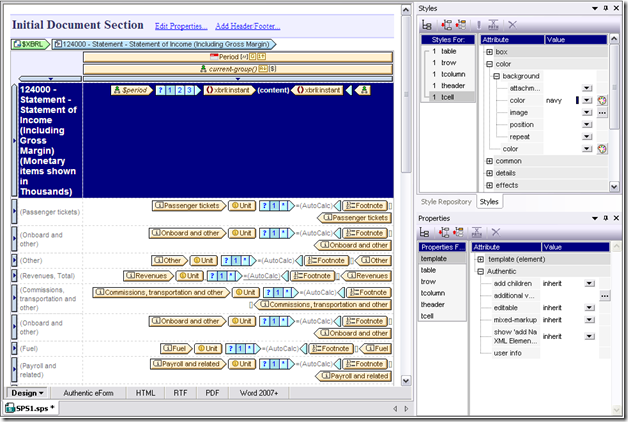 Sorting, grouping (via XPath), and filtering (via XPath) options can also be edited after the table is generated by the XBRL Table Wizard. Simply right click in the Period or current-group bar above the table header and select the appropriate function. The Group by … dialog box appears below.
Sorting, grouping (via XPath), and filtering (via XPath) options can also be edited after the table is generated by the XBRL Table Wizard. Simply right click in the Period or current-group bar above the table header and select the appropriate function. The Group by … dialog box appears below. 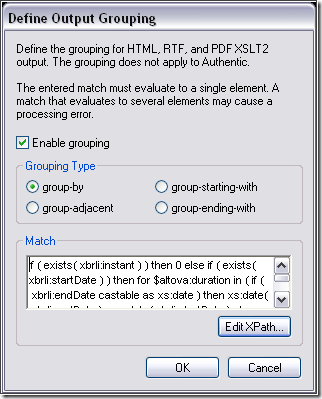 The GAAP-compliant table rendered in HTML appears below.
The GAAP-compliant table rendered in HTML appears below.  The HTML output above reflects the formatting options we selected in the XBRL Chart Wizard:
The HTML output above reflects the formatting options we selected in the XBRL Chart Wizard:
In this post we’ll show you how …
Altova’s native support for XBRL is great news for IT professionals serving a range of industries given the US Securities and Exchange Commission’s (SEC) formal embrace of XBRL as a financial reporting language. In fact, virtually all public companies using GAAP accounting will be required to submit financial data for fiscal periods ending on or after June 15, 2011 to the SEC in XBRL, an XML-based language. IT professionals will be called upon not only to facilitate the exchange of data but to render XBRL data in a manner intelligible to business users. StyleVision can help. With a number of built-in capabilities that allow you to create customized GAAP-compliant stylesheets and reports for XBRL data with only a few clicks, StyleVision can make you look like a technical – and accounting – whiz. When you create a new design from an XBRL taxonomy, StyleVision creates a schema tree that reflects the presentation linkbase, an XML file that includes sets of related concepts grouped under presentation links (e.g., in the example below, 006091- Disclosure – Segment Revenue and Operating Income is a presentation link). Typically the presentation linkbase will appear in the schema tree as discrete financial statements, addendums, disclosures, and the like (this will depend on the contents of the linkbase – and keep in mind that although standard not every XBRL taxonomy will have a linkbase). Individual root elements are also available for reporting/processing and appear below the presentation links.
One last thing to note is that in our example we have selected the entire presentation link 124000 – Statement – Statement of Income (Including Gross Margin) and all data in that presentation link is populated to the table. However if you expand the presentation link in the schema tree you can select individual line items or those grouped together from a presentation link and create a mini-table. This is just an overview of how you can use StyleVision’s built-in GAAP-compliant functionality to render XBRL data in some simple ways – the possibilities for presenting this data are virtually limitless. In future posts we’ll discuss using the XBRL Table Wizard to combine multiple line items from different presentation links for highly customized data presentation, creating powerful charts with the XBRL Chart Wizard, and other ways to help organizations leverage their XBRL data (we’ll even provide an example of how XBRL financial data can be used with other data sources to create an annual report).
Have you used Altova tools to create XBRL solutions for your clients? Please share your story with other Altova users by commenting on this blog post. Think it would make a great case study? Email us at marketing@altova.com. We’d love to hear from you!
Switch Statement vs. Look-up Table in MapForce
One of the great things about working with software developers is you not only get to create new things that never existed before, you also get to see how other peoples’ minds work when they discover alternate solutions to any design challenge. We received a comment from a software developer on our recent post titled Expandable If-Else Works like a Switch Statement in MapForce regarding one of the examples we used. The reader suggests that our second example illustrated a problem that would be more elegantly solved in Altova MapForce with Value-Map than by our Expanded If-Else statement. Here was the original example that received the month as a string of characters and needed to generate the corresponding number: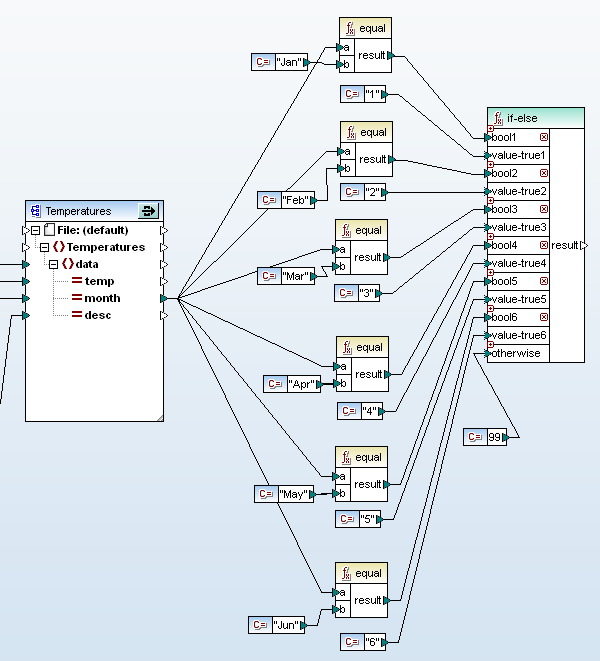 A Value-Map in MapForce is an alternate solution that functions as a look-up table, whereas an Expanded If-Else acts like a switch statement. Here is how our mapping would look with a Value-Map in place of the Expanded If-Else:
A Value-Map in MapForce is an alternate solution that functions as a look-up table, whereas an Expanded If-Else acts like a switch statement. Here is how our mapping would look with a Value-Map in place of the Expanded If-Else: 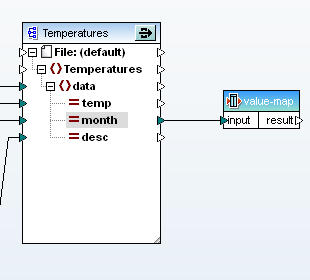 Yep, that’s it. Rather than copying, pasting, and modifying sets of elements the way we built our original Expanded If-Else, a Value-Map lets us easily create the entire look-up table in its Properties dialog:
Yep, that’s it. Rather than copying, pasting, and modifying sets of elements the way we built our original Expanded If-Else, a Value-Map lets us easily create the entire look-up table in its Properties dialog: 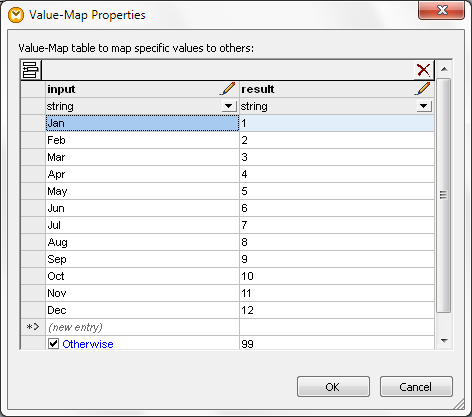 We accept the commenter’s point — Value-Map definitely works better for the problem we chose because it’s much quicker and easier to create! The table from the Value-Map properties is also more concise and easier to interpret in MapForce-generated mapping documentation than our original Expanded If-Else structure. Of course you can’t always replace an Expanded If-Else statement with a Value-Map. Data entering the Value-Map must equal a single value in the input table to generate a specific output, whereas Expanded If-Else lets you set up a series of conditions with different logical tests. Sometimes the exact nature of a data conversion project makes it a judgment call to use a switch element vs. a look-up table. Let’s say your project receives input as a number that represents a wavelength of the electromagnetic spectrum and you want to handle ultraviolet, visible colors, and infrared energy individually. In that case we could use an Expanded If-Else to test for ranges of input values. The Expanded If-Else section of the mapping might look like this:
We accept the commenter’s point — Value-Map definitely works better for the problem we chose because it’s much quicker and easier to create! The table from the Value-Map properties is also more concise and easier to interpret in MapForce-generated mapping documentation than our original Expanded If-Else structure. Of course you can’t always replace an Expanded If-Else statement with a Value-Map. Data entering the Value-Map must equal a single value in the input table to generate a specific output, whereas Expanded If-Else lets you set up a series of conditions with different logical tests. Sometimes the exact nature of a data conversion project makes it a judgment call to use a switch element vs. a look-up table. Let’s say your project receives input as a number that represents a wavelength of the electromagnetic spectrum and you want to handle ultraviolet, visible colors, and infrared energy individually. In that case we could use an Expanded If-Else to test for ranges of input values. The Expanded If-Else section of the mapping might look like this: 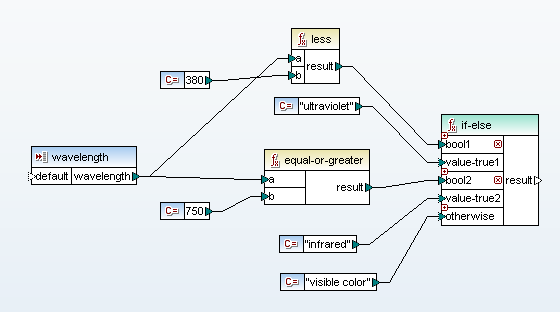 If the input is an integer, you could also create a solution using Value-Map, but you would need to build a very long look-up table. And then what happens later if the project requirements change and the input becomes a decimal number, or you need to filter each visible color separately by name? Essentially Altova MapForce is a really cool graphical representation of a complete software language toolbox that insulates you from detailed programming language syntax, with a rich collection of components you can assemble creatively to solve your own data mapping, conversion, and integration challenges. Find out for yourself how easy it is to apply MapForce to your own data mapping projects. Download a free 30-day trial of MapForce.
If the input is an integer, you could also create a solution using Value-Map, but you would need to build a very long look-up table. And then what happens later if the project requirements change and the input becomes a decimal number, or you need to filter each visible color separately by name? Essentially Altova MapForce is a really cool graphical representation of a complete software language toolbox that insulates you from detailed programming language syntax, with a rich collection of components you can assemble creatively to solve your own data mapping, conversion, and integration challenges. Find out for yourself how easy it is to apply MapForce to your own data mapping projects. Download a free 30-day trial of MapForce.
Visit Altova at Tech*Ed 2011
Diff / Merge for Databases
You may already be familiar with the diff/merge functionality Altova DiffDog brings to working with source code, XML, and Word files – but did you know you can also connect to, compare, and merge database data and structures? DiffDog supports all major relational databases and includes a Connection Wizard that lets you quickly connect to one or more. As shown in the screenshot below, natively supported databases include Microsoft® Access™, SQL Server®, Oracle®, MySQL®, IBM® DB2®, Sybase®, and PostgreSQL. When you compare different database types, DiffDog even resolves datatype naming inconsistencies. This means you can compare the customers table in your SQL Server database with a backup copy, for example, or you can compare the contents of any tables or your entire database schema between IBM DB2 9 and Oracle 11g implementations. Note: Altova DatabaseSpy includes the same diff/merge capabilities described here.
When you compare different database types, DiffDog even resolves datatype naming inconsistencies. This means you can compare the customers table in your SQL Server database with a backup copy, for example, or you can compare the contents of any tables or your entire database schema between IBM DB2 9 and Oracle 11g implementations. Note: Altova DatabaseSpy includes the same diff/merge capabilities described here.
Database Content Differencing
It’s easy to compare database content in DiffDog. Simply connect to the database(s) required, and select the tables to be compared. DiffDog displays the compared components side-by-side, and tables and columns are mapped automatically based on configurable options. You can also change or create mapping connections manually when needed. After you click the Start Comparison button, DiffDog displays results with informative icons. In the simple example below, the content in the database tables is not equal. Next, you can launch a detailed comparison of the unequal table to see the content of the compared columns side-by-side, with differences highlighted. Tool bar buttons let you merge changes in either direction.
Next, you can launch a detailed comparison of the unequal table to see the content of the compared columns side-by-side, with differences highlighted. Tool bar buttons let you merge changes in either direction. 
Database Schema Differencing
It’s just as easy to compare database schemas in DiffDog to, for example, identify and merge differences between a development and production version of the same database. All database items (e.g., data types, constraints, keys, etc.) are displayed in the comparison components so that you are able to compare the structure of the tables within the database schema. You can merge the two schemas or selected items using Left and Right buttons on the tool bar, or access more merging options via the right-click menu.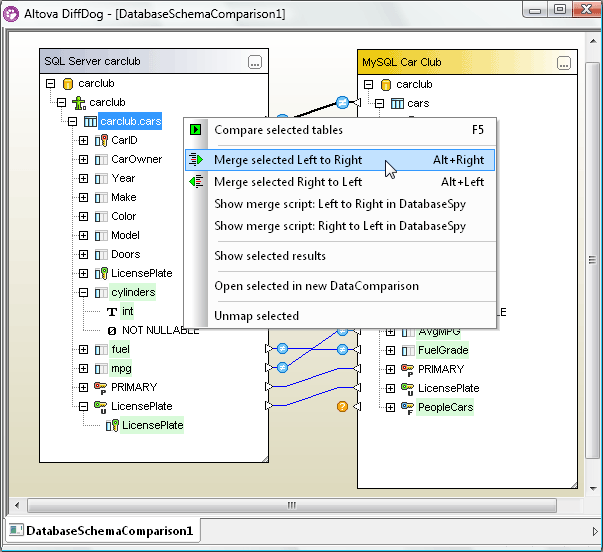 Database schema changes aren’t merged instantly – DiffDog always creates a SQL change script compatible with your target database type that you can review before committing the changes to the database.
Database schema changes aren’t merged instantly – DiffDog always creates a SQL change script compatible with your target database type that you can review before committing the changes to the database.  You can also save the SQL script to a file or open it for further editing in DatabaseSpy. Learn more about the powerful database diff/merge functionality in DiffDog. You can also download a free trial to give it a test drive.
You can also save the SQL script to a file or open it for further editing in DatabaseSpy. Learn more about the powerful database diff/merge functionality in DiffDog. You can also download a free trial to give it a test drive.
Solution to the Software Testing with State Machines Challenge
Last month in our blog on Software Testing for State Machines with Altova UModel we discovered unexpected behavior in our model of an air conditioning system and challenged readers to improve the design. This post describes one possible solution. When we ran the Tester application for our model, we saw that the Power switch did not turn the system off when it was in the Standby state. In the state machine diagram in our original model, the only route into Standby from Operating mode is via the Standby button, and the only way out of the Standby state is to press the Standby button again, as seen in the detail below. We can create an alternate exit to power off the system from the Standby state simply by drawing a new transition line from Standby to the Off state, and assigning powerButton() as the event that triggers the transition. UModel makes assigning the trigger easy by providing a pop-up window listing events that are already defined in the model.
We can create an alternate exit to power off the system from the Standby state simply by drawing a new transition line from Standby to the Off state, and assigning powerButton() as the event that triggers the transition. UModel makes assigning the trigger easy by providing a pop-up window listing events that are already defined in the model. 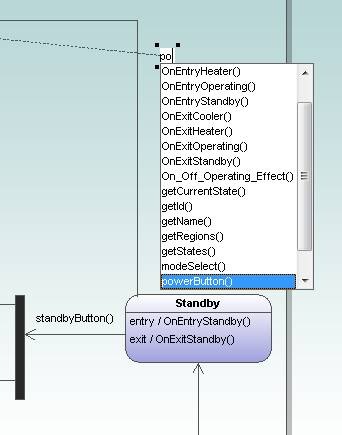 Our completed revision to the model with the new transition from Standby to Off looks like this:
Our completed revision to the model with the new transition from Standby to Off looks like this:  After regenerating the Java code and compiling the new version, we can run the Tester application again. The Debug output message window shows that the system entered Standby in Event 3. Event 4, activation of the Power button, now sets the state to Off.
After regenerating the Java code and compiling the new version, we can run the Tester application again. The Debug output message window shows that the system entered Standby in Event 3. Event 4, activation of the Power button, now sets the state to Off. 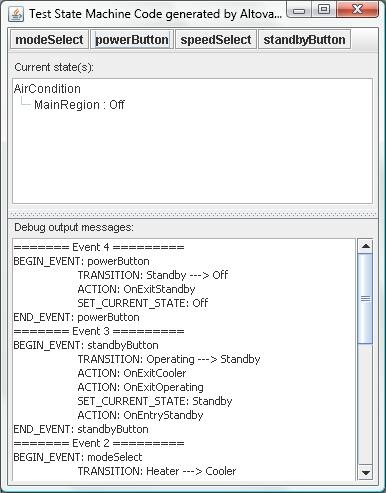 Find out for yourself how you can enhance the logic of your own state machine diagrams with Altova UModel – download a free 30-day trial today!
Find out for yourself how you can enhance the logic of your own state machine diagrams with Altova UModel – download a free 30-day trial today!
Expandable If-Else Works like a Switch Statement in MapForce
In response to several user requests, the if-else component in MapForce has been enhanced in MapForce 2011 Release 2 to accommodate any number of variables. This feature, which is equivalent to a switch statement in many programming languages, enables you to easily control the flow of data in a mapping project by matching a value to a selected criterion. For example, the screenshot below shows the if-then component used in combination with other components to analyze temperature data and produce the following results:
Using the StyleVision Combo Box to Support Data Visibility Requirements
Altova is always on the lookout for ways to help software developers and architects meet the challenges presented by the increasingly complex collection, storage and retrieval requirements of end users. In fact, we recently enhanced the functionality of the combo box in StyleVision to provide developers with additional flexibility around collecting and populating data. There are three ways to define the items in a combo box and their associated XML values – automatically based on a valid schema, manually with a list of populated values and dynamically with an XPath expression. In the latter two scenarios, the value that appears to the end user can be different than the value that will populate the file or database. This feature is particularly useful in cases where the “meaning” of the underlying data isn’t obvious or intelligible to an end user (e.g., a seven digit part number). The values in a combo box can be automatically populated with enumerations from a valid schema. In this case the value that appears to the end user is identical to the XML value that will populate the file or database.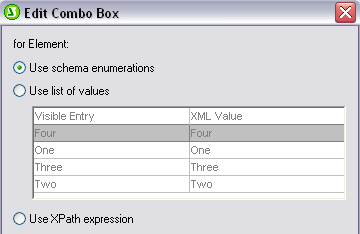 The functionality is perfect in cases where the elements in the schema provide an accurate reflection of the data content as understood by multiple stakeholders (e.g., end user selects Four to indicate group assignment, which populates the file with the XML value Four). Developers can also populate the combo box manually, defining both the value that appears to the end user and the XML value that will populate the file or database. These values do not need to be the same. So, for example, an end user can select Acme Dishwasher, Stainless while a complex product code populates the file or database used to generate the purchase order. This is an especially useful for collecting standardized data using organization or department-specific taxonomies and supporting multi-lingual applications.
The functionality is perfect in cases where the elements in the schema provide an accurate reflection of the data content as understood by multiple stakeholders (e.g., end user selects Four to indicate group assignment, which populates the file with the XML value Four). Developers can also populate the combo box manually, defining both the value that appears to the end user and the XML value that will populate the file or database. These values do not need to be the same. So, for example, an end user can select Acme Dishwasher, Stainless while a complex product code populates the file or database used to generate the purchase order. This is an especially useful for collecting standardized data using organization or department-specific taxonomies and supporting multi-lingual applications.  Finally, combo boxes can be populated dynamically via XPath expression. Use the same XPath expression to define the values that the end user sees as well as their associated XML values or use different XPath expressions to identify discrete values. If you use different XPath expressions the values the end user sees and their XML values are automatically mapped to one another. In the example below, the end user is prompted to select the group to which he is currently assigned (one, two, three or four). However the group number (not the name) will populate the database. Please note that the values the end user sees could be sorted in alphabetical (or numerical) order if the Sort Values in Authentic box were to be checked.
Finally, combo boxes can be populated dynamically via XPath expression. Use the same XPath expression to define the values that the end user sees as well as their associated XML values or use different XPath expressions to identify discrete values. If you use different XPath expressions the values the end user sees and their XML values are automatically mapped to one another. In the example below, the end user is prompted to select the group to which he is currently assigned (one, two, three or four). However the group number (not the name) will populate the database. Please note that the values the end user sees could be sorted in alphabetical (or numerical) order if the Sort Values in Authentic box were to be checked. 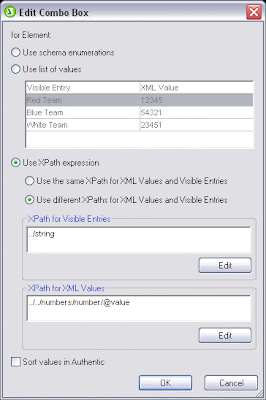 The XPath expressions above produce the output below – the end user selects “Two” but a numeric value is saved to the XML document.
The XPath expressions above produce the output below – the end user selects “Two” but a numeric value is saved to the XML document.  The combo box – particularly one that supports the differentiation of values visible to the end user and those that actually populate the database or file – is an invaluable resource in the design of electronic forms. StyleVision automatically generates the stylesheet for an electronic form along with those for HTML, PDF, Word 20007+ and RTF from your template. The Authentic eForm provides an interface for end users to enter and edit XML or database data and is viewable in Authentic View, Altova’s free graphical XML document editor. Have you used enhanced combo box functionality to solve a data entry or population issue? Share it with our active community of StyleVision users by posting to our Facebook wall, commenting here on our blog or joining a discussion in our User Forum on our Website!
The combo box – particularly one that supports the differentiation of values visible to the end user and those that actually populate the database or file – is an invaluable resource in the design of electronic forms. StyleVision automatically generates the stylesheet for an electronic form along with those for HTML, PDF, Word 20007+ and RTF from your template. The Authentic eForm provides an interface for end users to enter and edit XML or database data and is viewable in Authentic View, Altova’s free graphical XML document editor. Have you used enhanced combo box functionality to solve a data entry or population issue? Share it with our active community of StyleVision users by posting to our Facebook wall, commenting here on our blog or joining a discussion in our User Forum on our Website!
Software Testing for State Machines
Many varieties of software testing have gained prominence as developers search for ways to improve quality and meet project deadlines – code review, unit testing, regression testing, beta testing, test-driven development, and more. Regardless of a project’s goals or the source code language employed, it’s well accepted that the earlier a defect is found, the easier, cheaper, and more rapidly it can be fixed. Code generation from UML state machine diagrams, a new feature introduced in Altova UModel 2011 Release 2, can be used to validate conceptual logic very early in project development. Real-world design in a state machine diagram An example included with UModel provides a simple and realistic state machine diagram with a small test application you can run to see for yourself how easily it can be to test the logic of a design. The state machine diagram in the AirCondition.ump project in the UModel 2011 examples folder describes the operation of a typical heating and air conditioning system.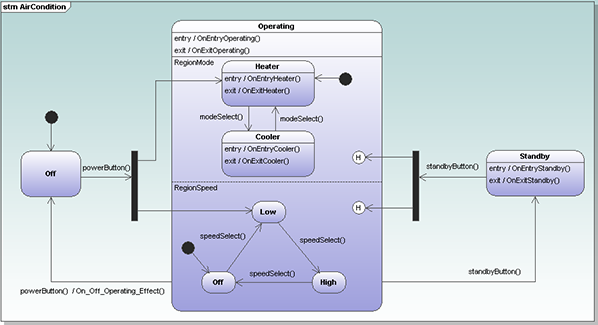 The system includes a power button shown on the left side in the transition from the Off state, a modeSelect function that selects heating or cooling, a speedSelect function for the fan, and a standby button that puts the system in the standby mode shown on the right. The example project folder includes all the code generated for the diagram by UModel in Java, C#, and Visual Basic. To try out the Java version, all we have to do is use the command javac STMTester.java to compile the code and java STMTester to run it. The tester application displays a simulated control panel with information windows about the heating and air conditioning unit. The operating buttons appear along the top, the current state is described in the first window, and output messages generated by changes in the system appear in the second window.
The system includes a power button shown on the left side in the transition from the Off state, a modeSelect function that selects heating or cooling, a speedSelect function for the fan, and a standby button that puts the system in the standby mode shown on the right. The example project folder includes all the code generated for the diagram by UModel in Java, C#, and Visual Basic. To try out the Java version, all we have to do is use the command javac STMTester.java to compile the code and java STMTester to run it. The tester application displays a simulated control panel with information windows about the heating and air conditioning unit. The operating buttons appear along the top, the current state is described in the first window, and output messages generated by changes in the system appear in the second window. 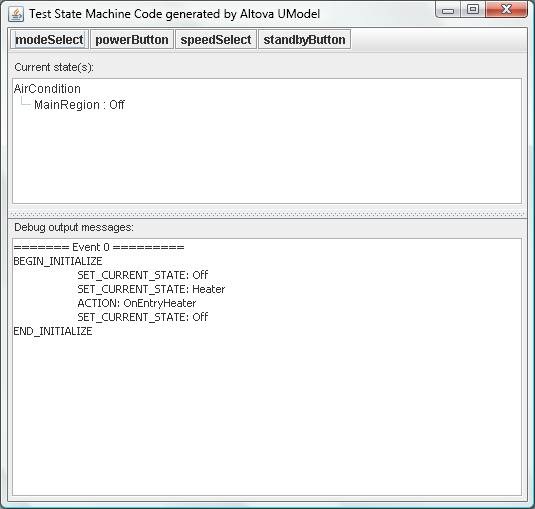 As shown above, the system initializes in the Off state, the mode is set to heater, and the fan is off. Before you operate the system, you might want to resize the control panel and state machine diagram to follow the actions of the tester application in the diagram itself, as shown in the reduced size image below.
As shown above, the system initializes in the Off state, the mode is set to heater, and the fan is off. Before you operate the system, you might want to resize the control panel and state machine diagram to follow the actions of the tester application in the diagram itself, as shown in the reduced size image below. 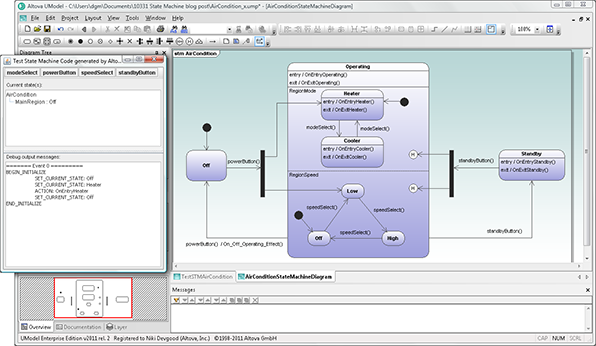 Operating the state machine When we click the powerButton, the Current state window is updated and a detailed description of the operations that occurred are listed as Event 1 in the Debug output messages window.
Operating the state machine When we click the powerButton, the Current state window is updated and a detailed description of the operations that occurred are listed as Event 1 in the Debug output messages window. 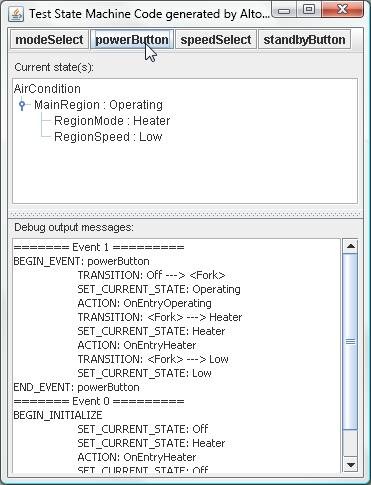 If it’s a hot day, we might want to change the mode to Cooling and increase the fan speed, which we can do by clicking the modeSelect and speedSelect buttons. The Current state window updates with each click, and Event 2 and Event 3 are added to the output messages window.
If it’s a hot day, we might want to change the mode to Cooling and increase the fan speed, which we can do by clicking the modeSelect and speedSelect buttons. The Current state window updates with each click, and Event 2 and Event 3 are added to the output messages window.  Now we can see how the tester application lets us fully exercise the logic of our state machine diagram by clicking every possible sequence of button selections to see if they produce the expected results. For instance if we put the unit in Standby mode (Event 4 below), then press speedSelect, we see in the output messages for Event 5 that no state change occurs in the substate named RegionSpeed. Compare Event 5 to Event 3 in the output messages window as shown below.
Now we can see how the tester application lets us fully exercise the logic of our state machine diagram by clicking every possible sequence of button selections to see if they produce the expected results. For instance if we put the unit in Standby mode (Event 4 below), then press speedSelect, we see in the output messages for Event 5 that no state change occurs in the substate named RegionSpeed. Compare Event 5 to Event 3 in the output messages window as shown below. 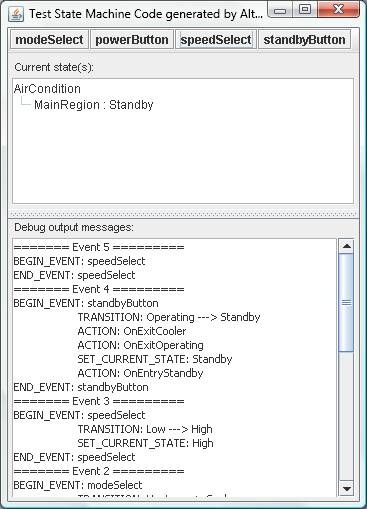 Now that the system is in Standby mode and we don’t need any heating or cooling, let’s save energy by pressing the Power button to turn it off.
Now that the system is in Standby mode and we don’t need any heating or cooling, let’s save energy by pressing the Power button to turn it off. 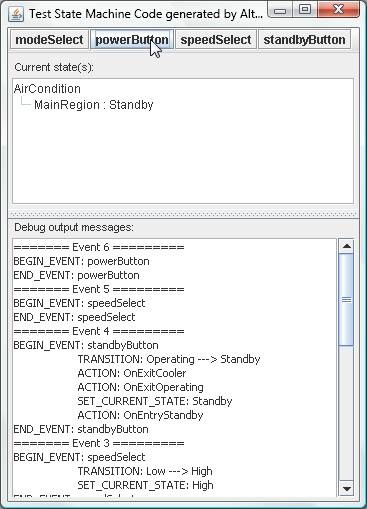 Wait a second – it looks like nothing happened. No transition took place in Event 6, and the Current state in the top window is still Standby! Looking back at the state machine diagram, we can see the only way out of Standby mode is to press the Standby button again. Is that really the behavior an average user would expect, that the Power button would not turn off the system from Standby mode?
Wait a second – it looks like nothing happened. No transition took place in Event 6, and the Current state in the top window is still Standby! Looking back at the state machine diagram, we can see the only way out of Standby mode is to press the Standby button again. Is that really the behavior an average user would expect, that the Power button would not turn off the system from Standby mode? 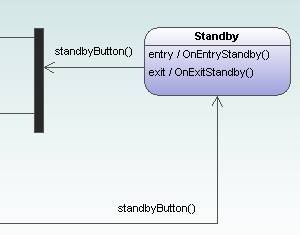 Just imagine how expensive this issue could be to fix if it was first identified much later in product development when the prototype was being tested by a regulatory agency! Here’s a challenge we’ll throw out on the table for our readers: how would you design another more direct route from the Standby state to the Off state? Testing your own state machines You can use the UModel state machine code generation example projects as templates to create test applications for your own designs. You will want to take advantage of the UModel feature that automatically creates operations in a class as you add operation names to transitions in your state machine.
Just imagine how expensive this issue could be to fix if it was first identified much later in product development when the prototype was being tested by a regulatory agency! Here’s a challenge we’ll throw out on the table for our readers: how would you design another more direct route from the Standby state to the Off state? Testing your own state machines You can use the UModel state machine code generation example projects as templates to create test applications for your own designs. You will want to take advantage of the UModel feature that automatically creates operations in a class as you add operation names to transitions in your state machine.  Also, the UModel Help system includes detailed information about code generation from state machine diagrams and also uses the AirCondition.ump project file as an example. Find out for yourself how you can improve project development by testing the logic of your own state machine diagrams with Altova UModel – download a free 30-day trial today!
Also, the UModel Help system includes detailed information about code generation from state machine diagrams and also uses the AirCondition.ump project file as an example. Find out for yourself how you can improve project development by testing the logic of your own state machine diagrams with Altova UModel – download a free 30-day trial today!
Harness the Power of Chained Transformations in MapForce
Altova MapForce includes the ability to define chained transformations. Chained transformations let you create complex mappings where the output of one mapping becomes the input to another. In other words, two or more components can be directly connected to a final target component.
Read more…
Hot off the Press!
The industry is abuzz with the latest news announcing our release of the MissionKit Version 2011 Release 2. The release is loaded with new features for chart and report creation, enhanced data mapping capabilities, new XML Schema editing functionality, support for the latest version of BPMN, and a really cool new feature for comparing and merging Microsoft® Word documents. Dr Dobb’s and SQL Server magazine are just a few of the industry publications and blogs that covered the launch.
Dr Dobb’s and SQL Server magazine are just a few of the industry publications and blogs that covered the launch. 
 Read what the industry is buzzing about and then download a free 30-day trial of the MissionKit and check out for yourself all the powerful new features now available in our suite of XML, database, and UML tools!
Read what the industry is buzzing about and then download a free 30-day trial of the MissionKit and check out for yourself all the powerful new features now available in our suite of XML, database, and UML tools!
Advanced Presentation and Formatting in StyleVision
The StyleVision stylesheet and report design tool has added a plethora of advanced functionality over the past several releases. In this post we’ll explore some of the advanced presentation and formatting capabilities that make this tool so powerful. Data visualization (e.g., charts and graphs) and other graphical elements are de rigueur these days. Whether it’s showing change over time via a simple bar graph, highlighting performance with an image from the art department, presenting market data with a candlestick chart or developing a gauge for dashboard reporting, organizations today demand the ability to include sophisticated graphics on all sorts of output – including Web sites. Altova StyleVision 2011r2 can help you meet these demands with advanced presentation and formatting capabilities. You can use StyleVision to generate graphical representations of XML, database, and XBRL data for output to eForms, PDF, HTML, RTF, and Word 2007+. Advanced formatting capabilities will enable you to create impressive charts, graphs and other data views that resonate with audiences. In addition to 2D and 3D bar and pie charts, you can create line, area, candlestick, and gauge charts for use on Web sites or printed materials. Overlay reports provide you with the ability to juxtapose two data sets such as opening, high, low, and closing share prices (candlestick chart) with daily share volume (bar chart) as pictured here.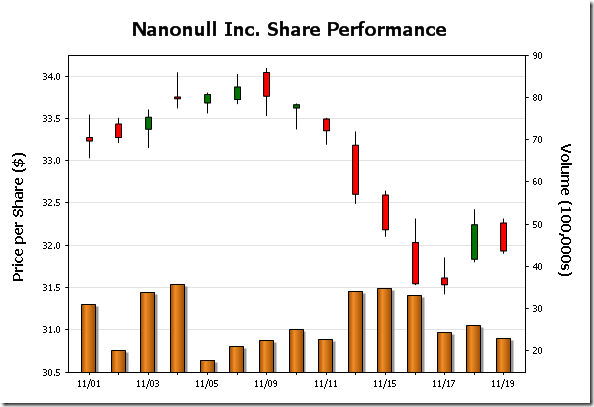 Comprehensive style attributes including colors, background images, legends, and even dynamic XPath settings provide you with complete control over how XML, database, and XBRL data are presented. Among pie chart attributes StyleVision users can select from, for example, are start angle, drop shadow, tilt (for 3D), color scheme (including user defined), and visibility of values, percentages, labels and legends.
Comprehensive style attributes including colors, background images, legends, and even dynamic XPath settings provide you with complete control over how XML, database, and XBRL data are presented. Among pie chart attributes StyleVision users can select from, for example, are start angle, drop shadow, tilt (for 3D), color scheme (including user defined), and visibility of values, percentages, labels and legends. 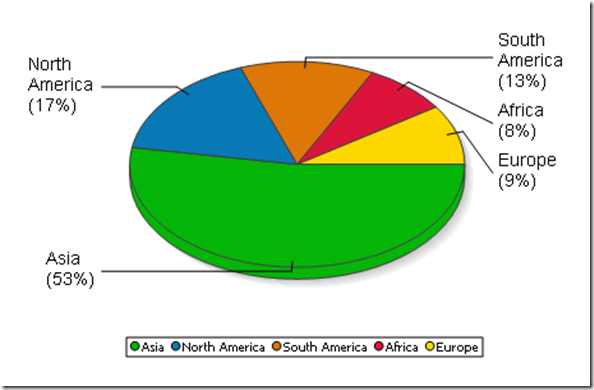 Adding background color and images is easy with drop down boxes – to achieve the yellow vertical gradient pictured in the overlay chart below simply go to All Settings under Appearance in the Chart Configuration dialog box, select Background Color in the Plot section of the General tab and select vertical gradient and the yellow color swatch from the drop down boxes.
Adding background color and images is easy with drop down boxes – to achieve the yellow vertical gradient pictured in the overlay chart below simply go to All Settings under Appearance in the Chart Configuration dialog box, select Background Color in the Plot section of the General tab and select vertical gradient and the yellow color swatch from the drop down boxes.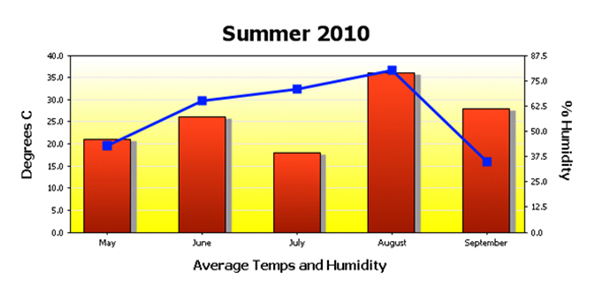 StyleVision even offers users the ability to design templates so that output can be modified dynamically based on end user input. Below is an eForm that presents information in English and German depending on which button is toggled – conditional statements associated with a variable declared at the $XML template control this. Please note that the formatting in the Date field changes as well.
StyleVision even offers users the ability to design templates so that output can be modified dynamically based on end user input. Below is an eForm that presents information in English and German depending on which button is toggled – conditional statements associated with a variable declared at the $XML template control this. Please note that the formatting in the Date field changes as well. 
 Keep in mind that any form that you would like to reproduce in StyleVision can be imported as a “blueprint,” a configurable image that serves as a template. This allows the designer to place text, input fields, and other design elements directly on the template and makes it easy to build an eForm identical to the original. With advanced presentation and formatting for charts and graphs Altova significantly extends the capabilities of StyleVision’s already powerful report builder – your designs are limited only by your imagination.
Keep in mind that any form that you would like to reproduce in StyleVision can be imported as a “blueprint,” a configurable image that serves as a template. This allows the designer to place text, input fields, and other design elements directly on the template and makes it easy to build an eForm identical to the original. With advanced presentation and formatting for charts and graphs Altova significantly extends the capabilities of StyleVision’s already powerful report builder – your designs are limited only by your imagination. 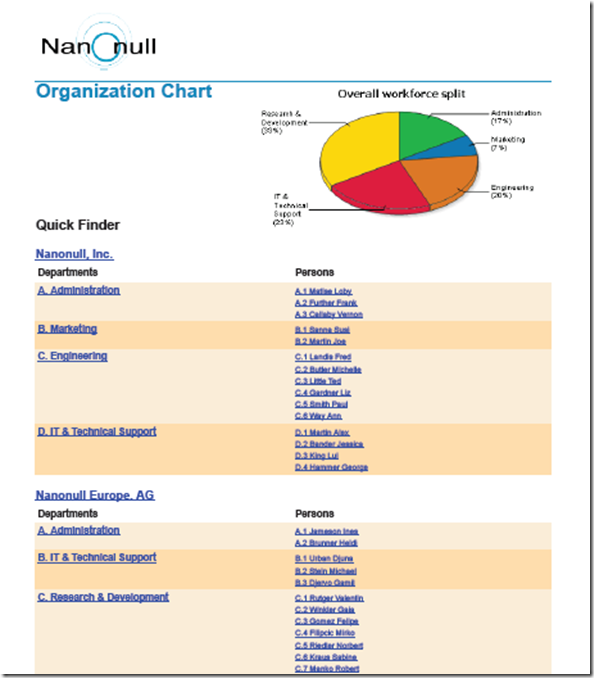 We’d love to hear how you are using these or other capabilities in developing your own projects. Please share your stories by posting to our Facebook wall or commenting here on our blog! If you haven’t tried StyleVision before, now is the time. Download a free, fully functional, 30-day trial from the Altova Web site now.
We’d love to hear how you are using these or other capabilities in developing your own projects. Please share your stories by posting to our Facebook wall or commenting here on our blog! If you haven’t tried StyleVision before, now is the time. Download a free, fully functional, 30-day trial from the Altova Web site now.
Now Generate Barcodes in StyleVision
We’re listening.Altova clients have been asking us when they would be able to include barcodes in their StyleVision templates and now they can! StyleVision 2011r2 users can generate barcodes with a single click and insert them into an SPS template for use in eForms, as well as HTML, RTF, PDF, and Word 2007+ output. This brings even more advanced functionality to stylesheet and report design for XML, database, and XBRL data in this unique tool. Simply click on Insert Barcode from the Insert menu, define the type from the Barcode4J library and add the value used to generate the pattern (“text”).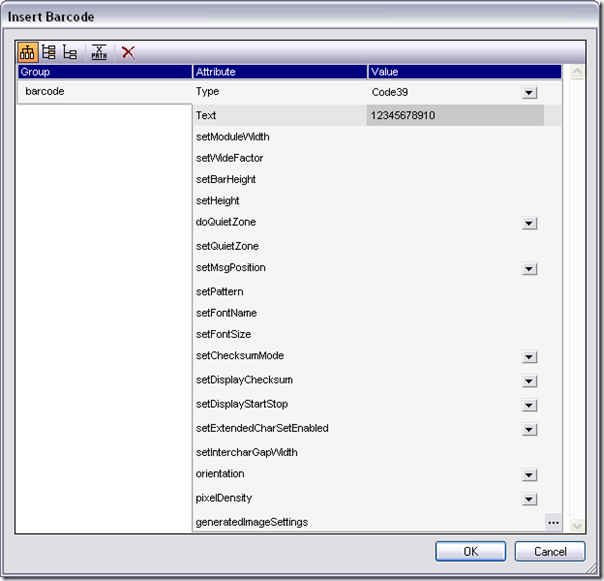
 StyleVision gives users complete control over the presentation and appearance of barcodes – other properties that can be controlled via the dialog box include size, alignment, colors and borders.
StyleVision gives users complete control over the presentation and appearance of barcodes – other properties that can be controlled via the dialog box include size, alignment, colors and borders. 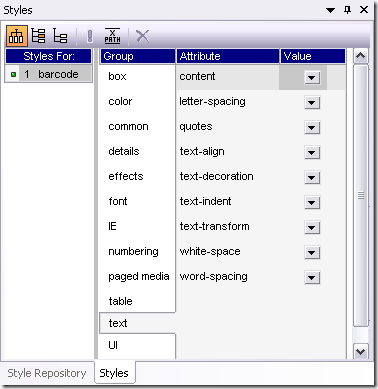 You can even use an XPath expression to assign a barcode to a property value.Altova is really excited about providing our clients with the ability to include barcodes in StyleVision-generated output. From larger companies supporting enterprise systems to smaller organizations looking to facilitate electronic data exchange without the use of middleware, StyleVision supports the goals of a broad range of users.Please note that a Java Runtime Environment 1.4 or later (32-bit or 64-bit as appropriate) must be installed to support this feature.
You can even use an XPath expression to assign a barcode to a property value.Altova is really excited about providing our clients with the ability to include barcodes in StyleVision-generated output. From larger companies supporting enterprise systems to smaller organizations looking to facilitate electronic data exchange without the use of middleware, StyleVision supports the goals of a broad range of users.Please note that a Java Runtime Environment 1.4 or later (32-bit or 64-bit as appropriate) must be installed to support this feature.
Creating XML from Relational Databases
Sometimes following an example someone else created is a good way to get a quick start on a project. The downside is you might miss a better, more efficient solution. In our recent post on XML in the Cloud, we used DatabaseSpy to connect to a local MySQL database and to the Amazon Relational Database Service in the cloud. We used the Concat( ) function in a SQL SELECT statement to create XML formatted output from non-XML data as shown below. Our SELECT statement was based on an example in the MySQL documentation on XML support. Let’s take a little deeper look at the problem this statement tries to address. You can copy a DatabaseSpy Results table like the one displayed above and paste it into an editing window in XMLSpy, but the Results table alone does not create a well-formed XML document. To be well formed according to the W3C definition, an XML document must contain a root element. All other elements and logical structures must nest within the root. You can also think of the root element as a wrapper around the entire XML content, the same way the element <city></city> encloses each line in our original results. A Better Way to Create XML from Relational Data We don’t need to manually edit the results to add a root element, nor do we need to adapt our already-complicated SQL query to add the root. DatabaseSpy lets us easily export well-formed XML documents from database tables that contain ordinary data like our cities table. In the DatabaseSpy Export dialog we can choose XML Structure as the output format, click the cities table to select it from the database hierarchy, and choose XMLSpy as the destination. The Preview section at the bottom of the Export dialog shows a view into the table contents.
Our SELECT statement was based on an example in the MySQL documentation on XML support. Let’s take a little deeper look at the problem this statement tries to address. You can copy a DatabaseSpy Results table like the one displayed above and paste it into an editing window in XMLSpy, but the Results table alone does not create a well-formed XML document. To be well formed according to the W3C definition, an XML document must contain a root element. All other elements and logical structures must nest within the root. You can also think of the root element as a wrapper around the entire XML content, the same way the element <city></city> encloses each line in our original results. A Better Way to Create XML from Relational Data We don’t need to manually edit the results to add a root element, nor do we need to adapt our already-complicated SQL query to add the root. DatabaseSpy lets us easily export well-formed XML documents from database tables that contain ordinary data like our cities table. In the DatabaseSpy Export dialog we can choose XML Structure as the output format, click the cities table to select it from the database hierarchy, and choose XMLSpy as the destination. The Preview section at the bottom of the Export dialog shows a view into the table contents.  When we click the Export button, DatabaseSpy formats the relational data with XML element names derived from the column names of the table and sends the resulting output directly to XMLSpy. The screenshot below shows a portion of the file in XMLSpy. The Message window at the bottom verifies the file is well formed.
When we click the Export button, DatabaseSpy formats the relational data with XML element names derived from the column names of the table and sends the resulting output directly to XMLSpy. The screenshot below shows a portion of the file in XMLSpy. The Message window at the bottom verifies the file is well formed.  Note that DatabaseSpy supplied the root element <Import name = “cities”> and added comments to describe the datatypes of the database table columns. And, we did not have to construct a SQL statement with a cumbersome Concat( ) function. We began this post to address the simple requirement for a root element to complete the output of the Concat ( ) function we described earlier. When real-world projects require converting from relational databases to XML, the requirements are likely to be much more complex. Altova XMLSpy connects directly to all popular databases to work with XML technologies and relational data. XMLSpy lets you easily create an XML Schema from a database structure, or create a database schema from an XML Schema. XMLSpy also includes advanced editors and debuggers for XQuery and XPath for XML stored directly in databases, along with specialized support for XML features in Microsoft SQL Server, IBM DB2, and Oracle databases. As more industries adopt and evolve XML-based standards for information interchange, a common need is to convert data stored in legacy databases to XML. Altova MapForce connects to databases and allows you to map and transform relational data to be compatible with one or more XML Schemas. You can use your mapping to perform a one-time data conversion, you can save and re-open your mapping to perform another conversion later, or you can instruct MapForce to generate royalty-free source code from your mapping to include in your own project when repeated conversions are required. If you’d like to see for yourself how well Altova tools can generate well-formatted XML from relational databases, download a free trial of the Altova MissionKit.
Note that DatabaseSpy supplied the root element <Import name = “cities”> and added comments to describe the datatypes of the database table columns. And, we did not have to construct a SQL statement with a cumbersome Concat( ) function. We began this post to address the simple requirement for a root element to complete the output of the Concat ( ) function we described earlier. When real-world projects require converting from relational databases to XML, the requirements are likely to be much more complex. Altova XMLSpy connects directly to all popular databases to work with XML technologies and relational data. XMLSpy lets you easily create an XML Schema from a database structure, or create a database schema from an XML Schema. XMLSpy also includes advanced editors and debuggers for XQuery and XPath for XML stored directly in databases, along with specialized support for XML features in Microsoft SQL Server, IBM DB2, and Oracle databases. As more industries adopt and evolve XML-based standards for information interchange, a common need is to convert data stored in legacy databases to XML. Altova MapForce connects to databases and allows you to map and transform relational data to be compatible with one or more XML Schemas. You can use your mapping to perform a one-time data conversion, you can save and re-open your mapping to perform another conversion later, or you can instruct MapForce to generate royalty-free source code from your mapping to include in your own project when repeated conversions are required. If you’d like to see for yourself how well Altova tools can generate well-formatted XML from relational databases, download a free trial of the Altova MissionKit.
New XML Schema Editing Tools in XMLSpy
Let’s take a look at some of the new features for working with XML Schemas in the latest release of XMLSpy.
Sorting in Schema View
When you’re working in the graphical XML Schema editor, you can now sort some or all of the schema components alphabetically with a single click. This is a huge time saver when you need to organize large schemas that have evolved over time and for understanding new schemas that come across your desk. Simply click the A-Z button in the Schema Overview window and select the sort options you prefer. Your components are instantly sorted in the graphical view…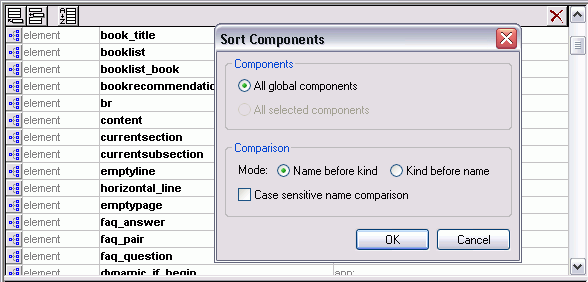 …and when you click over to Text View, the schema code itself is reordered and organized.
…and when you click over to Text View, the schema code itself is reordered and organized.
Schema Refactoring
Another new feature that’s invaluable when working with complex schemas or ones inherited from other developers is schema refactoring support. Taking advantage of XMLSpy’s powerful Find in Schemas functionality, you can quickly locate all the instances of a global element or type across a schema – and all imported and included schemas – and then rename that component in each place it occurs. This makes schema refactoring easy while ensuring the validity of all impacted schemas.
Intelligent Support for Changing Types
You may also find the need to change the type of an element or a base type, which previously meant reconfiguring all the facets associated with that component. This new feature gives you the option to preserve any facets or attributes that are compatible with the new type.
Customizable XML Schema Documentation
Another option schema developers have requested quite often is the ability to customize the comprehensive XML Schema documentation generated by XMLSpy. This is now possible via integration with StyleVision. The StyleVision stylesheet design tool provides countless advanced options for customizing the documentation templates, from adding your company’s logo and branding to changing the appearance and organization of the documentation completely. StyleVision integration also gives you the option to generate documentation in PDF in addition to the HTML, Word, and RTF output options available for the fixed documentation in XMLSpy. Here’s an an example of XML Schema documentation we customized for the fictional Nanonull corporation: XMLSpy 2011r2 also ships with several useful documentation templates that can be used as is or customized further in StyleVision:
XMLSpy 2011r2 also ships with several useful documentation templates that can be used as is or customized further in StyleVision:
To use a custom schema documentation template, you must have XMLSpy and StyleVision installed. If you are a MissionKit customer, you already have both tools and can take advantage of this feature and countless other options for working with XML Schema, from stylesheet and report design, to data mapping, and more. If you aren’t currently a StyleVision customer, grab a free trial from our Web site. The XBRL and WSDL documentation generated by XMLSpy may also be customized using StyleVision. As always, we rely on your input and feature requests when planning each release – please let us know what you think of these new features and what you’d like to see in the next product version by leaving a comment here on the blog.
Using Charts to Effectively Communicate Data
Altova first added support for charts and reporting the Altova MissionKit with the launch of Version 2011 last September. The v2011 reporting functionality includes options for line charts, 2D and 3D bar charts, 2D and 3D pie charts, round gauge and bar gauge charts. Here are a few examples:
Advanced chart features in v2011r2
Version 2011 Release 2 of the Altova MissionKit, introduced on February 16, adds an exciting group of enhancements to the chart and reporting features in XMLSpy, StyleVision, and DatabaseSpy. The chart design options and user interface work the same way in all three applications, so MissionKit users can work intuitively and productively as they move from processing XML data in XMLSpy, to preparing charts for a business intelligence report with StyleVision, and even when they create graphical displays directly from SQL query results in DatabaseSpy. The wide range of new customizable charting features introduced in version 2011 release 2 includes:
Now you can create attractive and informative charts to represent a wide variety of data sets without exporting data to a dedicated charting application. Charts created using the Altova MissionKit are not limited to any specific presentation technology – for instance you can use StyleVision to include charts in HTML, Microsoft Word, RTF, or PDF documents, or you can save charts created in DatabaseSpy in a variety of image formats at the custom resolution you specify. In this post we will show some examples of the new charts and features available in all three MissionKit reporting and charting applications – XMLSpy, StyleVision, and DatabaseSpy.
Stacked bar charts
Stacked bar charts are a variation on bar chart presentation and are especially useful when multiple ranges of data need to be illustrated. Stacked bar charts are also useful to more clearly illustrate data in a smaller area. The image below shows a stacked bar chart to illustrate the performance of a sales team by region over two years Note that the combined height of each stack in the Stacked Bar Chart represents the total sales over the two-year period for each Territory, since the sales for Last Year are added above the Year To Date numbers. Stacked bar charts complement regular bar charts and 3-D bar charts to offer users the greatest flexibility in illustrating SQL query results. If the user prefers horizontal bars, a checkbox labeled Draw X and Y exchanged in the Change Appearance tab selects that orientation.
Note that the combined height of each stack in the Stacked Bar Chart represents the total sales over the two-year period for each Territory, since the sales for Last Year are added above the Year To Date numbers. Stacked bar charts complement regular bar charts and 3-D bar charts to offer users the greatest flexibility in illustrating SQL query results. If the user prefers horizontal bars, a checkbox labeled Draw X and Y exchanged in the Change Appearance tab selects that orientation. 
 This orientation option is also available for other 2-D bar charts, line charts, area charts, and candlestick charts.
This orientation option is also available for other 2-D bar charts, line charts, area charts, and candlestick charts.
Area charts
Area charts are similar to line charts, with shading applied to make a more graphically appealing display. The area chart below shows a record of temperature and humidity changes by hour over the course of one day. Creative application of color can emphasize the point! To successfully build an area chart, the analyst must consider the values in each data category. As the area chart is constructed, each category forms an opaque layer on top of the layers for data retrieved previously. In the case illustrated above, Temperature was always a larger number than Humidity, so a SQL query was constructed in DatabaseSpy to retrieve the Temperature value before Humidity to prevent Temperature from acting like a curtain to hide the Humidity data. However, if the data columns appear in a sequence with values in increasing order, the last layer would overlap and hide all the preceding layers. In that case, the chart tab heading titled Select Data lets the user add and delete columns from the results to re-sequence the data correctly. The Select Data column also lets the user edit the names assigned to each column on the X-axis label.
To successfully build an area chart, the analyst must consider the values in each data category. As the area chart is constructed, each category forms an opaque layer on top of the layers for data retrieved previously. In the case illustrated above, Temperature was always a larger number than Humidity, so a SQL query was constructed in DatabaseSpy to retrieve the Temperature value before Humidity to prevent Temperature from acting like a curtain to hide the Humidity data. However, if the data columns appear in a sequence with values in increasing order, the last layer would overlap and hide all the preceding layers. In that case, the chart tab heading titled Select Data lets the user add and delete columns from the results to re-sequence the data correctly. The Select Data column also lets the user edit the names assigned to each column on the X-axis label.  As alternative solution, the Transparency option in the Change Appearance tab lets the user adjust color levels to allow hidden layers to show through.
As alternative solution, the Transparency option in the Change Appearance tab lets the user adjust color levels to allow hidden layers to show through.
Stacked area charts
As implied by their name, Stacked Area charts layer the columns of a data set to illustrate the overall sum of a data series. Stacked Area charts also eliminate the potential overlapping data problem that can occur with regular area charts. The chart below shows a table of air passenger revenue miles traveled by month, with individual regions for domestic and international travel. The Stacked Area chart creates a graphical representation of the total of Domestic and International miles, even though the total miles value was not part of the provided data. This is apparent at the top of the January entry, where the International region intersects the Y axis just below 600 (the original data showed 392 million Domestic miles and 181 million International miles, for a total of 573). A strategic data analyst will always consider the nature of the data to be reported when choosing any particular chart type. For instance in the weather example we used above, adding temperature and humidity values in a stacked bar chart would not be logical!
The Stacked Area chart creates a graphical representation of the total of Domestic and International miles, even though the total miles value was not part of the provided data. This is apparent at the top of the January entry, where the International region intersects the Y axis just below 600 (the original data showed 392 million Domestic miles and 181 million International miles, for a total of 573). A strategic data analyst will always consider the nature of the data to be reported when choosing any particular chart type. For instance in the weather example we used above, adding temperature and humidity values in a stacked bar chart would not be logical!
Candlestick charts
Candlestick charts were originally developed by a wealthy Japanese businessman who began trading at the local rice exchange around the year 1750. He kept records of the local market psychology, learning to boost his profits by carefully monitoring prices and not rushing into trades. Today, charts are used to represent financial data such as stock prices over a period of time. Every day the market is open, each stock has four relevant data points that can be rendered in a candlestick chart: the price at market opening, the price when the market closed, the high price during the day, and the low price during the day. Investors and financial analysts like to view these indicators to gauge the stock’s performance over a period of time. In the candlestick chart below, each solid bar represents the range between the opening and closing price and the thin vertical line through each bar shows the extent of the high and low prices for the day. In this version of the chart, following common convention, the color of each bar signals whether the stock was up or down for the day. If the bar is green, the stock was up for the day– it opened at the price indicated by the bottom of the bar and closed at the price indicated by the top. If the stock was down for the day, the bar is red and the symbolism is reversed – the stock opened at the price indicated at the top of the bar and closed at the price shown by the bottom. Numerous options are available to set line and fill colors, the Y-axis range and values, and more. Because they were intended to be printed in black and white, the original candlestick charts used empty bars to indicate the price increased and solid bars to indicate price decreases. The Altova MissionKit offers this option:
In this version of the chart, following common convention, the color of each bar signals whether the stock was up or down for the day. If the bar is green, the stock was up for the day– it opened at the price indicated by the bottom of the bar and closed at the price indicated by the top. If the stock was down for the day, the bar is red and the symbolism is reversed – the stock opened at the price indicated at the top of the bar and closed at the price shown by the bottom. Numerous options are available to set line and fill colors, the Y-axis range and values, and more. Because they were intended to be printed in black and white, the original candlestick charts used empty bars to indicate the price increased and solid bars to indicate price decreases. The Altova MissionKit offers this option:  Another candlestick chart variation omits the opening price and simply illustrates the range by a vertical line and the closing price by a horizontal line. This option is automatically supported when a data set only includes the high, low, and closing prices.
Another candlestick chart variation omits the opening price and simply illustrates the range by a vertical line and the closing price by a horizontal line. This option is automatically supported when a data set only includes the high, low, and closing prices. 
Chart overlays
The Overlays feature lets you combine multiple charts in a single image. Each overlay chart has unique settings and can even be generated from a separate data file. The image below shows a candlestick chart of a stock’s daily prices with the daily sales volume in a bar chart overlay.
Support for background images & color gradients
The ability to specify background color gradients and background images gives you even more flexibility for creating customized, eye-catching charts. Overlaying one chart on another lets you visualize multiple data sets with different Y-axes and types. The Change Appearance dialog lets users select a background image, as in the Winter Games chart above, or apply a background color gradient, as in the Summer 2010 chart below.
The Change Appearance dialog lets users select a background image, as in the Winter Games chart above, or apply a background color gradient, as in the Summer 2010 chart below. 
 If you’d like to see for yourself how easy it is to use Altova tools to create attractive charts from XML and database data, download a free trial of the Altova MissionKit.
If you’d like to see for yourself how easy it is to use Altova tools to create attractive charts from XML and database data, download a free trial of the Altova MissionKit.
Release 2 of Altova Software Version 2011
Organizing BPMN Diagrams with Layers
Altova UModel® 2011 allows users to organize diagrams into subgroups and place each group in an individual layer. Layers can be selectively hidden or exposed, providing a convenient way to decompose a BPMN diagram that describes a complex business process involving multiple departments or enterprises. This layers feature can be used with all diagram types supported by UModel and can clarify any complicated diagram, such as a use case with multiple actors or sequence diagram. You could even add a comments layer to collect feedback on a model from other project stakeholders. Here is a view of the UModel Layers helper window with a Default layer and Comments layer. When you circulate the model for review, the Design layer could be locked to allow changes only to the Comments layer. It’s easy to assign elements to a layer by using the right-click context menu.
It’s easy to assign elements to a layer by using the right-click context menu.  Later on we could choose to hide the Comments layer from view, while retaining the layer contents in the diagram to preserve a historical record of the reviewer comments.
Later on we could choose to hide the Comments layer from view, while retaining the layer contents in the diagram to preserve a historical record of the reviewer comments.  When diagramming a complex business process, we can create individual layers for each participant so each layer then provides a simplified view into a portion of the overall process. In this application, we would name layers by department or enterprise. Here is the UModel Layers helper window for an order processing diagram indicating the Sales Fulfillment layer is visible and the Finance layer is hidden:
When diagramming a complex business process, we can create individual layers for each participant so each layer then provides a simplified view into a portion of the overall process. In this application, we would name layers by department or enterprise. Here is the UModel Layers helper window for an order processing diagram indicating the Sales Fulfillment layer is visible and the Finance layer is hidden:  Here is the order processing diagram showing only the Sales Fulfillment layer:
Here is the order processing diagram showing only the Sales Fulfillment layer:  To depict the entire process, we can simply make all layers visible.
To depict the entire process, we can simply make all layers visible. 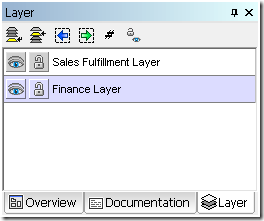 Here is the same diagram with both layers visible:
Here is the same diagram with both layers visible:  Find out for yourself how the UModel 2011 layers feature can enhance your BPMN diagrams – download a free trial today!
Find out for yourself how the UModel 2011 layers feature can enhance your BPMN diagrams – download a free trial today!
What Do Industry Authors Have to Say About Altova?
Authors of various industry reference books ranging from SOA and Web services to XML continue to use and recommended Altova tools. The latest update to the Cold Fusion book series – “ColdFusion 9 Developer Tutorial” is an update to John Farrar’s “ColdFusion 8 Developer Tutorial”. In this latest update, Farrar uses the Altova MissionKit, our suite of XML, database, and UML tools to do all his XML work for the book. According to Farrar, “I have a suite of tools from Altova and find they do what I want. I can create XPath, XML Schemas, and more from their tools and don’t ever feel the need to look for a new tool.” Farrar, a ColdFusion expert, teaches the basics of ColdFusion programming, application architecture, and object reuse. He then shows off a range of topics including AJAX library integration, RESTful Web Services, PDF creation and manipulation, and dynamically generated presentation files. So whether you need an overview of XML technologies, the latest information on working with ColdFusion, or want to delve into Web services, you’ll want to check out the Altova Reference Books page on our Web site.
Farrar, a ColdFusion expert, teaches the basics of ColdFusion programming, application architecture, and object reuse. He then shows off a range of topics including AJAX library integration, RESTful Web Services, PDF creation and manipulation, and dynamically generated presentation files. So whether you need an overview of XML technologies, the latest information on working with ColdFusion, or want to delve into Web services, you’ll want to check out the Altova Reference Books page on our Web site.
XML in the Cloud
Working with Altova Tools and the Amazon Relational Database Service (Amazon RDS)
More and more enterprises are discovering the advantages of implementing database applications in the cloud:
In this blog post we demonstrate how to connect to the Amazon Relational Database Service (Amazon RDS) and build a small database using Altova DatabaseSpy. Since the database Connection Wizard is consistent across the Altova MissionKit, you can connect the same way using XMLSpy, MapForce, or StyleVision. If you would like to follow the steps described below for yourself, you will need to sign up for an Amazon Web Services (AWS) account at: http://aws.amazon.com/rds/ You can also download a fully-functional free trial of the Altova MissionKit or any individual Altova application at: https://www.altova.com/download-trial/
Build a Local Prototype
The Amazon RDS is based on MySQL, so we will build a small local database in the MySQL Community Edition, then migrate to the Amazon RDS and test our database in the cloud. Although MySQL does not support XML as a data type for database columns, MySQL 5.1 and 6.0 do support some operations for XML data stored as text. For this exercise we will adapt and extend some of the MySQL XML examples at the MySQL reference resources listed here: http://dev.mysql.com/doc/refman/5.1/en/xml-functions.html http://dev.mysql.com/tech-resources/articles/xml-in-mysql5.1-6.0.html http://dev.mysql.com/tech-resources/articles/mysql-5.1-xml.html First, we launched DatabaseSpy and connected to our local MySQL Community Edition. We created a new data source named LocalPrototype, and created a new database schema that we named XMLtest. The DatabaseSpy Online Browser and Properties windows are shown here: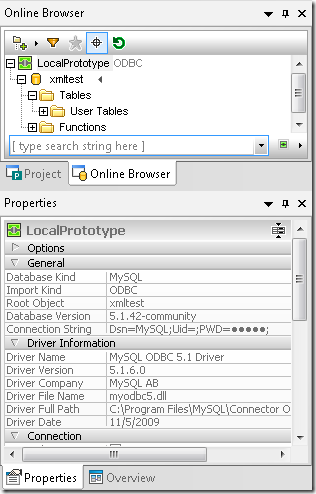 Next, we created two tables called books and cities and inserted data by following the examples in the MySQL documentation. Here is a DatabaseSpy Design View of our tables:
Next, we created two tables called books and cities and inserted data by following the examples in the MySQL documentation. Here is a DatabaseSpy Design View of our tables: 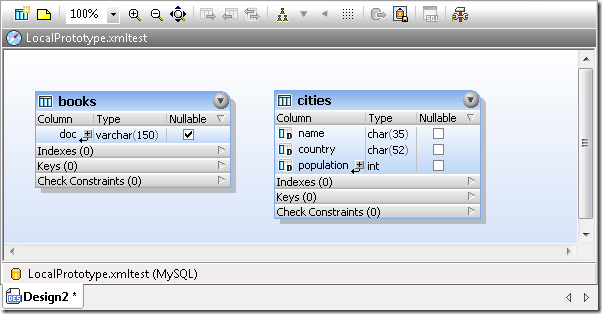 We can run select queries and display the contents of our tables in stacked results windows:
We can run select queries and display the contents of our tables in stacked results windows: 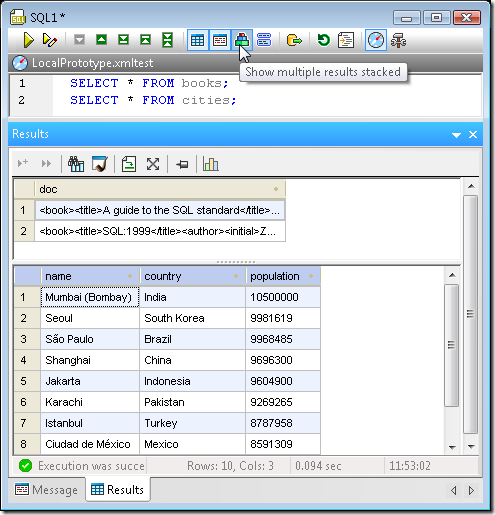 Note that the doc column of the books table contains XML data, although it was defined as varchar(150). MySQL supports two functions for working with XML in text fields, ExtractValue() and UpdateXML() that can operate on individual elements via XPath expressions. Below is a simple ExtractValue() query to return only the author initials from every row in the books table:
Note that the doc column of the books table contains XML data, although it was defined as varchar(150). MySQL supports two functions for working with XML in text fields, ExtractValue() and UpdateXML() that can operate on individual elements via XPath expressions. Below is a simple ExtractValue() query to return only the author initials from every row in the books table: 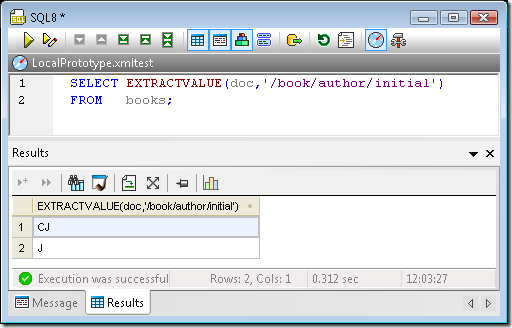 The UpdateXML() function can be used to modify the contents of individual XML elements using a SQL expression. In the screen shot below, the query on line 1 updates the every row of our books table, and the query on line 2 returns the new values:
The UpdateXML() function can be used to modify the contents of individual XML elements using a SQL expression. In the screen shot below, the query on line 1 updates the every row of our books table, and the query on line 2 returns the new values:  We can also use the Concat( ) function to add XML elements to non-XML data such as the cities table, as shown below:
We can also use the Concat( ) function to add XML elements to non-XML data such as the cities table, as shown below: 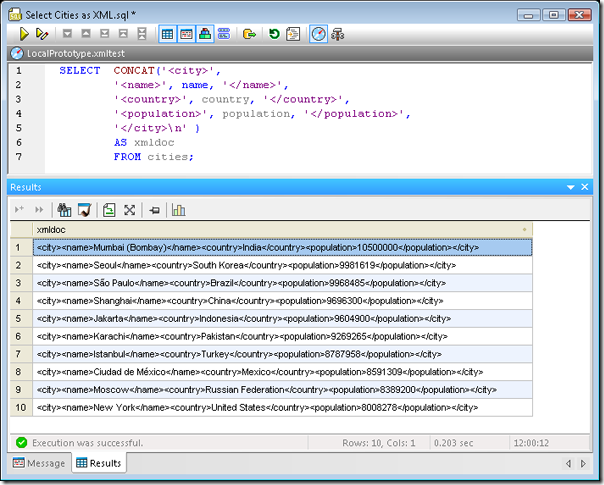 So far, our XML queries have operated on all rows of each table. To facilitate queries for a single row, it’s handy to add a column top the table to hold a unique row index. We can make a copy of our books table and add a column called id to hold the row index. The id column also makes a convenient foreign key to reference an individual XML document in our table from a row in another table. For instance, you might define one table to contain names of job candidates, with a foreign key to reference the XML-formatted resume for each candidate, stored in a separate table. You can use the SQL Editor in DatabaseSpy to generate a CREATE statement for the existing books table and edit it directly, or you can use the DatabaseSpy Design Editor to build the table graphically. (For more information, see the DatabaseSpy section of the Altova Web site.) Since we are planning to run the same queries later in the Amazon RDS, we combined a SQL CREATE statement and SQL INSERT statements into one script for the books2 table. The screen shot below shows part of the script for books2:
So far, our XML queries have operated on all rows of each table. To facilitate queries for a single row, it’s handy to add a column top the table to hold a unique row index. We can make a copy of our books table and add a column called id to hold the row index. The id column also makes a convenient foreign key to reference an individual XML document in our table from a row in another table. For instance, you might define one table to contain names of job candidates, with a foreign key to reference the XML-formatted resume for each candidate, stored in a separate table. You can use the SQL Editor in DatabaseSpy to generate a CREATE statement for the existing books table and edit it directly, or you can use the DatabaseSpy Design Editor to build the table graphically. (For more information, see the DatabaseSpy section of the Altova Web site.) Since we are planning to run the same queries later in the Amazon RDS, we combined a SQL CREATE statement and SQL INSERT statements into one script for the books2 table. The screen shot below shows part of the script for books2:  We can run a query of the books2 table that shows the unique id column for each row:
We can run a query of the books2 table that shows the unique id column for each row:  Now we can enhance our UpdateXML() and ExtractValue() queries to act on an individual row:
Now we can enhance our UpdateXML() and ExtractValue() queries to act on an individual row: 
 This gives us a good baseline set of examples to take to the cloud and test in an Amazon RDS.
This gives us a good baseline set of examples to take to the cloud and test in an Amazon RDS.
Connect DatabaseSpy to the Amazon RDS Cloud
After you follow the instructions at the AWS Management Console to create a database instance on Amazon RDS, the Connection Wizard makes it easy to get started with DatabaseSpy. Simply choose the MySQL option as shown here: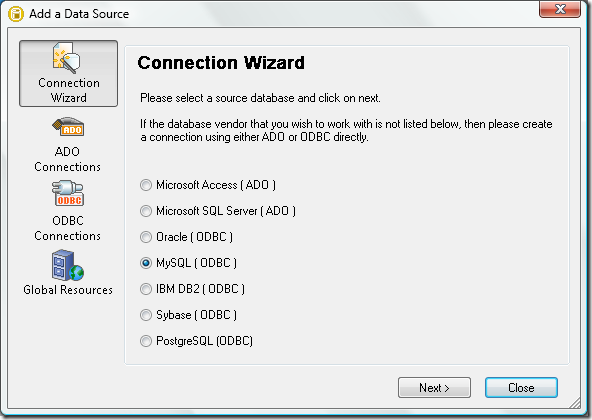 The first time you connect, you will need to create a new DSN. After the first time, you will be able to select the DSN from a list by choosing the “Use an existing Data Source Name” option. You can even use the original DSN when you go back to connect from XMLSpy, MapForce, or StyleVision.
The first time you connect, you will need to create a new DSN. After the first time, you will be able to select the DSN from a list by choosing the “Use an existing Data Source Name” option. You can even use the original DSN when you go back to connect from XMLSpy, MapForce, or StyleVision. 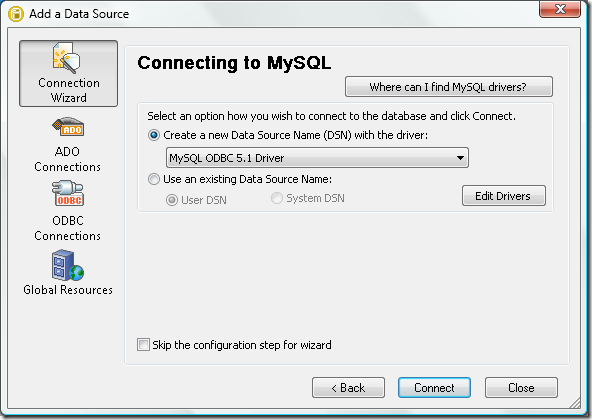 In the connector dialog, fill in the following information:
In the connector dialog, fill in the following information:
Migrate the Local Project to the Cloud
We can open each of our original table creation scripts and run them in the cloud database by re-assigning the execution target in the Properties window: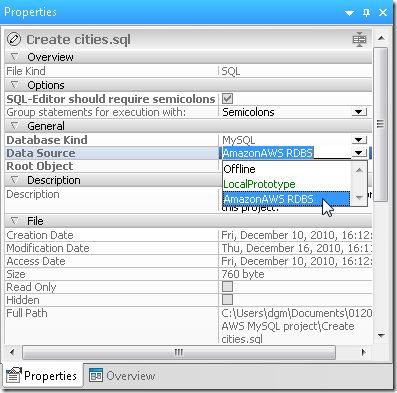 The gray Execution Target bar near the top of the SQL Editor window identifies the cloud Amazon RDS database as the query target:
The gray Execution Target bar near the top of the SQL Editor window identifies the cloud Amazon RDS database as the query target:  After similarly creating the books and books2 tables, we can run each of the SQL queries in the cloud database. ExtractValue() function for all rows example:
After similarly creating the books and books2 tables, we can run each of the SQL queries in the cloud database. ExtractValue() function for all rows example: 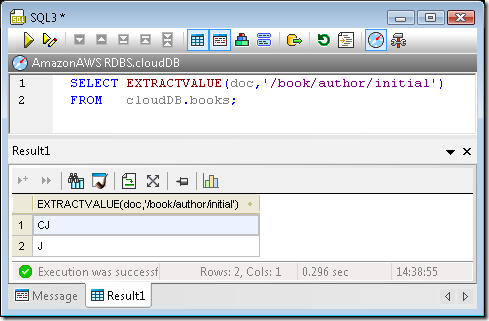 Concat() query to create XML output from non-XML data in a table:
Concat() query to create XML output from non-XML data in a table: 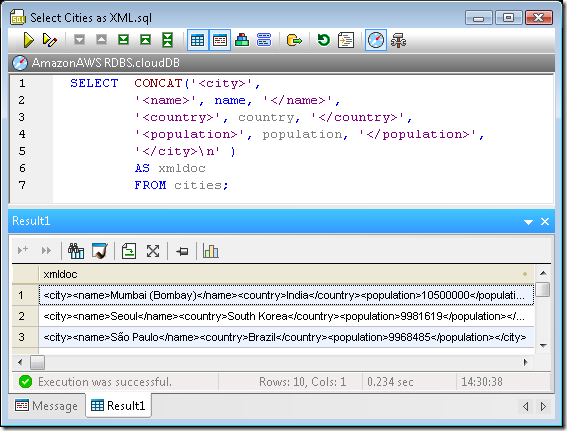 UpdateXML() example for a single row in a table.
UpdateXML() example for a single row in a table.  ExtractValue() for a single row:
ExtractValue() for a single row: 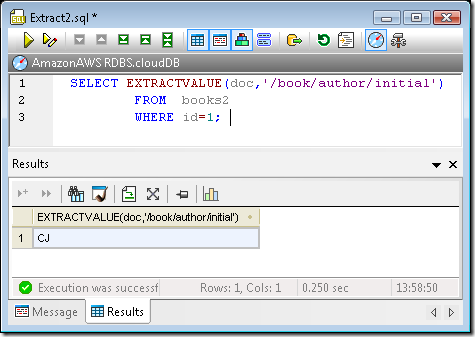
Conclusion
In every test we performed, Amazon RDS behaved exactly like the local MySQL community edition. This behavior it much more efficient for developers to build and test new cloud database applications, or enhancements to existing applications, without incurring the cost of cloud resources for development iterations. We also verified the operation of MySQL XML functions for XML data stored in text columns in the cloud databases. Our XML data was very limited – the text column in our books table was limited to 150 characters. However, MySQL lets you store much larger XML documents in a single column. Every table has a maximum row size of 65,535 bytes. Even if your table uses an index column, this means a varchar column for one XML entry could be over 64k bytes. If you need to store even larger XML documents, MySQL offers MediumText and LongText data types, similar to BLOBs. MediumText can hold over 16 million single-byte characters and LongText can hold up to 4 GB. Although not illustrated in this blog post, we have successfully tested ExtractValue() and UpdateXML() functions with MediumText and LongText data types. When you need to store XML data files that large, writing XPath expressions to resolve individual elements can become a development challenge. The XPath Analyzer included with XMLSpy is an invaluable tool that facilitates the testing and debugging of XPath 1.0 and 2.0 expressions. As you type an XPath expression into the analyzer, XMLSpy evaluates it and returns the resulting node set in real time. This can save hours of debugging time spent trying to understand and track down XPath problems. In future blog posts we’ll explore other ways XMLSpy, MapForce, DiffDog, and DatabaseSpy can help developers accelerate creation of cloud application with Amazon RDS. We look forward to seeing you back soon! If you’d like to see for yourself how well Altova tools work with Amazon RDS, download a free trial of the Altova MissionKit.
v2011 Service Pack 1 Available
Service Pack 1 of Altova’s Version 2011 product line is now available for download on our Web site. SP1 includes helpful bug fixes and other enhancements and is a free update for all v2011 license holders, as well as any customer with a valid Support and Maintenance Package. Update to SP1 here, and if you haven’t upgraded to v2011 yet, you can catch up on all the new features here.
New StyleVision Training
We are excited to announce the latest updates to our StyleVision online training course, which will help you easily come up to speed on the new reporting and chart creation functionality added in Version 2011, as well as how to create a StyleVision design (.SPS) based on an existing XSLT stylesheet. The final chapter in the course covers scripting, another advanced feature added in v2011. Access this chapter to learn how the scripting and toolbar editor helps you add flexibility and interactivity to the Authentic eForms you design in StyleVision. After an overview of the scripting capabilities, you’ll practice inserting macros, adding custom toolbar buttons and event handlers, and adding forms to your design.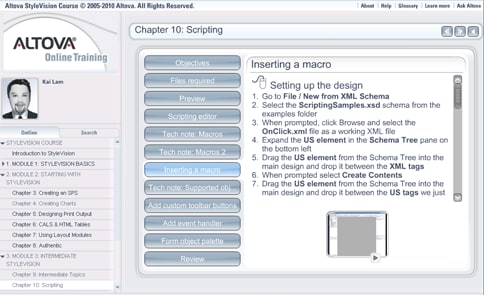 Like all Altova Online Training courses, the StyleVision modules are available on demand and are completely free. If you’re not a StyleVision or MissionKit customer, you can download a fully functional free trial before starting the training. We rely on your feedback and suggestions to update our online training classes and deliver the content you need most for your day-to-day work. Please let us know what you think of the new StyleVision chapters!
Like all Altova Online Training courses, the StyleVision modules are available on demand and are completely free. If you’re not a StyleVision or MissionKit customer, you can download a fully functional free trial before starting the training. We rely on your feedback and suggestions to update our online training classes and deliver the content you need most for your day-to-day work. Please let us know what you think of the new StyleVision chapters!